Niigata's Murakami City: Enjoy Fun Events, Sightseeing, and Local Cuisine!
We use cookies to improve our contents. Check the detail and update your settings here .
We use cookies to improve our services.
For more details, please click here .

- Change setting
- Food & Drink
- Accommodation
- Things To Do
- All the categories
Transportation
- Weather & Seasons
- Long-Term Stay
- Travel Tips
- Event Tickets
- About MATCHA
- Company Profile
- Things To Do in Ibaraki
- Food & Drink in Ibaraki
- MATCHA Special Features

Ibaraki: 27 Things to Do, Food, and Travel Tips for 2024

Ibaraki Prefecture, located near Tokyo, is famous for its mountains, flower gardens, and ocean views. This article introduces 27 fun things to do in Ibaraki, tips for visiting famous locations such as Hitachi Seaside Park, hidden gems, local cuisine, and access routes.
Ibaraki: The Perfect Day Trip Destination from Tokyo
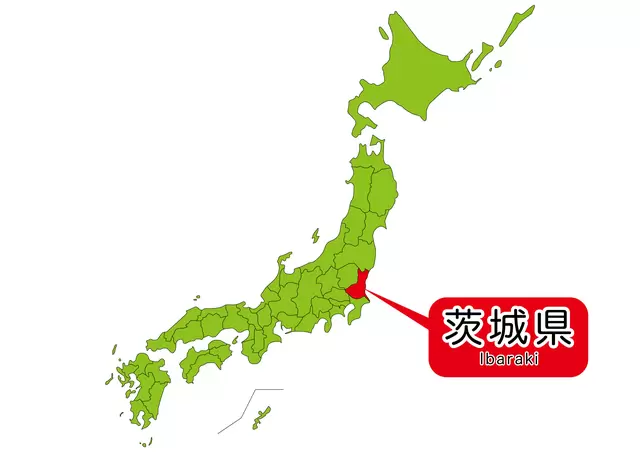
Photo by Pixta
Ibaraki is located north of Tokyo, bordering Chiba, Saitama, Tochigi, and Fukushima prefectures. It is the 11th largest prefecture in Japan, with a population of around 2.84 million. Mito City is the prefectural capital.
Ibaraki: Top Things to Do and Famous Places to Visit
1. Hitachi Seaside Park 2. Kairakuen Garden 3. Mito Castle 4. Oarai Isosaki Shrine 5. Sakatsura Isosaki Shrine 6. Kasama Inari Shrine 7. Hoshiimo Shrine 8. Kashima Jingu Grand Shrine 9. Mount Tsukuba 10. Ushiku Daibutsu (Giant Buddha Statue) 11. Ryujin Suspension Bridge 12. Nakaminato Fish Market 13. Fukuroda Falls 14. Tsukuba-Kasumigaura Ring-Ring Road 15. Suigo Itako Iris Garden 16. Oiwa Shrine 17. Ibaraki Prefectural Museum of History 18. Amabiki Kannon Temple: Beautiful Hydrangeas! 19. Hananuki Gorge: A famous Fall Foliage Spot 20. Hitachi Station: Splendid Architecture! 21. Osugi Shrine 22. Tsuchiura All Japan Fireworks Competition 23. Tsukuba Space Center Ibaraki Food and Souvenirs 24. A Must-Try in Ibaraki! Hitachi Beef 25. Japanese Sweet Potato Confections - The Latest Hit Souvenir! 26. A Local Delicacy: Monkfish Hot Pot (Anko Nabe) 27. Hitachi Aki-Soba Noodles How to Access Ibaraki: Airplane, JR Lines, and Rental Car
1. Hitachi Seaside Park

Hitachi Seaside Park is one of the most famous spots in the prefecture.
It is located in Hitachinaka City by the Pacific Ocean. From JR Katsuta Station, ride the bus departing from the east gate to bus stop No. 2. It is a 15-minute ride to Kaihin Koen West Entrance (Nishi-guchi) bus stop and 20 minutes to Kaihin Koen South Entrance (Minami-guchi) bus stop.

Hitachi Seaside Park
2. Kairakuen Garden

Kairakuen , located in the prefectural capital of Mito City, is one of the three major gardens in Japan. From Mito Station, it is a 20-minute bus ride to the facility.

Kairakuen Garden
3. Mito Castle

Mito Castle , situated north of Mito Station, was the former residence of the Mito Tokugawa family, second in status to the Tokugawa shogunate family. It ranks among the top 100 Japanese castles chosen by experts.

Mito Castle Ruins
4. Oarai Isosaki Shrine
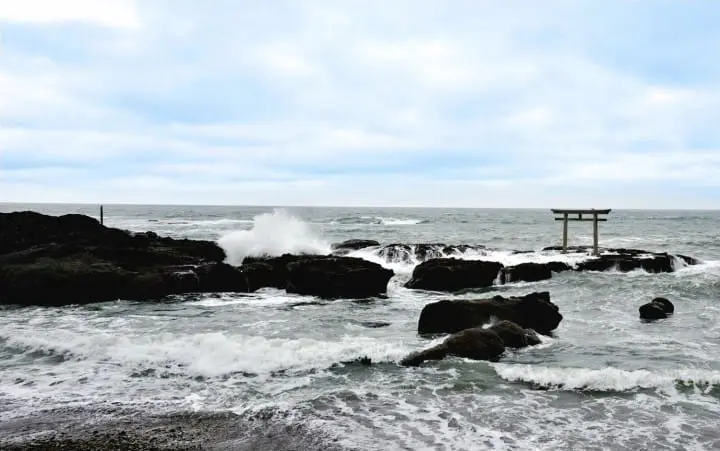
While there are many torii (gateway to a Shinto shrine) standing in oceans and lakes, the torii at Oarai Isosaki Shrine may be the most mystical.
It is also known as a place to view the sunrise, with many people gathering to snap photos of the sun rising from the horizon and above the torii.

Oarai Isosaki Shrine
5. Sakatsura Isosaki Shrine

Sakatsura Isosaki Shrine is located on a hill near the Isosaki fishing port.
Sakatsura Isosaki and Oarai shrines are said to be related, with shrine-goers worshiping the same deities.
The row of camelia trees by the approach is designated as a natural monument by the prefecture. When the flowers bloom in March, they fill the grounds with exceptional beauty.
Address: Ibaraki, Hitachinaka, Isozaki-cho 4607-2 Official Website: https://sakatura.org/ (Japanese)
6. Kasama Inari Shrine

More than 3 million people visit Kasama Inari Shrine , ranked among Japan's top three Inari shrines, to pray annually for prosperous business or a rich harvest.
During the Kiku Matsuri (Chrysanthemum Festival), held from mid-October to late November, the number of visitors comes close to the hatsumode (first shrine visit) season in the new year.
Address: Ibaraki, Kasama, Kasama 1 Official Website: http://www.kasama.or.jp/eng/index.html
7. Hoshiimo Shrine

Hoshiimo Shrine , located in Hitachinaka City, is famous for its row of golden torii.
The shrine's name comes from hoshi-imo (dried sweet potato), a signature Ibaraki product, and hoshii mono, which means "things that I want" in Japanese. It might be fun to visit this shrine, where visitors pray to fulfill their wishes.
Address: Ibaraki, Hitachinaka, Ajigaura-cho 172-2 Official Website: https://horide-hachiman.com/ (Japanese)
8. Kashima Jingu Grand Shrine
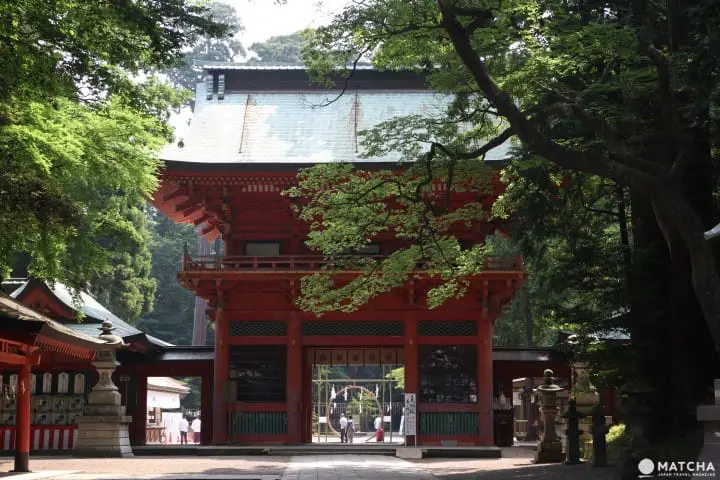
Kashima Jingu , which boasts a rich history, is often paired with Katori Shrine in Chiba Prefecture. Seven buildings, including the honden (main shrine building), haiden (prayer hall), and romon (tower gate entrance), are designated as national important cultural properties.

Kashima Jingu Shrine
9. Mount Tsukuba
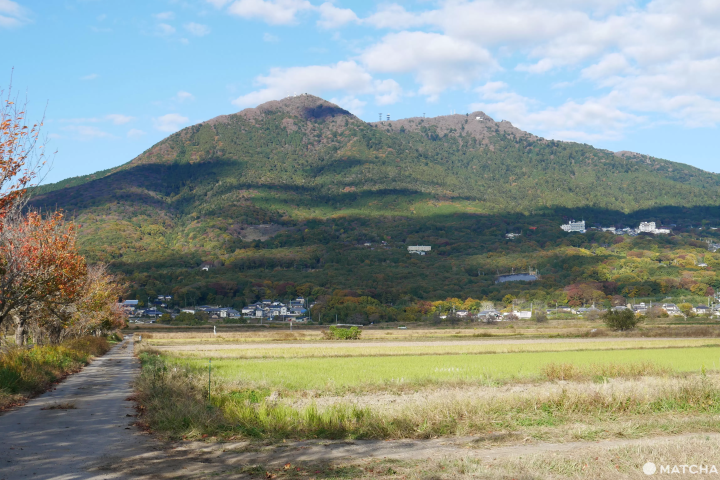
Mount Tsukuba , one of the prominent mountains in the Kanto region, is listed among the "100 Famous Japanese Mountains."

Mount Tsukuba
10. Ushiku Daibutsu (Giant Buddha Statue)

Ushiku Daibutsu is Japan's tallest bronze Buddha statue.
The inside of the statue is divided into various rooms, and visitors can see the Kanto Plain from the observation deck on the fifth floor. When the weather permits, Tokyo Skytree®︎ and Mt. Fuji can be viewed in the distance. There is also a zoo and a souvenir shop on the grounds.

Ushiku Daibutsu
11. Ryujin Suspension Bridge

Photo by Pixta Those looking for thrills should visit the Ryujin Suspension Bridge in Hitachiota City.
The bridge, which is 446 meters long and 100 meters high, is a prominent spot for bungee jumpers.

Ryujin Suspension Bridge
12. Nakaminato Fish Market
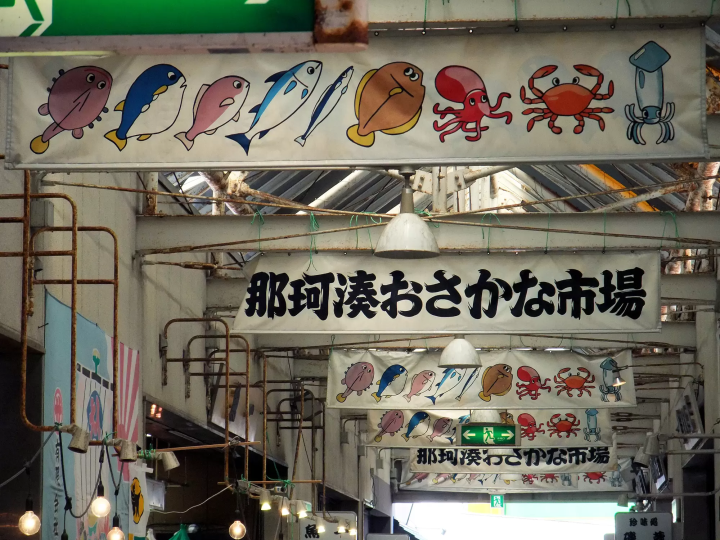
The Ibaraki coast is where the Kuroshio and Oyashio currents meet, making it a fertile fishing ground. As a result, the prefecture is blessed with abundant seafood.

Nakaminato Fish Market
13. Fukuroda Falls
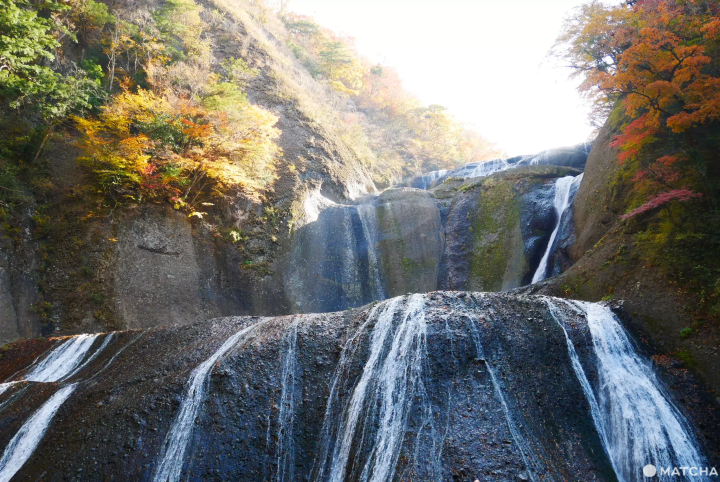
Fukuroda Falls is one of Japan's three most famous waterfalls.

Fukuroda Falls
14. Tsukuba-Kasumigaura Ring-Ring Road

Tsukuba-Kasumigaura Ring-Ring Road is a cycling course running through cities such as Tsukuba, Tsuchiura, Kasumigaura, Sakuragawa, and Itako. The total length is about 180 kilometers.
Everyone, from beginners to advanced cyclists, can have fun on this course.
Course: Old Tsukuba Railway Course/ Lake Kasumigaura Course Official Website: https://www.ringringroad.com/ (Japanese)
15. Suigo Itako Iris Garden
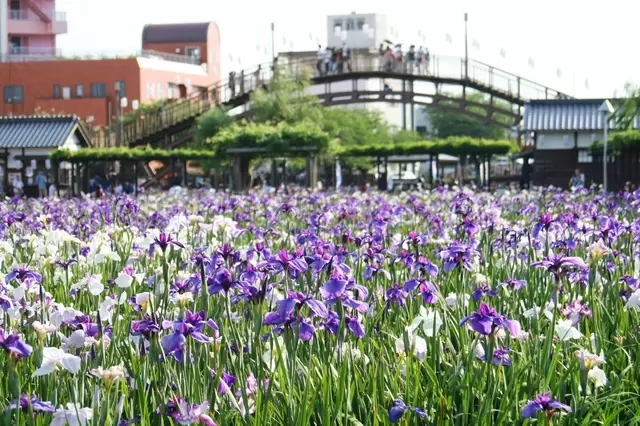
Suigo Itako Iris Garden boasts around 500 types of irises, with a total of one million flowers.
Suigo Itako Iris Festival is held from late May to late July when the flowers are in full bloom. Spectators will be greeted with illuminations and live performances.

Suigo Itako Iris Garden
16. Oiwa Shrine

Oiwa Shrine has more than 300 years of history.
Mount Oiwa, where the shrine is located, is considered a sacred peak. It is also listed in the "Hitachi no Kuni Fudoki," the oldest book in Japan.
It is said that the lords of the Mito Domain, who ruled a part of modern-day Ibaraki, regularly visited this shrine.
Address: Ibaraki, Hitachi, Irishiken-cho 752 Official Website: https://www.oiwajinja.jp/ (Japanese)

17. Ibaraki Prefectural Museum of History
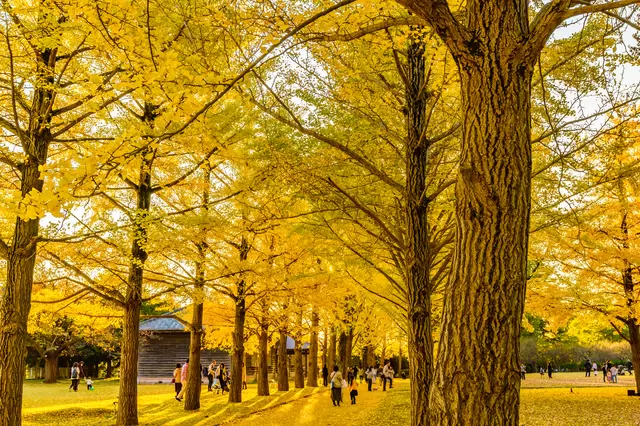
The row of ginkgo trees at the Ibaraki Prefectural Museum of History may not be well known, but it is an ideal place to enjoy the autumnal foliage in November.

Ibaraki Prefectural History Museum
18. Amabiki Kannon Temple

Picture courtesy of Pixta
Amabiki Kannon Temple (Amabiki-san Rakuho-ji) , located in Sakuragawa City, is a famed spot to view hydrangeas. Three thousand flowers bloom annually in June. After they are picked in July, the hydrangeas will float in the pond.

Amabiki Kannon Temple
19. Hananuki Gorge
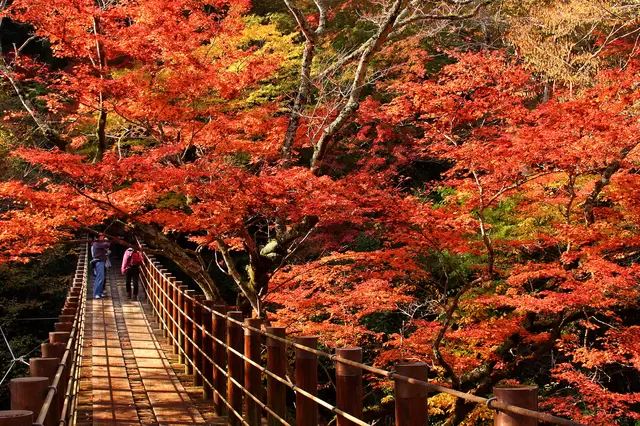
Hananuki Gorge in northern Ibaraki was put on the map after appearing in the Japanese TV drama "Hiyokko." This spot is renowned for its splendid view from Shiomi Falls Suspension Bridge during the autumnal foliage season.

Hananuki Gorge
20. Hitachi Station
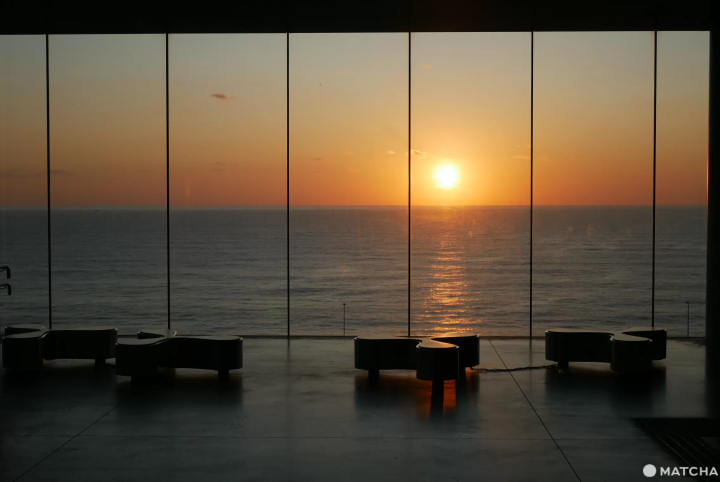
Hitachi Station was designed by Kazuyo Sejima, an internationally acclaimed architect born in Ibaraki.

Hitachi Station
21. Osugi Shrine

Osugi Shrine is located in Inashiki City. It is known as Yume-musubi Daimyojin, the only shrine in Japan to make dreams come true.

Osugi Shrine
22. Tsuchiura All Japan Fireworks Competition
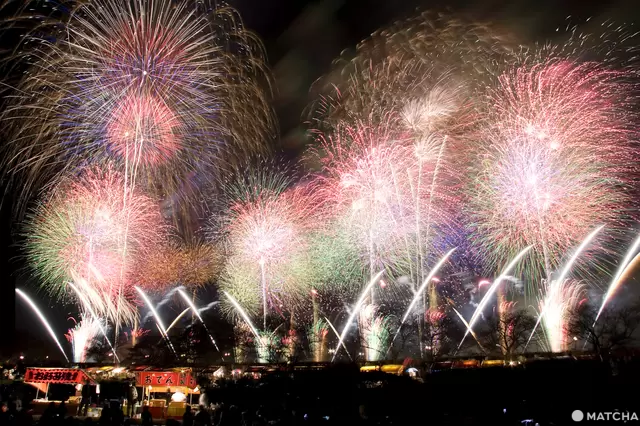
The All Japan Fireworks Competition , held annually in Tsuchiura , is one of the three major competitions in Japan.
The event started in 1925. Craftspeople from Japan gather to show their works among a massive crowd of spectators.
Venue: Near Gakuen Bridge at Sakura River/ Google Map Official Website: https://www.tsuchiura-hanabi.jp/ (Japanese)
23. Tsukuba Space Center

Tsukuba Space Center , located in Tsukuba City, is a research facility managed by the Japan Aerospace Exploration Agency (JAXA).

[Official] Japan Aerospace Exploration Agency Tsukuba Space Cente...
24. A Must-Try in Ibaraki! Hitachi Beef

Hitachi beef , ranked from A-4 quality grade and up, can only be raised by cattle breeders with the approval of Ibaraki Prefecture.
Various restaurants serve this celebrated beef, so give it a try if you have the chance!
25. Japanese Sweet Potato Confections - The Latest Hit Souvenir!
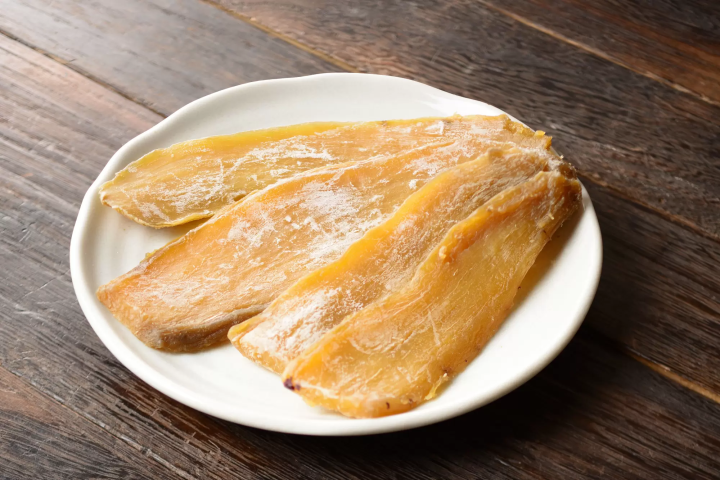
Satsuma-imo (sweet potato), known for its pleasant taste, is a major product of Ibaraki. It's no surprise that various confections are made with this root vegetable.
Hoshi-imo (dried sweet potato) is a longtime favorite among locals. There are also numerous dishes, including pies, ice creams, and yokan (gelatinous dessert) featuring this ingredient!
26. A Local Delicacy: Monkfish Hot Pot (Anko Nabe)

Monkfish hot pot is a local cuisine made with anglerfish (anko), which dwells in the deep sea.
Many parts of the fish can be used for this dish. Since it also contains a high percentage of collagen, it is said to have a skin-beautifying effect. Although monkfish hot pot is slightly expensive, it should not be missed on your visit to Ibaraki!
27. Hitachi Aki-Soba Noodles - An Autumn Specialty!
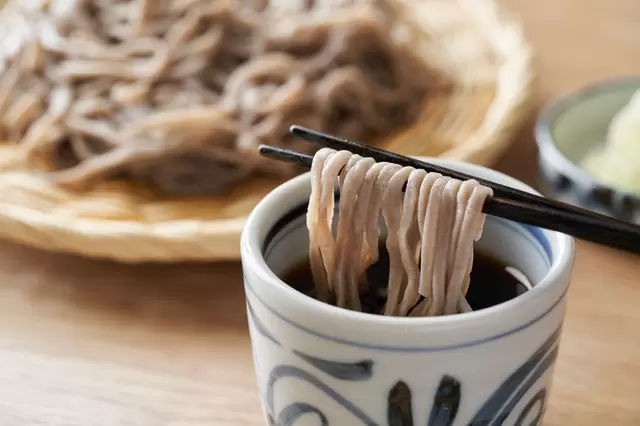
Hitachi Aki-Soba is locally-made buckwheat noodles from Hitachiota City.

Accessing Ibaraki: Airplane, JR Lines, and Rental Car
Depending on the departure point of your trip, there are different routes to access Ibaraki. Those booking a direct international flight should head to Ibaraki Airport. From Tokyo, the easiest way to access the prefecture is via train or rental car.
Ibaraki Airport
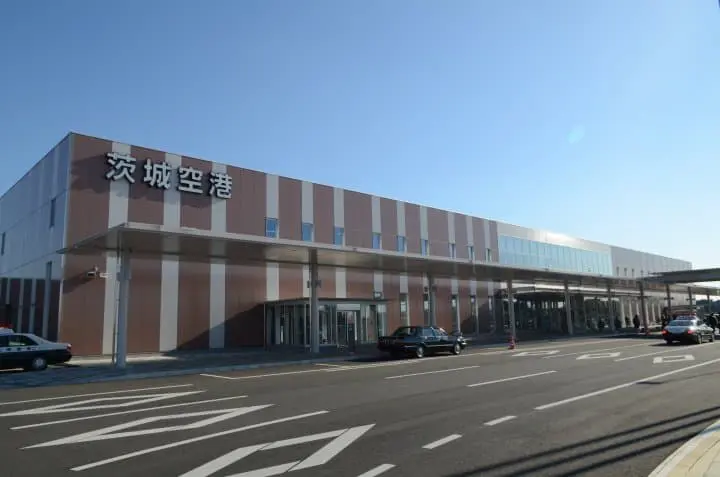
There are direct flights from Taiwan, Vietnam, and Myanmar to Ibaraki Airport.
The airport is also connected to the following domestic airports: Shin-Chitose, Kobe, Fukuoka, and Naha.
Address: Ibaraki, Omitama, Yozawa 1601-55 Official Website: https://www.ibaraki-airport.net/
JR Joban Line
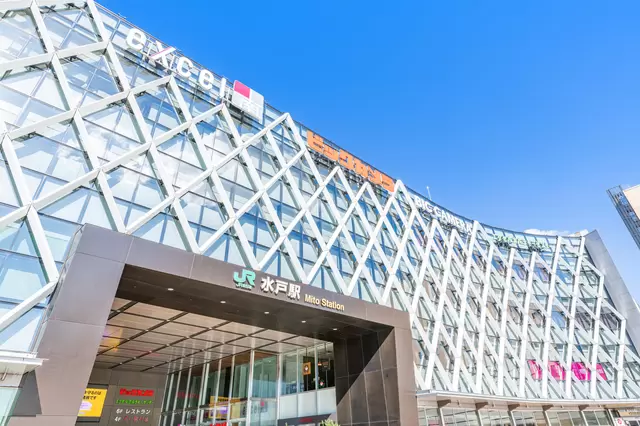
Those heading to Tsuchiura, Mito, or Hitachi from Tokyo should take the limited express Hitachi along the Joban Line.
From JR Tokyo or Ueno Station, it takes about 40 minutes to Tsuchiura, an hour to Mito, and an hour and a half to Hitachi.
If you are planning to ride the JR trains, be sure to purchase the JR Tokyo Wide Pass : a JR East discount ticket for overseas visitors.
Tsukuba Express

The Tsukuba area is accessible by riding the Tsukuba Express , which stops at Akihabara, Asakusa, and Kita-Senju stations.
From Akihabara Station, it takes about 45 minutes to Tsukuba Station on the rapid service train.

A rental car is another option for those interested in driving.
MATCHA is currently offering a 10% off coupon for overseas visitors on Nippon Rent-A-Car vehicles.
We recommend booking a rental car if you want to enjoy a leisure trip or group tour.

Coupon Included! How to Rent a Car in Japan: A Guide for International Visitors
Ibaraki: A Place Full of Attractions Awaits!
Ibaraki has once been ranked as the least attractive prefecture in a popularity survey, which may be hard to believe after reading this article.
Those interested in visiting the surrounding areas of Tokyo should definitely pay a visit to Ibaraki!
Main image by Pixta
Related topics
Top articles.
Start planning your trip
Special Features

Popular Searches
Latest news.

Floral Desserts in Kyoto! Itoh Kyuemon's Uji Matcha and Hydrangea Festival

Discover Kyoto's Elegant Geisha Culture at the Gion Kagai Art Museum

Showa Kinen Park Flower Festival 2024: Enjoy Nemophila, Tulips, and More!

A Must for Nature Lovers! Win a Free Stay at Unzen Amakusa National Park

A World of Light and Color! Van Gogh Alive in Japan 2024

Japan's Public Holidays and Long Weekends in 2024

Aeon Mall Okinawa Rycom: A Shopping Mall Featuring a Resort Aura

Suica and Pasmo IC Cards: Prepaid Transportation Passes in Japan

Riding Taxis in Japan: The 6 Best Apps to Grab a Cab

How to Travel to Kyoto From Osaka: The Fastest and Cheapest Ways
New articles.

Feel the fresh air of Ise and enjoy stargazing

A fitness gym opens on the grounds of the main building, Sen no Mori

The Saio, the princess who served Amaterasu Omikami

Photo spots unique to Ryokans

[Shimanami Kaido villa] Yu-Rah villa & gallery: where you can enjoy the spectacular view of Setouchi
13 Best Places to Visit in Ibaraki

Ibaraki Prefecture is situated northeast of Tokyo along the Pacific coast. Ibaraki is the perfect place for an easy and convenient day trip from Tokyo which offers historical shrines, one of the finest landscape gardens in Japan, a large park with a stunning sea of seasonal flowers, and much more. Here we have a list of places we recommend you to visit in Ibaraki.
Where to stay in Ibaraki
Recommended tours in ibaraki, articles you may also enjoy, 1. hitachi seaside park.

This large flower park, located near Mito City in Ibaraki Prefecture, features a wide variety of seasonal flowers and greenery along with a small amusement park, several cycling and walking trails. It is widely regarded as one of the most beautiful flower parks in Japan and the most popular season for the park is during late April until early May when approximately 4.5 million nemophila flowers cover the entire park, transforming it into a sea of blue petals. In addition to the nemophila season, the park is filled with seasonal flowers especially from spring to autumn; narcissus flowers from late March to mid-April, tulips from mid-April to late April, and bright green kochia bushes from mid-July which turn red as the weather turns cooler in September.
From Mito Station, take the JR Joban Line to Katsuta Station (5 minutes). From Katsuta Station, take a bus to Kaihin Koen Nishiguchi bus stop (20 – 30 minutes).
2. Mount Tsukuba
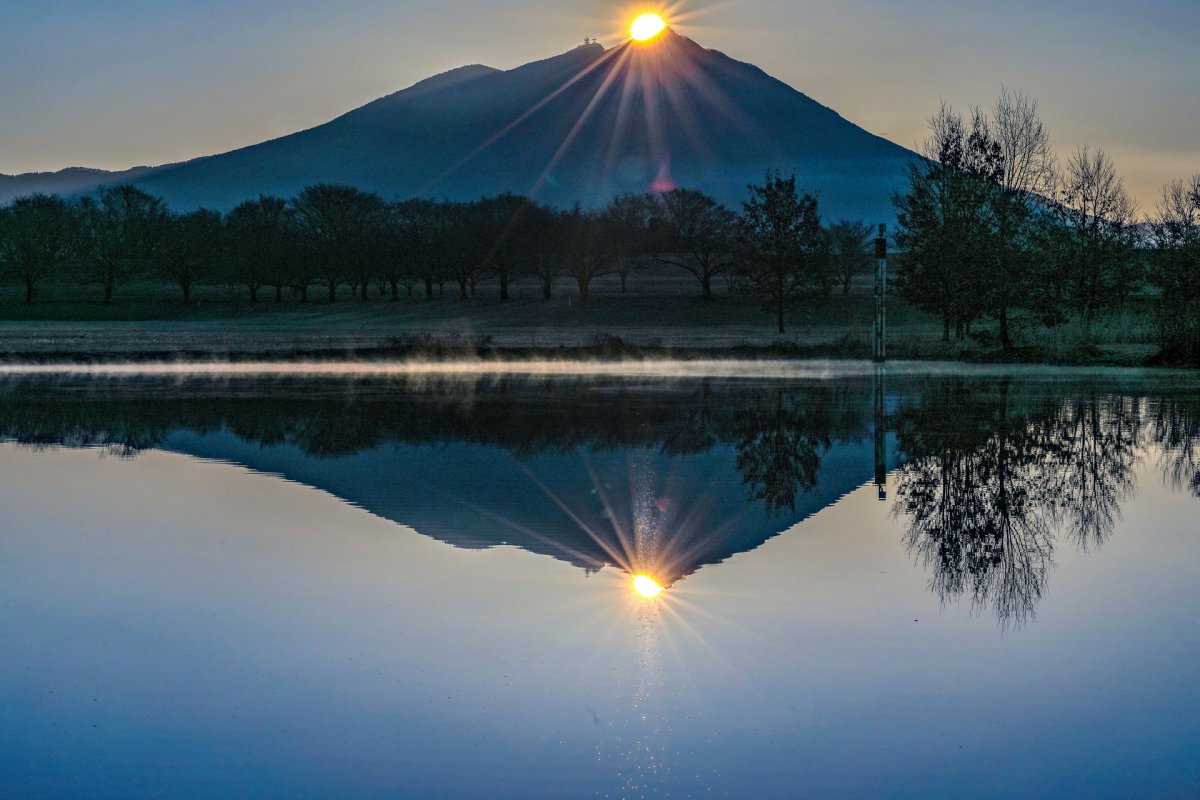
Mount Tsukuba stands at an elevation of 877 meters with two separate peaks. You can ascend to the summit by a cable car, ropeway, or by walking on a hiking trail. From the top of the mountain, a fantastic view of the Kanto Plain can be enjoyed. Three shrines are found in the area; Tsukubasan Shrine at the foot of the mountain, and two shrines each on both of the twin peaks.
There are two cable car lines going up to the summit which are Miyawaki Station near Tsukubasan Shrine and Tsutsuji-gaoka Station near the parking lot. During autumn when the leaves change colors, the cable cars offer night rides to the top and back.
Do you want to get the full Mount Tsukuba experience? Climb the beautiful mountain on one of the amazing tours below with a fun and knowledgeable English speaking guide!
- Guided Mt. Tsukuba Hiking Tour
- Mount Tsukuba Power Spot Tour

From Tsukuba Bus Center at Tsukuba Station, take a shuttle bus that goes directly to Mount Tsukuba (about 40 minutes).
3. Sudo Honke: Japan’s Oldest Sake Brewery
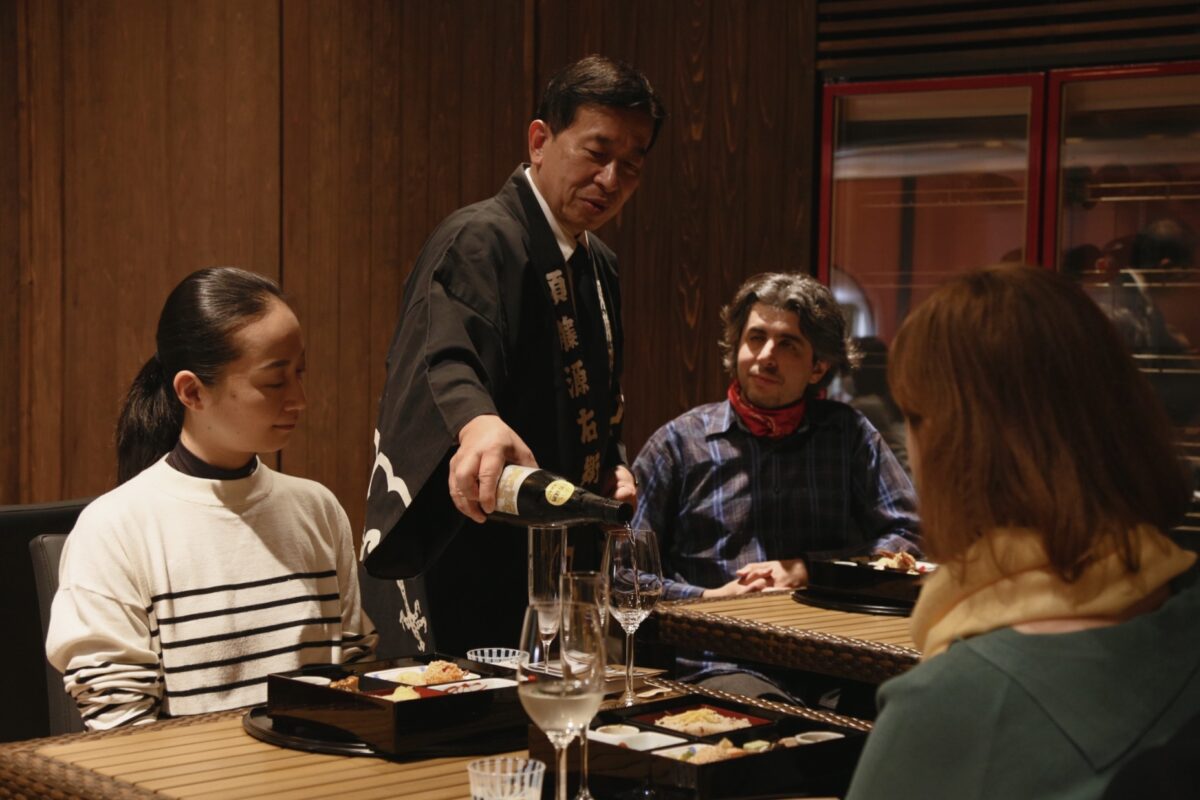
Located in the city of Kasama, Sudo Honke is the oldest Japanese sake brewery in Japan, dating back to the year 1141! With a history of 55 generations, and a great location with an abundance of fresh water making for a source of high quality rice, they have mastered the art of sake brewing. They offer an amazing sake pairing course in which you will have the chance to try a number of different kinds of sake and pair them with Japanese cuisine that goes well with each specific bottle. The veteran sake experts of Sudo Honke will guide you through and explain the food and sake along the way, as well as answer any questions you may have. This is a great opportunity to dive into the world of sake, as well as learn more about Japanese culture as a whole.
Book tour here
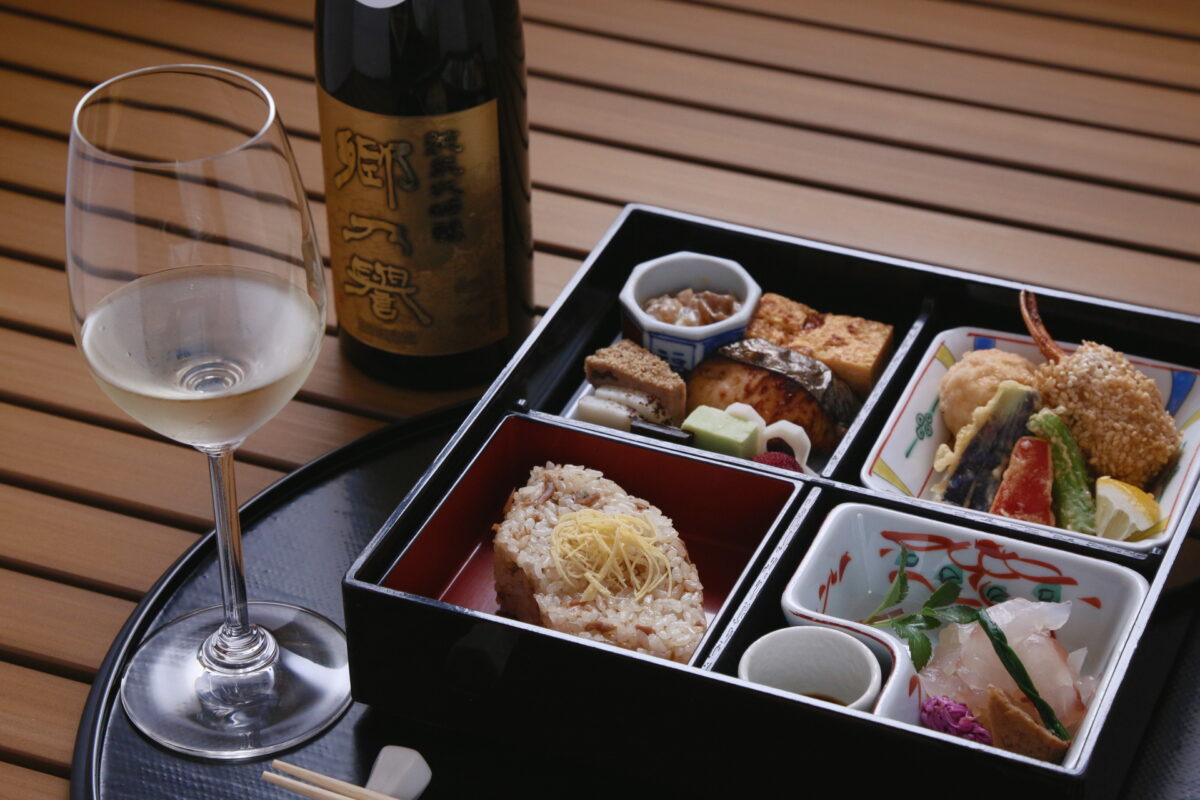
About 15 min by taxi or 30min walk from JR Tomobe station
4. Oarai Isosaki Shrine

This ancient shrine stands on the coastline facing the Pacific Ocean in Ibaraki Prefecture. The torii gate, called Kamiiso-no-Torii, which means “gate at the beach of the gods” stands at the shore of the ocean while waves crash about its base. According to a history book, two deities, Omunamuchi-no-mikoto and Sukuna Bikona-no-mikoto who are considered to have created Japan, descended onto this land in 856. It is believed that Kamijiso-no-Torii was built by Omunamuchi-no-mikoto and other deities who descended upon this place.
The main hall of the shrine is situated on a hill close to the coastline. There is a large torii gate right in front of the main hall. The gate was made with wood but had to be reconstructed with concrete in 1963 due to the damage from the sea breeze.
From Mito Station, take the Oarai-Kashima Line to Oarai Station (about 15 minutes). From Oarai Station, the shrine is 2.5 km. Take a taxi or a public bus.
5. Daigo Town
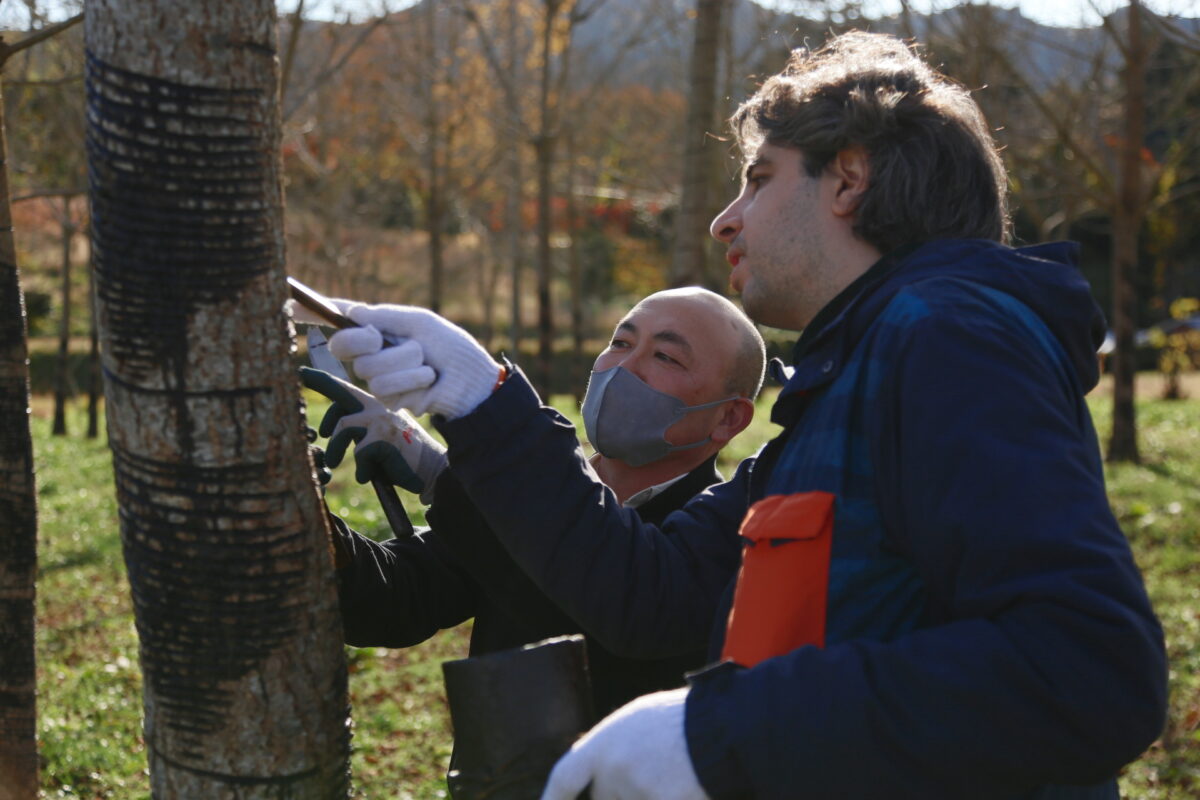
Lacquerware is one of Japan’s oldest and most valued forms of crafts that dates back thousands of years. The town of Daigo in Ibaraki is the second largest producer of raw lacquer in all of Japan, with its very own high quality “Daigo Urushi” made by local artisan masters. On this tour you’ll have the opportunity to visit the workshop of an urushi lacquerware craftsman, as well as learn more about the lacquerware making process, see a live demonstration, and potentially even get to experience part of the process yourself. After this you will get to have a look at the artisan’s beautiful gallery and also try out some of the high quality finished lacquerware with a bowl of soup or cup of sake. If you are lucky enough to be in Japan in October or November, you can also opt for the additional “urushi tapping” experience where you will be able harvest some of the raw urushi (tree sap) for yourself!
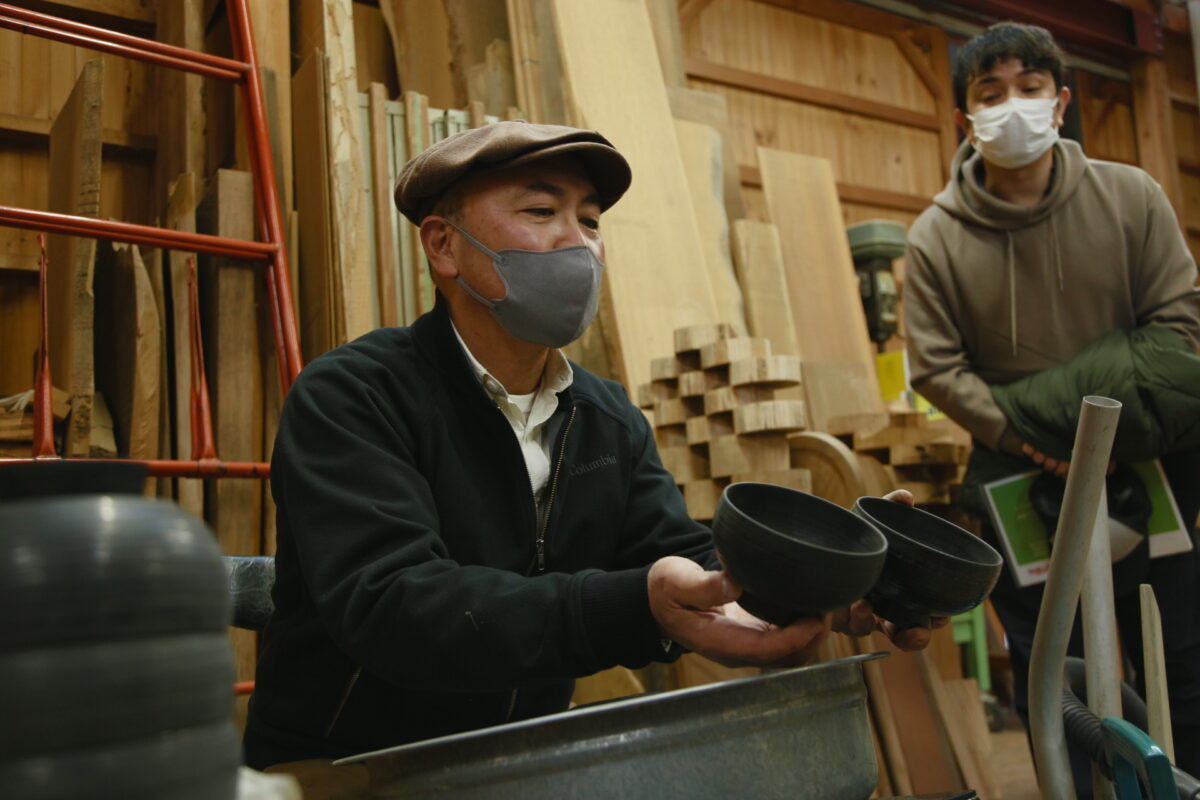
Closest station is Hitachi Daigo Station, about a 75 minute train ride from Mito Station
6. Fukuroda Falls
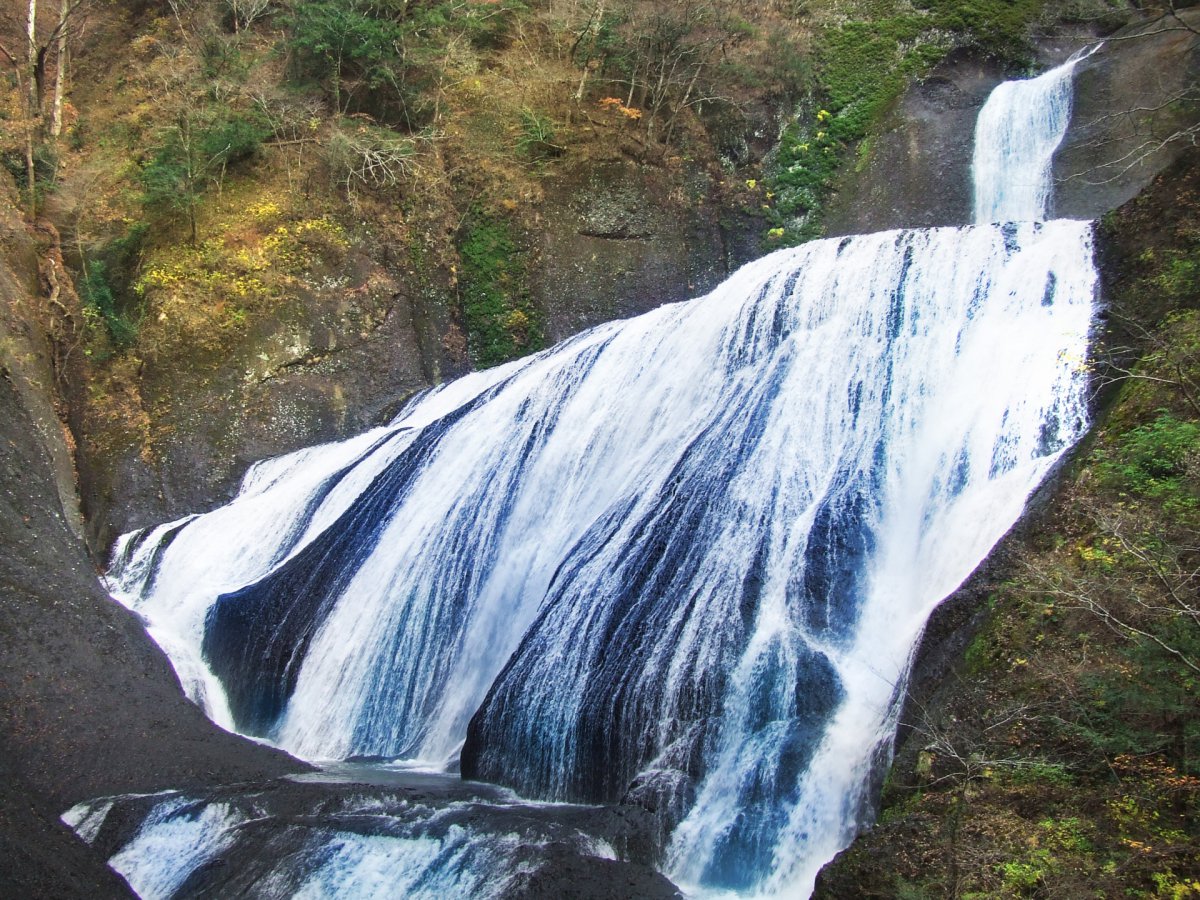
Fukuroda Falls is located in Daigo Town, northwestern Ibaraki Prefecture and north of Mito. It is regarded as one of the three most beautiful waterfalls in Japan along with Nachi Falls in Wakayama Prefecture and Kegon Falls in Tochigi Prefecture.
The Fukuroda Falls rise to a height of 121 meters and are 73 meters wide. The most popular season for the tourists is the autumn when the leaves change their colors, however the beautiful and dynamic falls are appreciated in every season. It makes for a fun day into nature from Tokyo ! In winter, you may be able to see the entire cascade frozen over.
From Mito Station, take the JR Suigun Line to Fukuroda Station (about 70 minutes). From Fukuroda Station, take a taxi or a public bus which runs every one to two hours.
7. Kairakuen
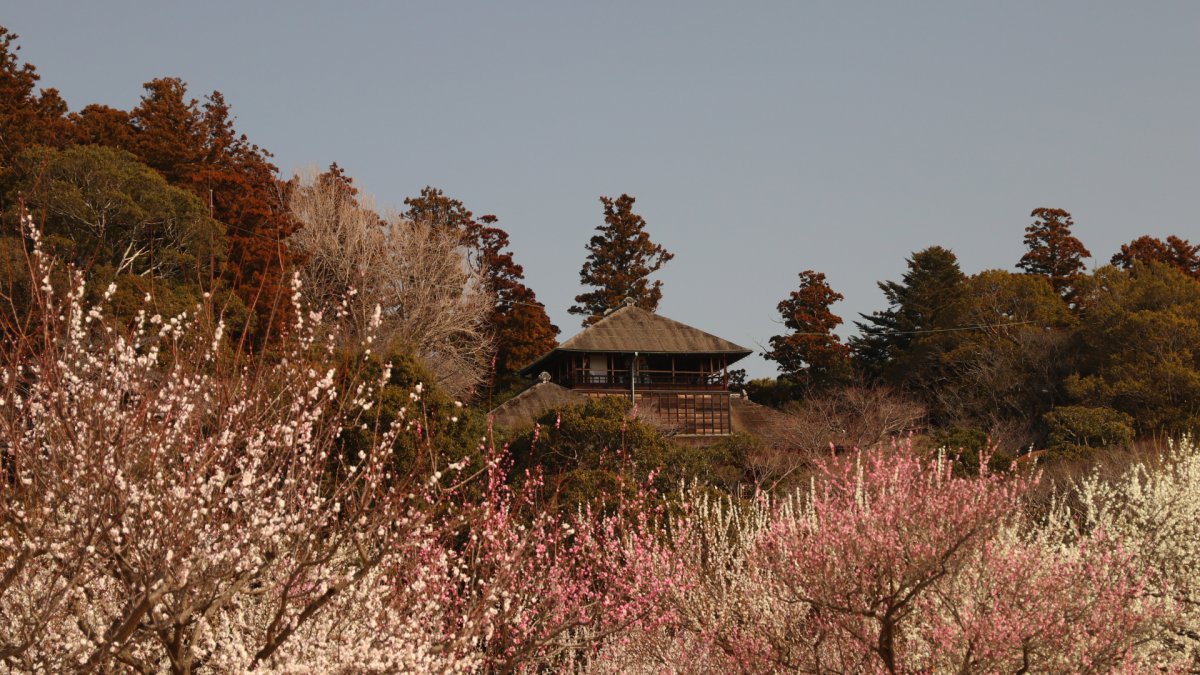
Kairakuen , located in Mito City which is the capital of Ibaraki Prefecture, is listed as one of the top three finest landscape gardens in Japan along with Kenrokuen in Kanazawa Prefecture and Kourakuen in Okayama Prefecture. Kairakuen was constructed in 1841 by the local lord Tokugawa Nariaki. Kairakuen means “park to be enjoyed by everyone”. As its name indicates, this park served not only for the enjoyment of the ruling lord, but was also open to the public.
Kairakuen is particularly popular during the plum blossom season. Many people visit the garden for the Mito Plum Festival that is held from mid-February through March every year when as many as 3,000 trees of over 100 different varieties of plum trees are in bloom.
Besides the plum trees, Kairakuen also features a bamboo forest, cedar woods and the Kobuntei, a traditional Japanese style building which has been used for educational and recreational purposes.
From Mito Station, take the Kanto Tetsudo Bus bound for Kairakuen and get off at Kairakuen Bus Stop (about 15 minutes).
Admission 300 yen/adult, 150 yen/child Open 6am-7pm(Feb.20-Sep.30), 7am-6pm(Oct.1-Feb.19)
8. Kasama Inari Shrine
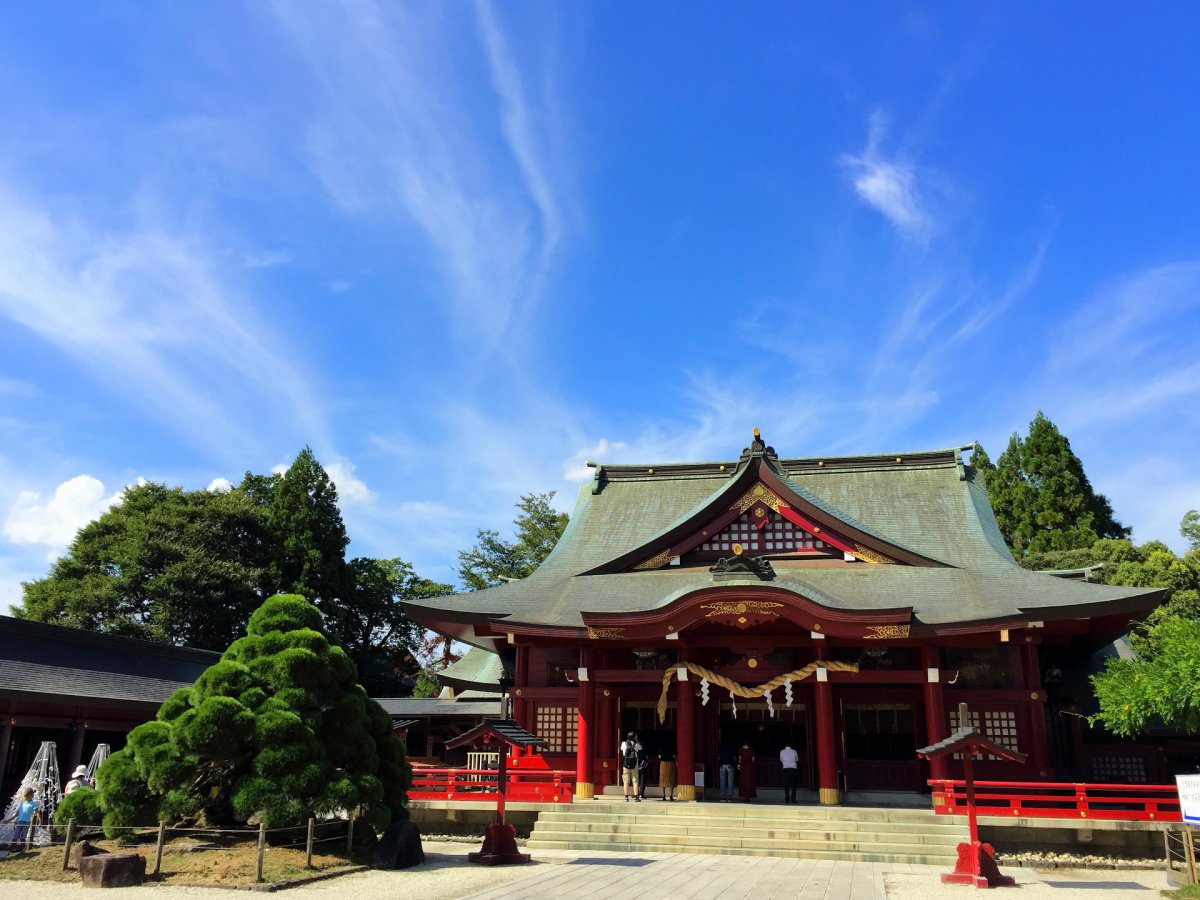
Kasama Inari Shrine is one of the three largest Inari shrines in Japan, and its deity was awarded the Senior First Rank, the highest court rank granted to shrines. The legends says that the shrine was founded in 651 during the reign of Emperor Kotoku.
Several events are held at Kasama Inari Shrine throughout the year. One of the main events at the shrine is “ yabusame ”, which is the ceremonial form of equine archery in autumn and serves as a divination for the year’s harvest. On November 3 every year, the members of the Ogasawara School of Mounted Archery perform the rite in accordance with ancient precedent with traditional costumes of Kamakura warriors. As many as 100,000 people gather each year for this event.
Another popular event is the Chrysanthemum Festival which is held usually from late October to late November when the blossoms are in bloom. Begun in 1890, the Chrysanthemum Festival at the Kasama Inari Shrine is the oldest in Japan. The shrine gardens were designed specifically for the exhibition of chrysanthemum flowers and as many as 600,000 people visit for the festival every year.
Kasama Inari Shrine is located 20-minute walk from JR Kasama Station. JR Kasama Station is about 25 minutes from Mito Station on the JR Mito Line, or about 80 minutes from Ueno Station in Tokyo.
9. Kyoyuzen Hanamiyako
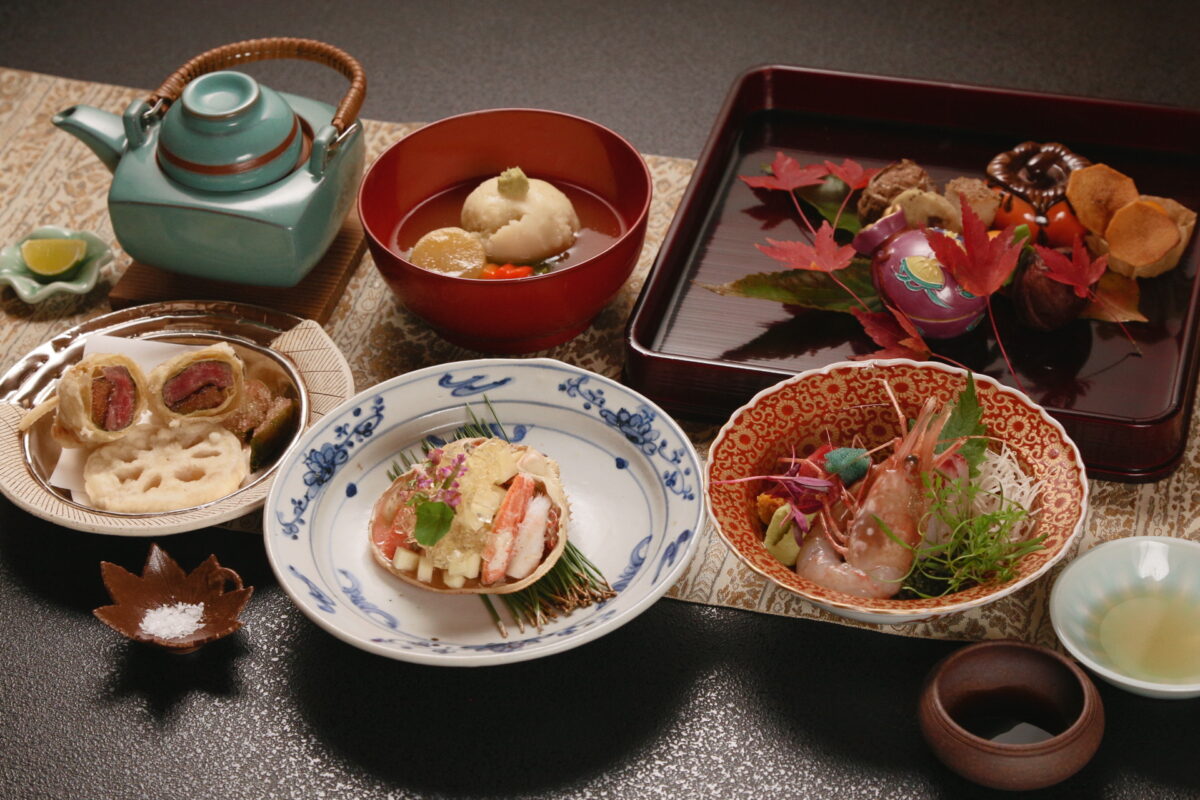
Do you want to try some of the best Japanese cuisine that you will ever have in your life? In the city of Hitachinaka that is well known for Hitachi Seaside Park, lies an amazing Japanese Kaiseki style restaurant called Kyoyuzen Hanamiyako that is in the Gault et Millau restaurant guide. It will be a one of a kind kaiseki lunch experience where you will get a personal lesson on how to properly use the utensils, as well as an explanation of the unique restaurant’s interior design and traditional high quality Ibaraki prefecture crafts on display. After the delicious meal you will move to the tea room inside the restaurant, where the restaurateur himself(who also happens to be a tea ceremony master) will perform an entertaining tea ceremony along with Japanese sweets just for you. If you want to get the full experience, you will have the option of adding on an alcohol pairing course that offers amazing hand picked Japanese alcohol from throughout the country.
Book a table here
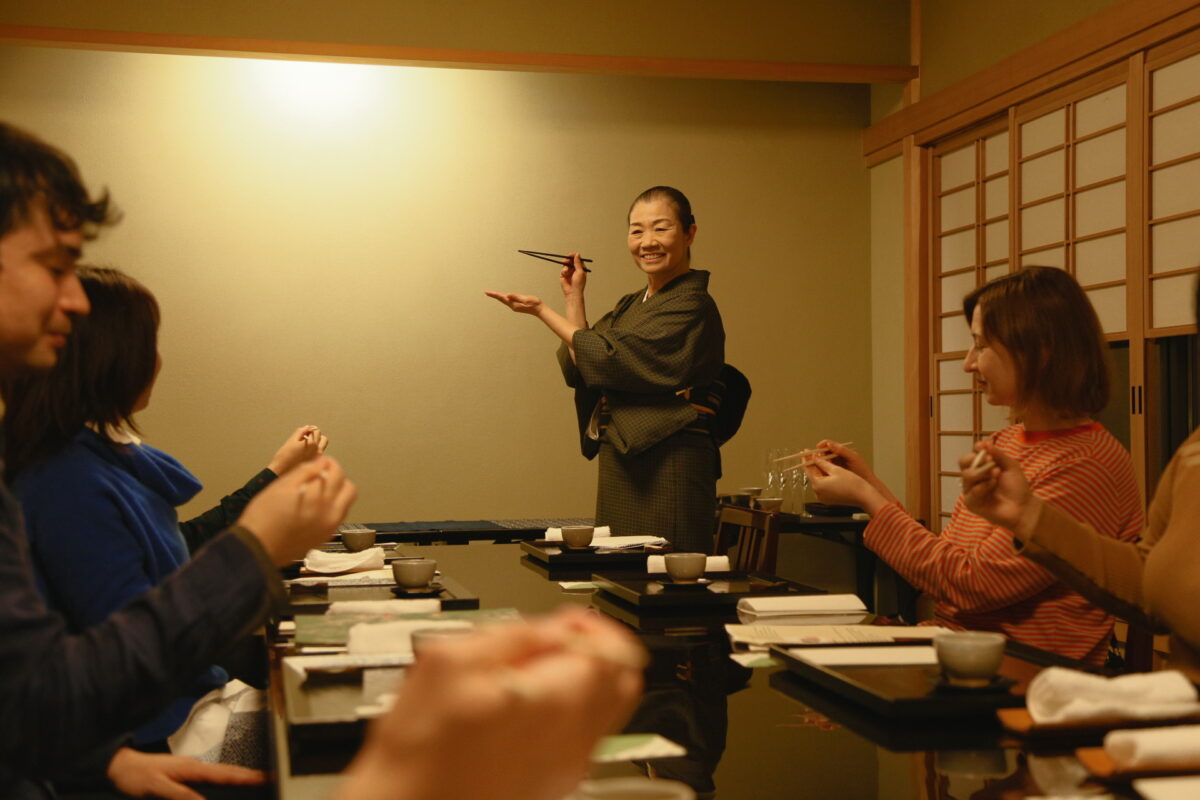
8 minutes by taxi from the east exit of Katsuta Station on the JR Joban Line The limited express Hitachi and the limited express Tokiwa all stop at this station
10. Ushiku Chateau

This is the first brewery in Japan to produce wine from grape cultivation to brewing and bottling. It was founded in 1903 by Kamiya Denbee. At its peak, as many as 130,000 vines were planted. Although after World War II the vineyards were reduced due to agricultural land reform, it was reopened as a leisure site with restaurants and shops. Recently the restaurants and shops were closed, and now you can find a large garden with greenery, a beautiful memorial hall and museum which are made with bricks. The exhibitions in the memorial hall and museum include information on how Japanese wine was made at the beginning of the 20th century, pictures and actual equipment which were used for wine making, advertising posters and alcoholic beverages sold in the group.
8-minute walk from Ushiku Station on JR Joban Line.
11. Ushiku Daibutsu
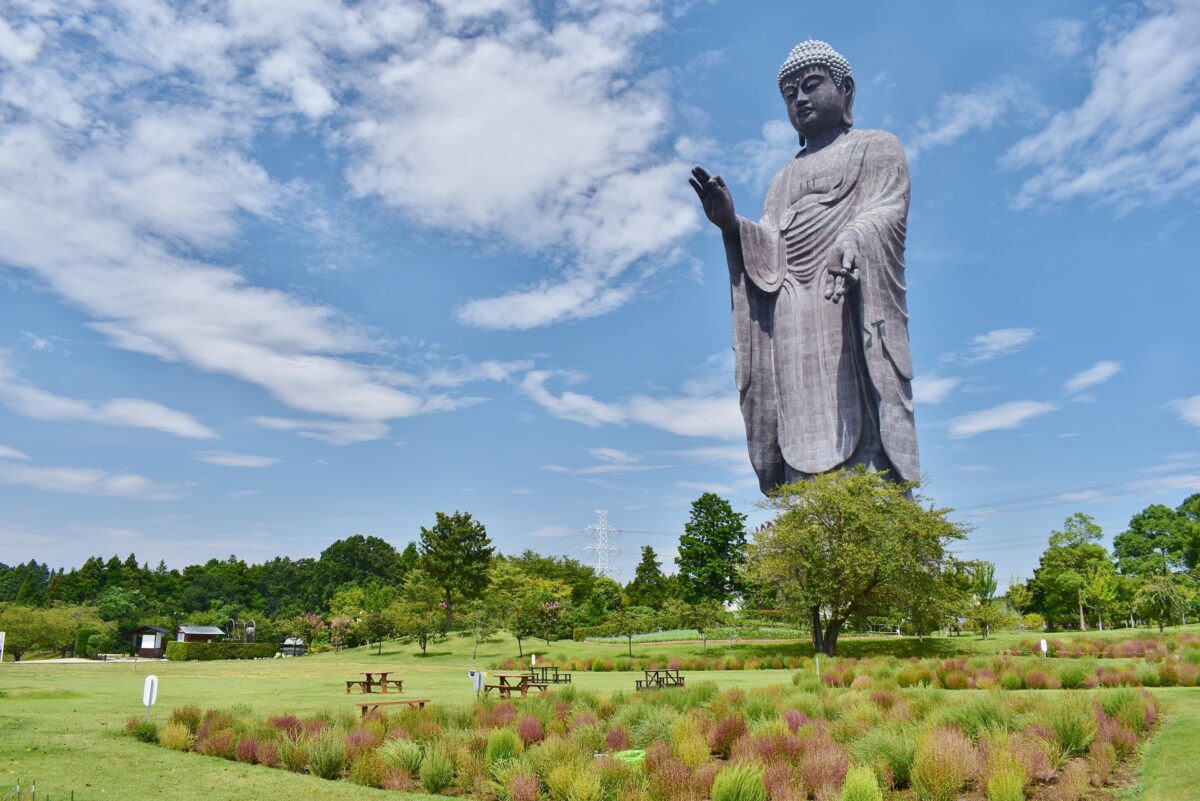
Ushiku Daibutsu is the tallest buddha statue in the world with 120 meters in height. It’s three times bigger than the Statue of Liberty in New York. Inside of the Daibutsu is actually a temple. It consists of five floors and the observation deck which is a chest part of the Daibutsu. On the first floor it’s “the world of light”, you’ll walk through the dark which represents humans’ desires and once the second door opens, you’ll see a ray of light of mercy. On the second floor, the exhibition of the Ushiku Daibutsu can be seen and there’s a space where you can experience shakyo , copying Sutra. On the third floor is the main hall of the temple and it’s the world of gold. The room is surrounded by about 3,400 small golden buddha statues on the walls. On the fourth and fifth floor, there lay the Buddha’s relics and the observation deck where you can see the view at 85 meters high. If it’s clear weather, you can see Skytree and Mt. Fuji !
Book your Ushiku tour here
15 minutes by taxi from JR Joban Line Ushiku Station or 20-30 minutes by bus (get on the bus at Higashi 2-ban noriba toward Ushiku Daibutsu or Ami Premium Outlet, and get off at the Ushiku Daibutsu bus stop)
12. Lake Kasumigaura
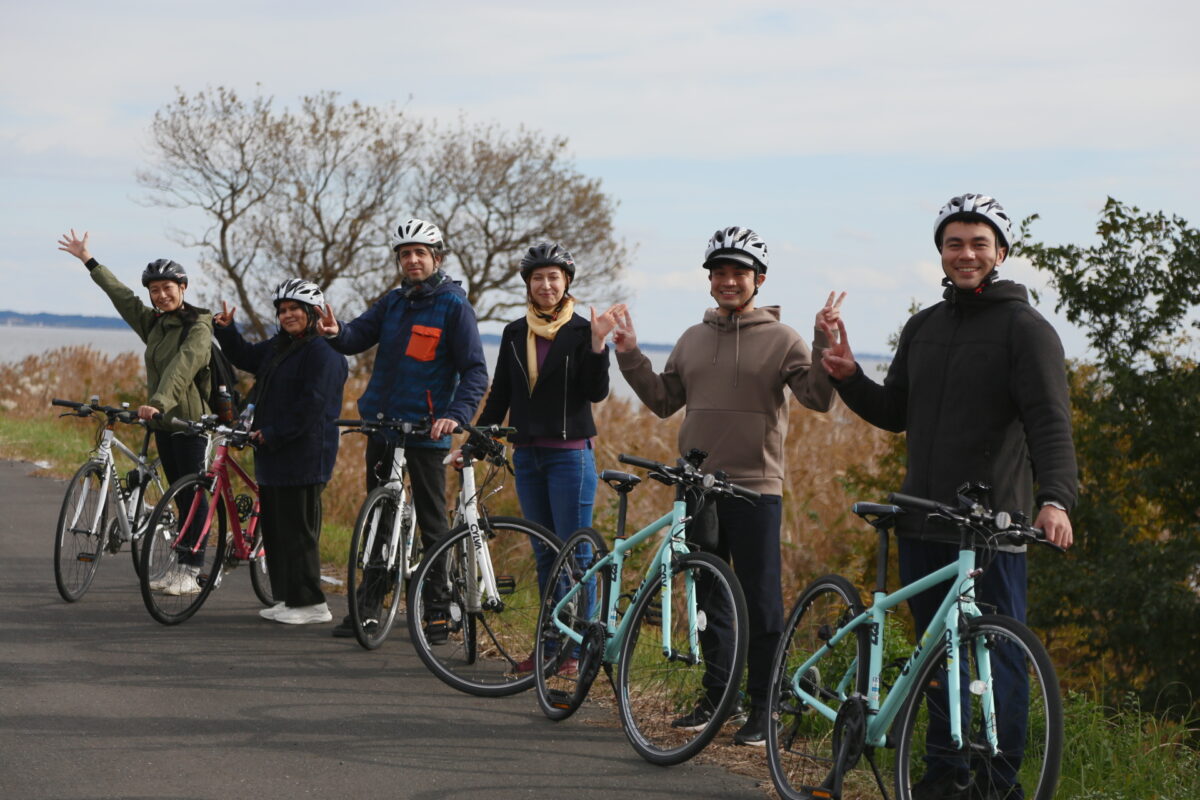
Kasumigaura is the second largest lake next to Lake Biwa in Japan. One third of Ibaraki prefecture is actually covered by this lake. You can enjoy the ferry ride in this vast lake. Also it’s a popular spot for fishing since it’s rich with natural sources and is home to various kinds of fishes and wild animals. In summer, hobikibune , sailing boats are running and tourists can see and take pictures of them closely on the accompanying boat. These sailing boats were originally used for fishing from 1880 for about 100 years in this area.
Want a fun guided experience of Kasumigaura? Ibaraki prefecture is the biggest lotus root producing prefecture in all of Japan, making it the best place to both try your hand at digging up the local delicacy and then eating your own pickings. First ride around Lake Kasumigaura on a smooth, scenic course that people of all ages and abilities will be able to enjoy. After arriving at the lotus root fields, you’ll have the chance to meet the friendly local farmers that will teach you and assist you in harvesting the popular regional root. Once harvesting your own lotus roots, that makes for an experience in itself, you’ll have a nice barbeque and get to taste the fruits(vegetables) of your labors!

Just about a 10 minutes’ walk from Tsuchiura Station
13. Ryujin Bridge
Ryujin Bridge is one of the most popular bungee jumping spots, jumping from 100 meters high. It’s a big bridge across Ryujin Gorge. When you cross the bridge, you’ll see the Ryujin Carillon that consists of three different bells representing love, hope and happiness. On both sides of the bridge, there are big dragon’s paintings on the walls. There are some seasonal events such as displaying a thousand of koinobori carp streamers flying for Children’s Day in May, and lantern festival in the middle of August where about 500 lanterns light up in the evening.
From Hitachi-Ota Station take a bus toward Ryujin Bridge (40 minutes)
- Tabino Hotel Kashima ―Newly opened in April 2020, comfortable rooms and public onsen hot springs which makes you relax after your long day of exploring
- Mito Plaza Hotel ―4-star hotel where they have three restaurants on site, luxury atmosphere with antique taste furniture and spacious room
- Ryokan Honen Mansaku ―Located near Fukuroda Fall, you can enjoy onsen hot springs including open-air bath with mountain view and great dinner and breakfast
- Legacy of Mito-Tokugawa Clan Half-day Tour If you are interested in history, take this half-day tour at Mito City in Ibaraki prefecture. This tour includes Kodokan , the old samurai school and Kairakuen garden etc.
- Pottery experience in Kasama Enjoy a special pottery experience in the well known ceramic city of Kasama, where you will be able to make your own masterpiece.
- Mount Tsukuba Power Spot Tour Escape the hustle and bustle of the city and climb the beautiful Mount Tsukuba and explore its highlights with an experienced guide. Finish off the tour with a well deserved and relaxing dip in a hot spring with an amazing view.
- Ceramic Experience at Craft Hills Kasama and Ibaraki Ceramic Art Museum Try your hand at making Kasama-yaki pottery by using a wheel, your bare hands hand, or even just painting an already fired piece. You will also be able to explore the Ibaraki Ceramic Art Museum that has exhibits of pieces by famous ceramic artists.
- Kasama yaki handmade pottery experience Try the traditional technique “tehineri” in making your own special piece of pottery at a kiln that was established in 1796. Make your choice of bowls, plates or cups from the instructor who has years of experience.
- The Tallest Great Buddha Spot Walking Tour Explore the Great Buddha statue alongside an expert English speaking guide. The statue stands at a whopping 120 meters tall and is something that is hard to put into perspective without seeing in person.
What did you think about Ibaraki? Convenient public transportation makes it easy for you to have a day trip from Tokyo. We hope you have a lot of fun in Ibaraki.
Follow us on Instagram or Facebook for more travel inspiration. Or tag us to get featured!
Happy traveling!

This post may contain some affiliate links. When you click through and make a purchase we may receive some commission, at no extra costs to you.
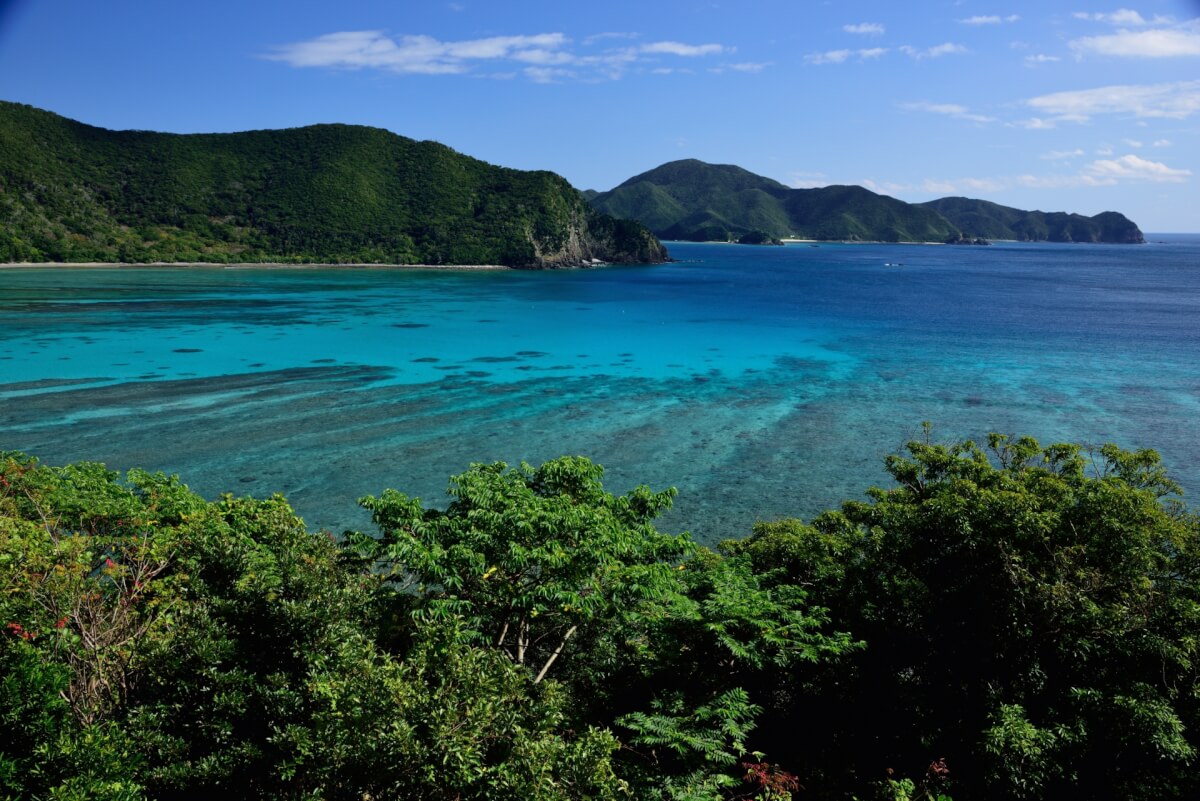
- Popular destinations
- Hidden places in Japan
- Tours and workshop
- Food and drink in Japan
- Itinerary in Japan
- Places to visit in Tokyo
- Food and drink in Tokyo
- Seasonal events
- Tours & workshops
- Tokyo This Week
- Day trip from Tokyo
- Itinerary in Tokyo
- Places to visit in Kyoto
- Food and drink in Kyoto
- Itinerary in Kyoto
- Day trip from Kyoto
- Travel tips
- Accommodation
- Cultural tips
- Transportation
- Tokyo Tours
- Kyoto Tours
- Kimono Rental
- Fukushima Tours
- Mount Fuji Tours
- Tour Package
- Media Kit(English/日本語)

Travel TW Collabs
Guide to Ibaraki: 10 Must-See Places in the Scenic Prefecture
From arts and crafts to high tech, there are plenty of top reasons to visit Ibaraki, making it a great day trip from Tokyo.
June 30, 2020 Updated On December 26, 2022
Ibaraki gets a bad rap for being Tokyo’s country bumpkin neighbor, but it’s precisely the prefecture’s bucolic scenery that makes it such a great destination for those seeking to escape the city. It’s close enough to Tokyo for a day trip , but has more than enough to explore for a long weekend or more. Here are 10 spots to visit, including our recommended places to sleep and eat.
Northern Ibaraki: Art & Craftsmanship
Northern Ibaraki boasts stunning coastal views and has long been a destination for artists seeking inspiration.
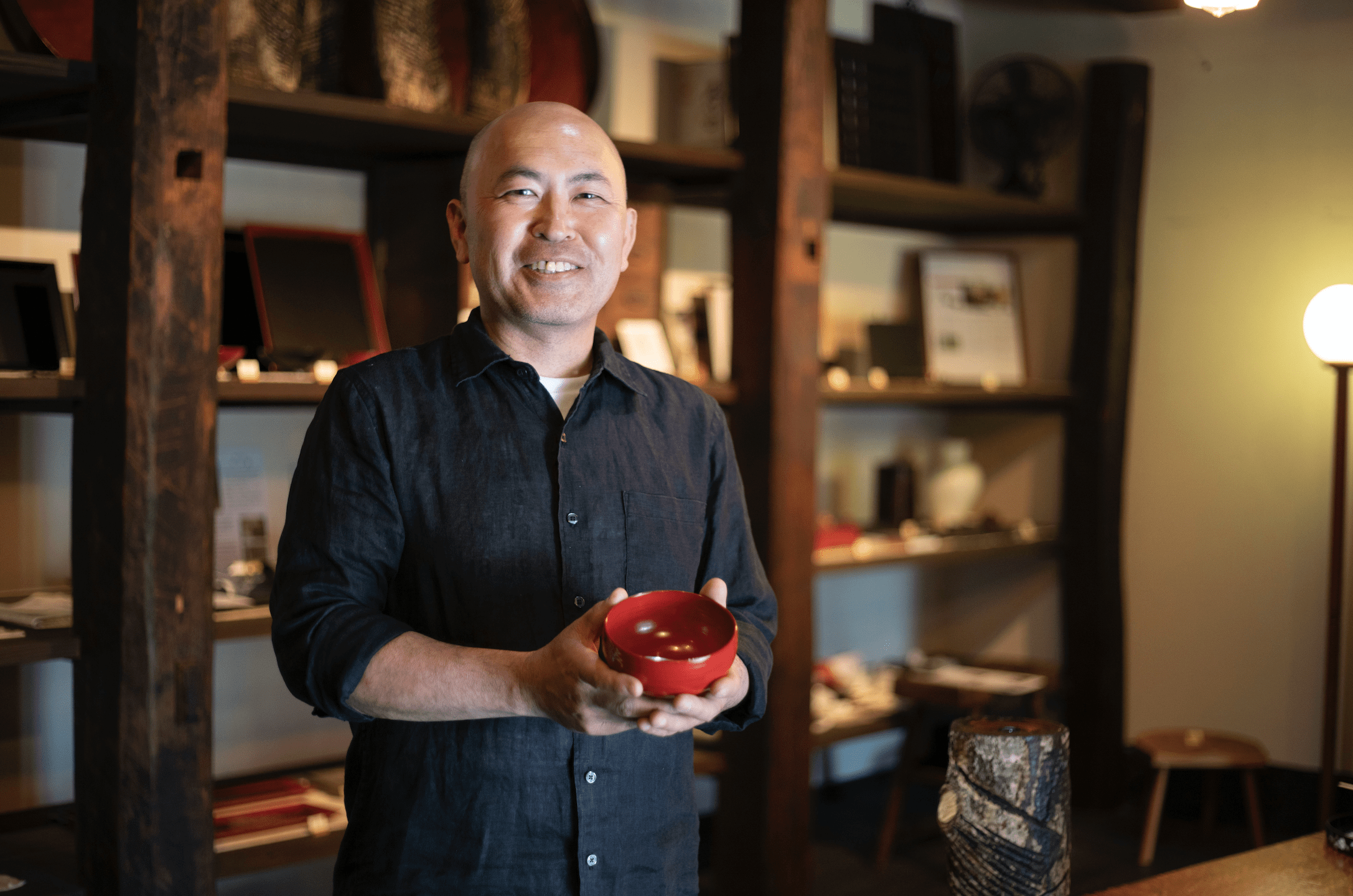
Photo by Ryoko Ogawa
While 97 percent of urushi used to make lacquerware products is imported from China, 15 percent of Japan’s domestically produced urushi is harvested in northern Ibaraki. Kijian in central Daigo town uses local high-quality urushi to make handcrafted lacquerware items like bowls, chopsticks and other everyday items, with the goal to pass on this traditional craft to future generations.
The store is housed inside a charming shop built in 1896 and serves as a gallery and café. Browse their wares and soak up the atmosphere while enjoying a matcha tea set, complete with wagashi sourced from a nearby confectionery store. It’s the perfect place to take a break on the way to nearby Fukuroda Falls, one of Japan’s top three waterfalls. Open Sat, Sun and Mon.
More info: tsujitohru.jp/en/
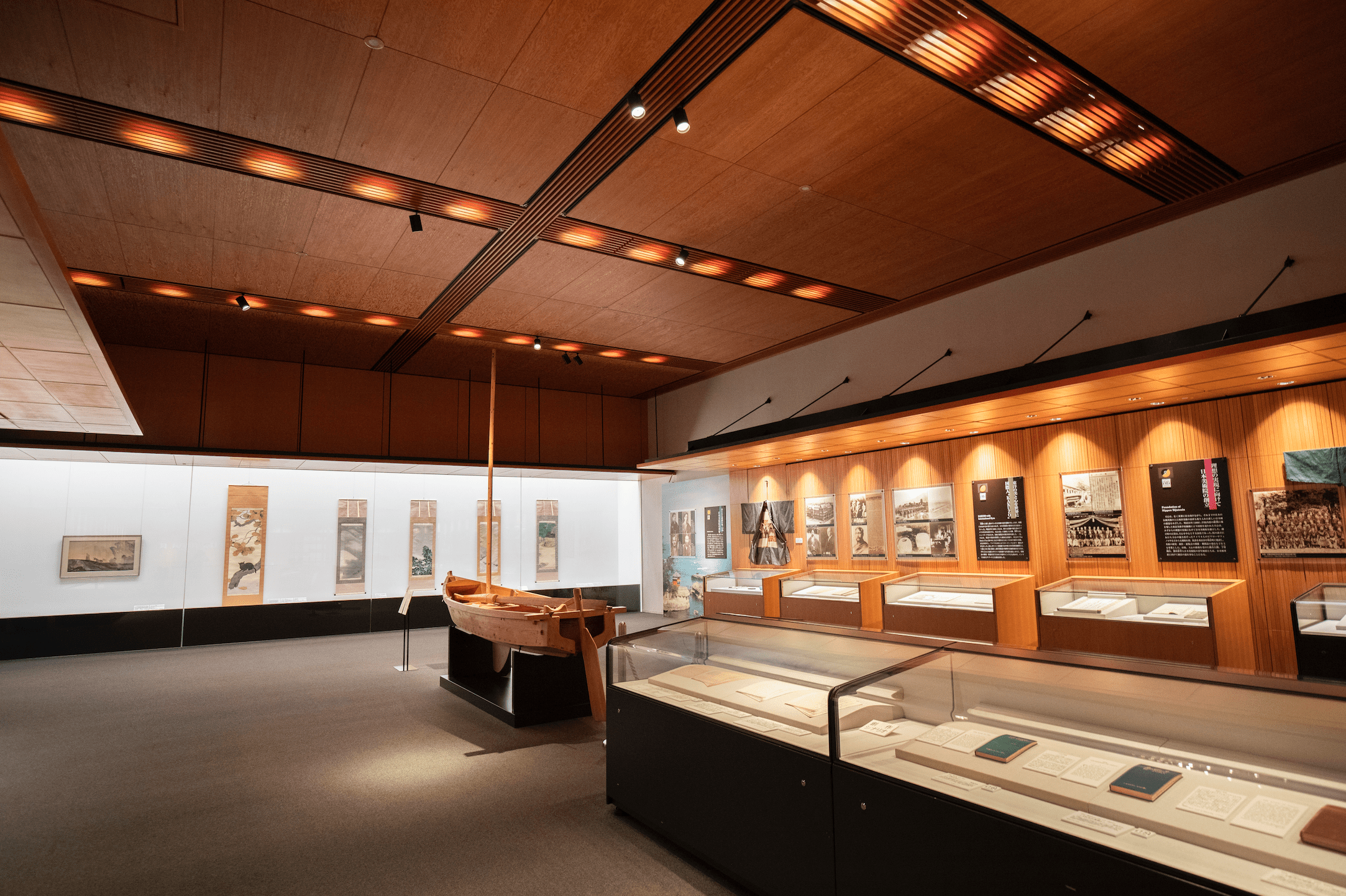
2. Tenshin Memorial Museum of Art and Rokkaku-do
Though the name Tenshin Okakura may not ring any bells at first, most people will recognize his Meiji-era international bestseller The Book of Tea , a collection of meditations on the importance of tea and tea ceremony to Japanese culture. Domestically, Okakura is best known for being a champion of Nihonga (Japanese-style paintings).
At Tenshin Memorial Museum of Art, visitors can learn more about Okakura and his mission to share the artform abroad in the very region he studied with his apprentices. The museum offers breathtaking views of the Izura coastline from its café and grounds. Take a 15-minute stroll down the coastal path to Rokkaku-do, one of Japan’s most famous scenic spots that’s known for inspiring Okakura in his later years.
More info: www.tenshin.museum.ibk.ed.jp/07_english/index.html
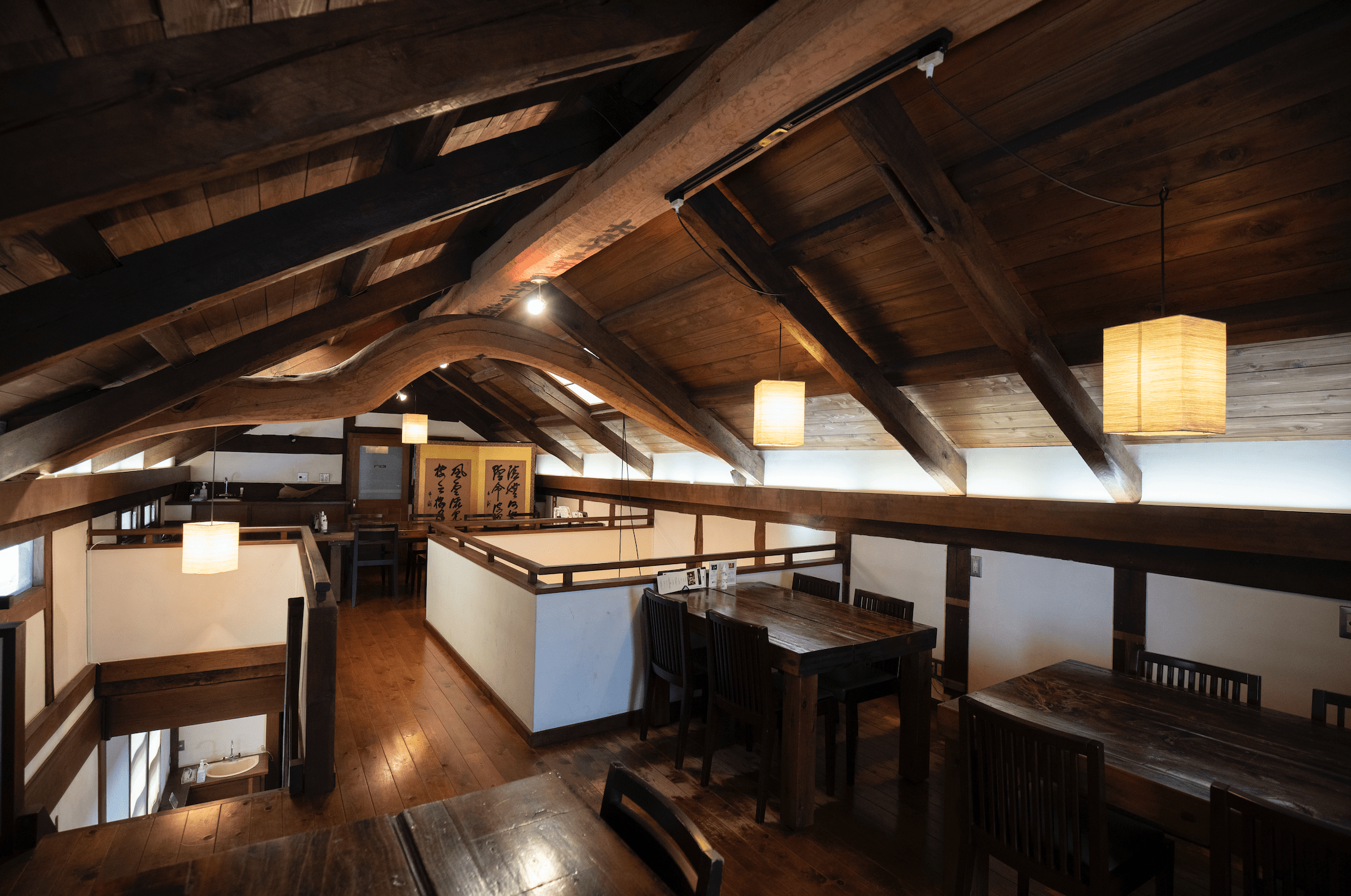
Where to Dine: Kiuchi Brewery
World-famous Hitachino Nest beer’s headquarters lie in the heart of Ibaraki’s Naka city. Before Kiuchi Brewery got into beer in 1996, it spent about 170 years distilling and brewing sake, shochu, umeshu and more. Stop by for a tasting at the bar and follow up with a bite to eat at their rustic soba restaurant. For those seeking something a little bit extra, book a session to brew your own beer on the premises.
More info: kodawari.cc/en/
Where to Stay: Izura Kanko Hotel
Fall sleep to the lull of the Pacific Ocean and wake up to the views that inspired Tenshin Okakura and his apprentices. If that alone is not convincing enough, the Izura Coast is listed as one of Japan’s top 100 shores, one of the top 100 white sand beaches with pine groves, and has one of the nation’s top 100 soundscapes.
More info: www.izura.net
Mito Area: Samurai History in the Modern Age
Ibaraki Prefecture’s capital city and longtime cultural and economic hub has a wealth of amazing locations in and around the area.
3. Kairakuen
Kairakuen is, together with Kenrokuen in Kanazawa and Korakuen in Okayama, one of Japan’s three great gardens from the Edo Period. Mito Domain’s ninth daimyo Nariaki Tokugawa founded the garden in 1842, with the desire to provide a beautiful Japanese garden that was open to the public.
It boasts about 3,000 plum trees in about 100 varieties and a beautiful traditional house called Kobuntei. Nearby Kodokan (Nariaki Tokugawa’s school for men) offers a chance to take a deep dive in regional feudal history.
More info: www.ibarakiguide.jp/park/foreign_language/en/index.html
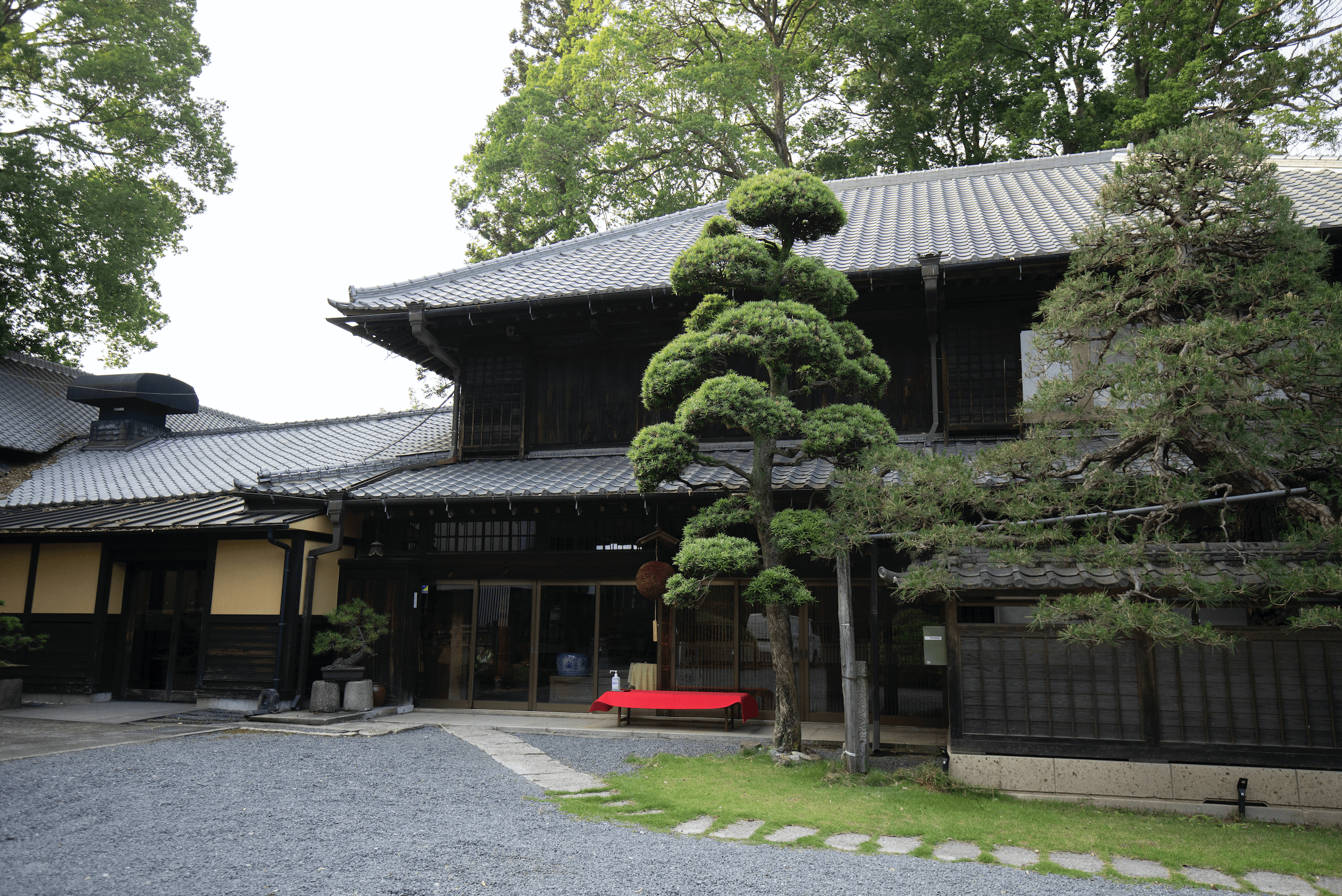
4. Sudohonke Sake Brewery
Owned by descendants of a samurai family, Sudohonke Sake Brewery is unique for many reasons. Surrounded by a slew of ancient trees – some an astonishing 800 years of age – this brewery values its natural resources and is built around them. Known as the brewery in the woods by locals, the owners built one of their newer buildings around the trees instead of cutting them down.
Visitors can reserve tours of the brewery that finish with tastings of a selection of the brewery’s award-winning sake (a fee applies and reservations are required in advance).
More info: www.sudohonke.co.jp/en/tour/
Where to Dine: Tousuian
Just a stone’s throw from Kairakuen and with a view over Senba Lake, Tousuian offers modern kaiseki meals in a beautiful setting. Seasonal fare showcases Ibaraki’s finest ingredients when they are at their best. The unique enju course offers a taste of truly historic food: dine on special cuisine based on recipes from the Edo Period that was beloved by Mito Domain’s second daimyo, Mitsukuni Tokugawa, who locals to this day call Mito Komon.
More info: www.tousuian.com
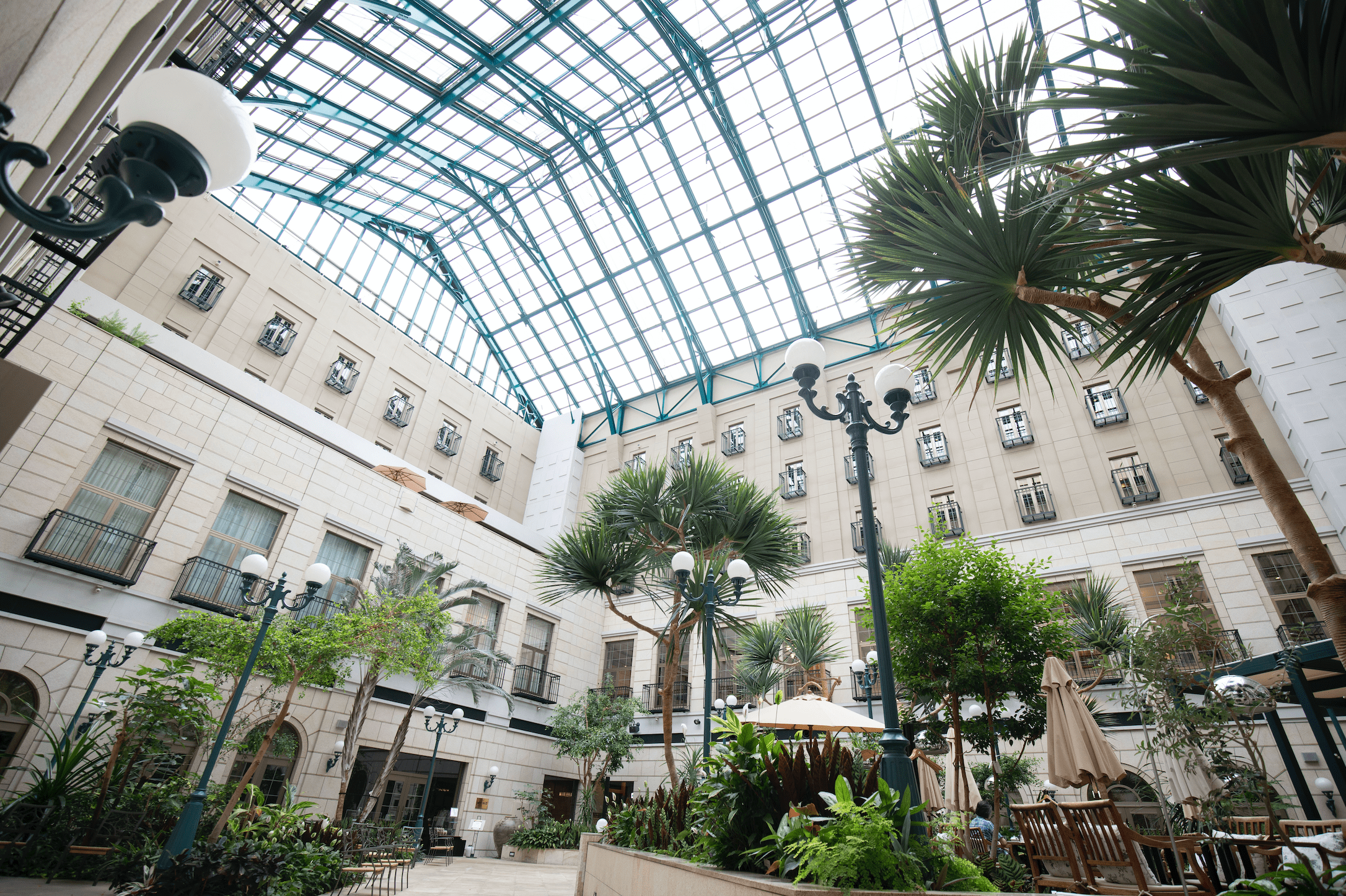
Where to Stay: Mito Plaza Hotel
Designed by Thomas Edison’s great-grandson, Mito Plaza Hotel offers a verdant oasis from the city surrounding it – both inside and outside. The interior fuses modern comfort and traditional style and offers decadent luxury for a fraction of the equivalent Tokyo price tag. Make the most of the greenery with a relaxing afternoon tea at Cafe & Bar Plaza in the greenhouse-like atrium. Staff are extremely well-versed in the area and will give suggestions for dining out and sights outside of the typical tourist traps.
More info: www.mito-plaza.jp
Coastal Ibaraki: Seaside and Spiritual Connections
For beautiful ocean views – including one of Japan’s most beautiful sunrise locations – look no further than Oarai and its surrounding area.
5. Hitachi Seaside Park
Ibaraki’s biggest claim to fame for many visitors is Hitachi Seaside Park, a picturesque green space of enormous proportions with a view of the ocean. It showcases some amazing flower displays, including its famous baby blue nemophila in mid-April to early May.
The park’s Pleasure Garden has over 25 rides and attractions, including a 100-meter-high Ferris wheel. Cycling enthusiasts will appreciate the dedicated cycling course, while those who want to enjoy the area at a more relaxed pace can check out the barbecue zone.
More info: hitachikaihin.jp/en/
6. Kashima Jingu
One of Japan’s oldest and most notable shrines is remarkably connected to a soccer team. Kashima Jingu and Kashima Antlers have an unbreakable – if informal – bond, partly due to the proximity of Tokyo 2020 Olympics venue Kashima Stadium.
Kashima Jingu, founded in 600 BC, has several Edo Period structures due to its popularity among Tokugawa shoguns, who came to pray to war deity Takemikazuchi no Okami. Keen-eyed visitors will also spot four-legged messengers of the gods — the ancestors of the famous Nara deer on the grounds.
More info: kashimajingu.jp
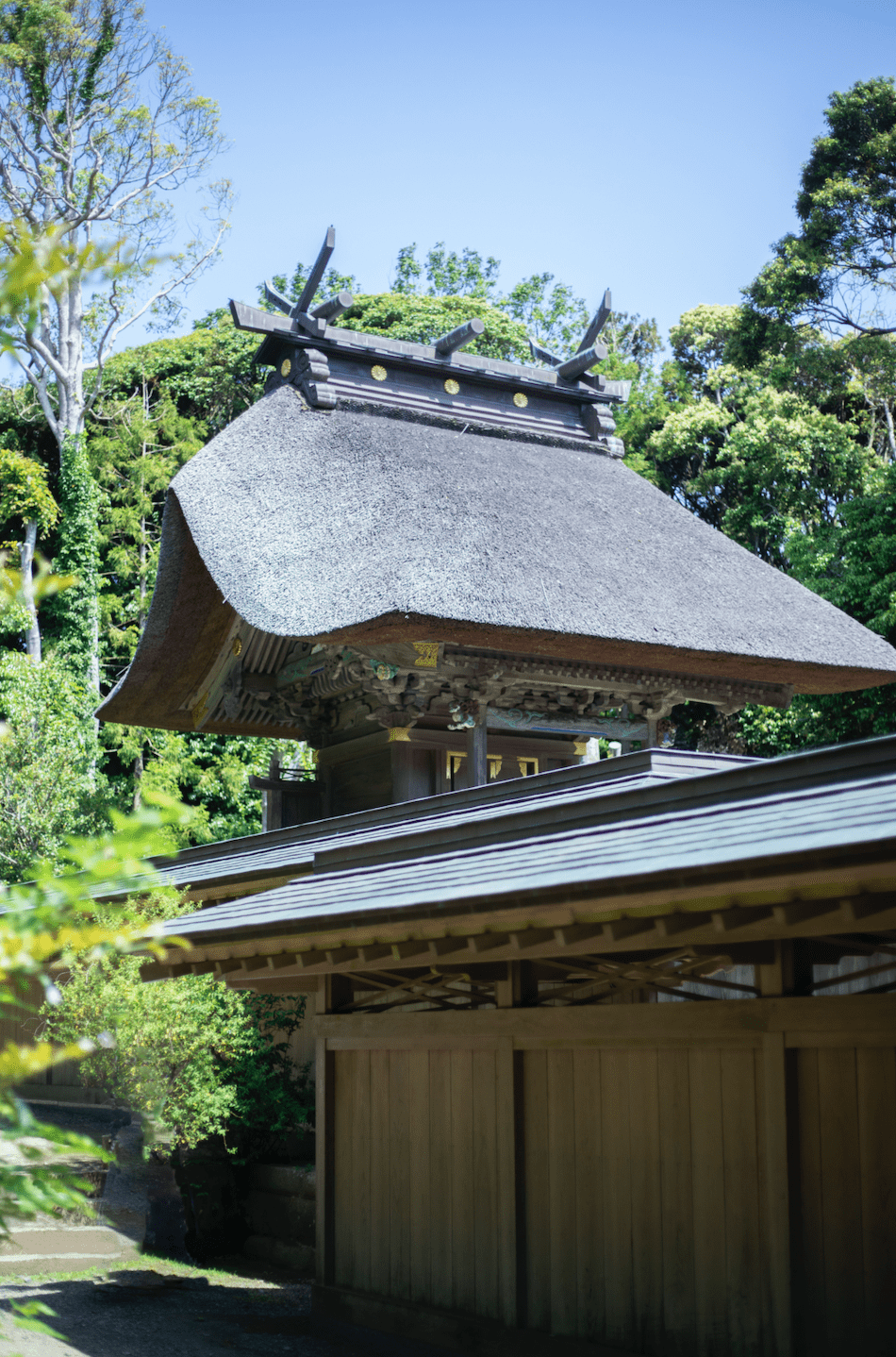
7. Oarai Isosaki Shrine
Oarai Isosaki Shrine is Oarai’s namesake – not the other way around. This historic shrine on a hill overlooking the coast has an ancient history that, despite its age, can be traced back to its exact founding day, December 29, 856.
Its most famous structure is Kamiiso-no-Torii, a white torii gate that faces Oarai’s rugged coastline. Photographers gather here in the early hours to catch one of Japan’s most stunning sunrise sceneries. The shrine itself displays some unique architectural peculiarities that, with good timing, one of the shrine priests will be happy to explain.
More info: oarai-isosakijinja.or.jp
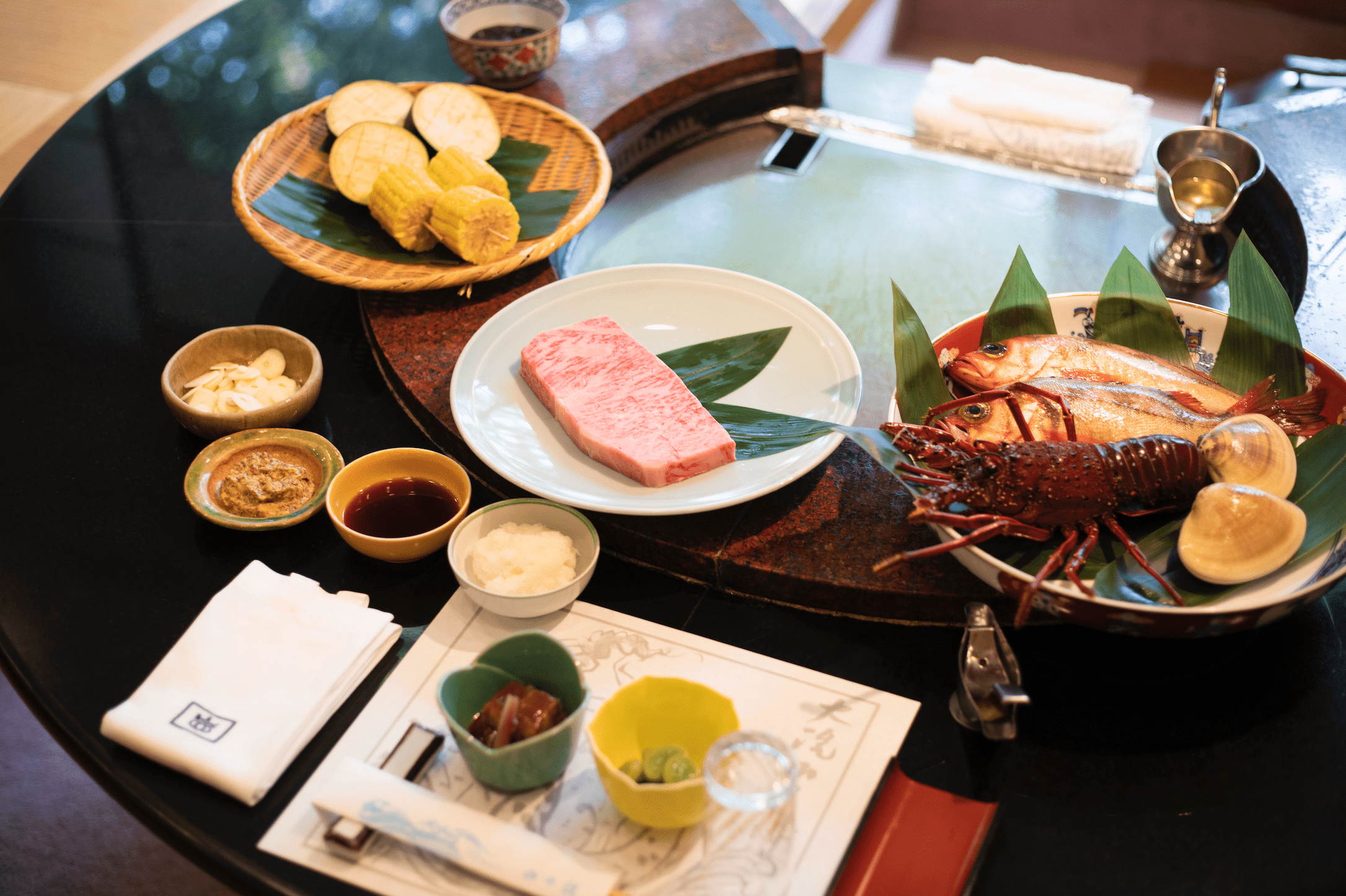
Where to Dine: Yamaguchirou Oarai
For exquisite Japanese meals featuring seasonal ingredients from both land and sea, look no further than Yamaguchirou’s secluded Oarai location. One of its highlights is teppanyaki dining al fresco (best to enjoy from May to October). Enjoy a view of the ocean through the pine trees while dining on freshly grilled seafood and Hitachi beef. Guests can also stay in one of the exclusive six rooms at the inn – perfect for golf fans as Oarai Golf Club is next door. Note that Yamaguchirou’s flagship restaurant, founded in 1872, is in Mito city.
More info: yamaguchirou.com
Where to Stay: Satoumitei Kinparo Hontei
Satoumitei Kinparo Hontei’s clean design is a perfect fit for its extraordinary ocean-side location. Its quiet location and limited number of rooms makes it the perfect getaway destination. Experience soaking in a soothing bath filled with spring water from Mt Oarai with a view that – from the right angle – looks like it spills right into the sea.
More info: www.satoumitei.jp
Tsukuba Area: High Tech Headquarters with a Historical Touch
Home of JAXA and the University of Tsukuba, and internationally lauded as a high tech research center, Tsukuba can seem like it’s all about the future. The truth is that it stands side by side with the history that made its present possible.
8. Cyberdyne Studio
To get a firsthand look at some of the world’s leading robot technologies, head to Cyberdyne Studio on the second floor of Iias Tsukuba shopping mall. Cyberdyne is the developer of HAL (Hybrid Assistive Limb), a wearable cyborg-like robot that helps users expand their physical capabilities. It is increasingly used for treatment of patients with physical disabilities. Make a reservation to receive a guided tour of the facility that includes a chance to test HAL’s mechanisms yourself. English guidance available, tour fees apply.
More info: www.cyberdyne.jp/studio/index.html
9. Tsukubasan
Towering at 877 meters high, Mt Tsukuba is one of Ibaraki’s top hiking destinations. Gaze across the Kanto plains and see as far as Mt Fuji (weather conditions permitting) from the mountain’s summit. There are several trails to the top, the longest taking about two hours. Many people choose to take the ropeway down as the steep incline can be difficult to navigate after rain.
More info: www.mt-tsukuba.com
Where to Dine: Touemon
Touemon and its neighboring bakery Kurabiyori are the ultimate in rural elegance. The complex hides a treasure trove of secrets and surprises – soba pasta is one of them – and serves fine Italian fare in a traditional house that is almost 200 years old. It’s the perfect stopping point on the way to or from Mt Tsukuba and many guests arrive by bicycle.
More info: touemon.com
Where to Stay: Tsukuba Grand Hotel
Head to this delightful traditional inn to offset the modern vibes of central Tsukuba. Soothe aching muscles after a climb up Mt Tsukuba in one of the hotel’s hot spring baths, one of which boasts panoramic views of the neighboring area. Don’t miss the urushi-e gallery, a stunning display of traditional Japanese art.
More info: tsukuba-grandhotel.co.jp/english/
Western Ibaraki: A Taste of Tradition
A visit to Ibaraki’s western region may feel like traveling back in time as ancient customs and crafts are still alive and well.
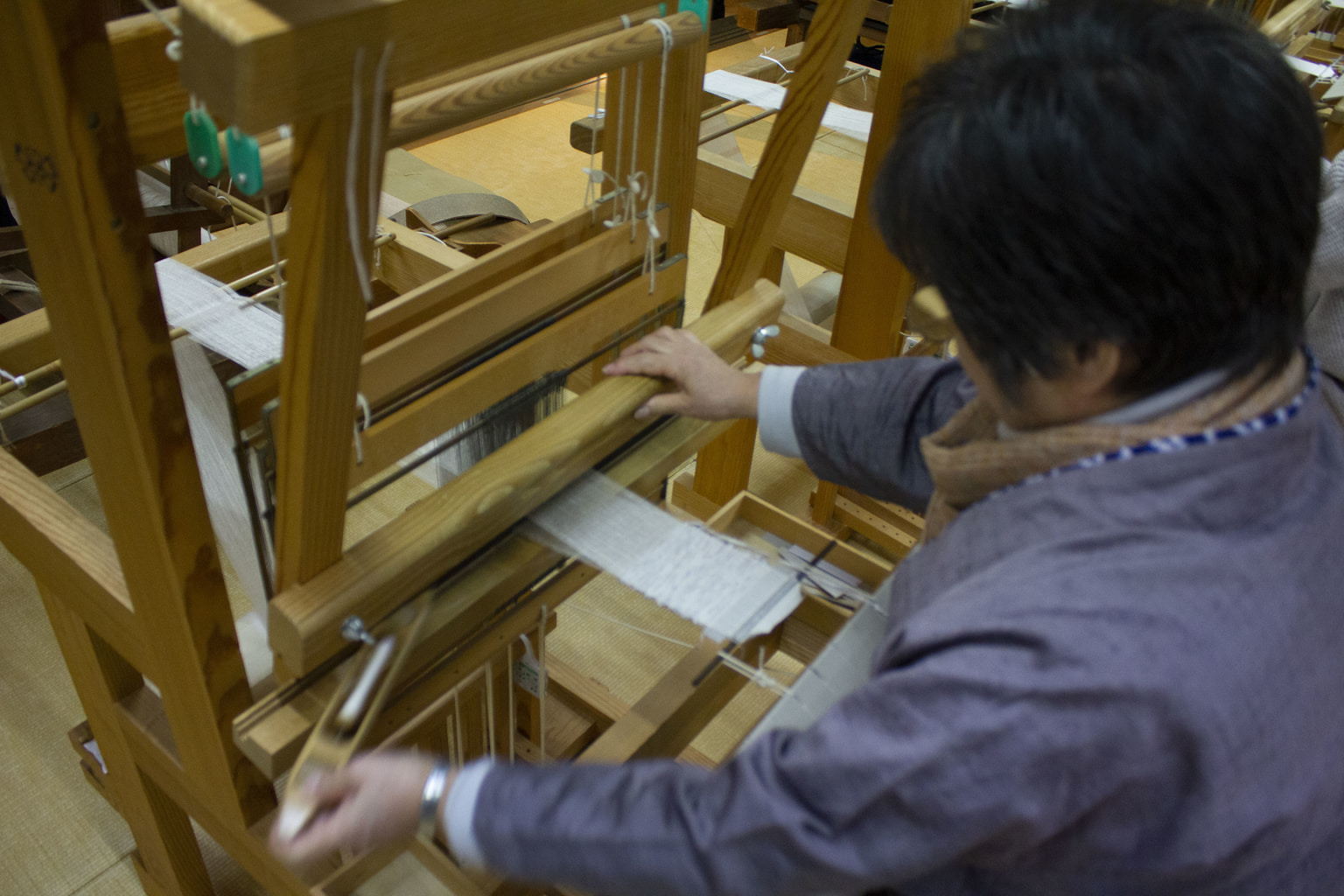
Photo by Lisa Wallin
10. Tsumugi no Yakata
This facility is dedicated to yuki tsumugi, a silk weaving technique that hails from Yuki city and is a designated UNESCO Intangible Cultural Heritage of Humanity. Here, visitors can discover the beauty of this ancient art that dates back more than 2,000 years and learn the time-consuming work involved to make just one kimono. There are also silk thread coaster workshops, but do check the website in advance for details as these are currently subject to change. Don’t forget to drop by the complex’s shop, which sells a stunning array of luxurious, locally made silk accessories.
More info: yukitumugi.co.jp
Where to Dine: Kokyu
Seasonal vegetables are the main focus of Kokyu’s menu, which offers a selection of course meals in a traditional house from the Showa era. Most ingredients are sourced in either Ibaraki or neighboring Tochigi. Reservations required for both lunch and dinner. While staff only speaks Japanese, they are happy to serve guests from all over the world.
More info: kokyu.in
Where to Stay: Hotel Sansui
Nearing its centennial anniversary, Hotel Sansui has spent the better part of a century serving visitors to Koga. The hotel has a lovely traditional Japanese feel, while most of the rooms are Western-style. English-speaking staff available.
More info: hotelsansui.co.jp/en/
To book a taxi tour to some of the spots mentioned in this article, go to english.ibarakiguide.jp/taxi-top.html .
Sponsored Post
Related Posts
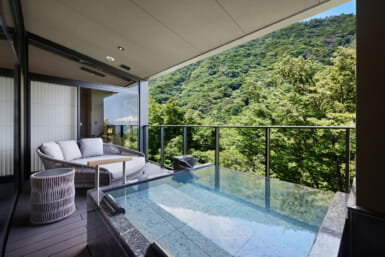
A Private Onsen in Hakone Worth the Visit: Hatsuhana
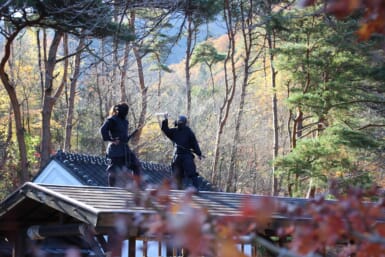
8 Places to Experience the Ninja Lifestyle in Japan
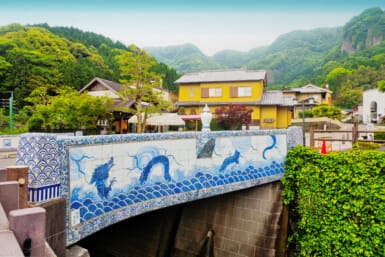
Living History in Okawachiyama: The Village of Secret Kilns
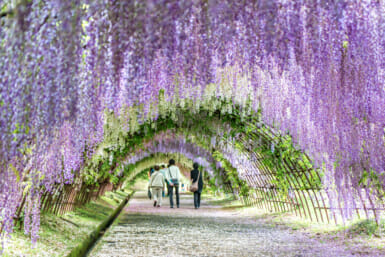
5 Stunning Tokyo Flower Festivals Happening in May 2024

Tara: A Mystical Oceanside Town Where You Can Feel the Moon’s Power

Super Delivery International: Bringing Japan to Your Door

Stay in Style at DoubleTree by Hilton Kyoto Station

A Culinary Wonderland in Hyogo Prefecture

20 awesome things to do in Ibaraki Prefecture
By: Author Brittany
Posted on Last updated: November 8, 2019
Ibaraki is a special place. Just over an hour from Tokyo by train, it’s a perfect escape from the bright lights and fast pace of the big city. This is the agricultural heart of Japan, where hardworking farmers grow flavorful produce, deep-seated traditions lend themselves to fabulous festivals, and the natural scenery is something out of a movie. If you want to escape Japan’s typical tourist destinations in favor of a more authentic and local experience, the Ibaraki Prefecture needs to be on your list. With waves to surf, mountains to hike, shrines to visit, waterfalls to chase and amazing food to eat, what more could you ask for? Here are my top recommendations of things to do in the Ibaraki Prefecture.
Note: This post contains affiliate links. If you click on one and make a purchase, I may earn a small commission.
The best way to get to Ibaraki Prefecture
When I visited Ibaraki Prefecture, I took the Super Hitachi Express from Ueno Station in Tokyo to Mito, Ibaraki. The journey lasts 1 hour and 22 minutes and is an easy trip if you have the JR Pass (buy yours here ). Alternatively, you can buy a one way or round trip ticket from Tokyo to Mito here .

Prefer to travel by bus instead of train? Traveling by bus will get you from Tokyo Station to Mito Station in 1 hour and 43 minutes. JR Bus Kanto is covered by a Japan Rail Pass or you can purchase tickets individually online or at a JR Expressway Bus window. Check the timetable or buy your tickets here .
Top things to do in Ibaraki Prefecture
1. check out the famous torii gate in the pacific ocean.
The Kamiiso-no-Torii is the outermost gate of the Oarai Isosaki-jinja shrine. The shrine was first built in 896AD, destroyed in the mid-1500s and rebuilt in 1690. The name of the gate is translated “gate at the beach of the gods,” and it’s said this is the spot where the gods came down.
If you visit on January 1, wake up extra early to watch the sun rise directly between the two arms of this gate.
Although it’s an incredibly Instagrammable spot, be sure to maintain your distance behind the stone marker. This area is sacred and it’s also known to have unforgiving currents and surprisingly strong waves.

Kamiiso-no-Torii on the Pacific Ocean
2. Practice Shinto gratitude
In Japan, multiple religions have peacefully coexisted for more than 2,000 years. The main religions here are Buddhism and Shintoism. While many people know about Buddhism, less is known about Shintoism. I’ve been told that Japan has as many as 8,000,000 gods, including the newest one – a sweet potato god whose shrine is set to open November 23, 2019!

Oarai Isosaki Shrine
The basis of the Shinto religion is to notice the divine in nature and practice gratitude in all things. In a region this beautiful, there are reminders to be grateful all around you.

gods on a stone wall at the Oarai Isosaki Shrine
3. Enjoy a lunch that is out of this world good!
At Tsuki Cafe (tsuki means ‘moon’ in Japanese), you’re guaranteed an incredible experience from the moment you arrive. The cool sea breeze greets you in the parking lot, and the seats in this family-owned (and family-built!) restaurant look over the ocean – full of surfers catching a wave. The husband and wife team traveled around Japan looking for the perfect venue to open their restaurant and pottery business, and I can see why they decided to build here!

Tsuki Cafe – meals served in homemade pottery
Choose from wood-fired pizzas, a selection of sushi or sushi bowls, salt-crusted fish, or a bento box if you’re lucky. They only make 5 per day, so get there early if you want to try one!

Tsuki Cafe bento box
Choose a drink from the entry area, where a selection of handmade pottery sits waiting to be filled with mugicha (barley tea), green tea or water. The restaurant is open all summer long, but during the rest of the year, the couple who run the place make pottery. The pottery is sold or used as serving dishes at their restaurant.
I got lucky with a bento box and loved trying a selection of raw and cooked fish, rice with seaweed and tempura vegetables. Of course, we finished up with dessert, ordering everything on the menu! Their mizuyoka (sweet bean jello) is firm and pairs well with the blueberry cream cheese whipped cream on the side! And their cheese cake was really nice, too! Light and fluffy – not too heavy for the beachside venue.

Mizuyoka (sweet bean jello)
4. Go crazy over anime in Oarai
In the town of Oarai, you can’t go far without noticing anime characters displayed on signs in shop windows. The anime “Girls und Panzer” (that’s tanks in German), is set in the town of Oarai. The creator of the anime has replicated the town from street signs to the shape of trees as the setting of the animated series. In it, high school girls in short skirts practice tank warfare as a sport.

Girls und Panzer float in Oarai
The town of Oarai was heavily affected by the earthquake and tsunami in 2011, and the revenue from the anime series has helped the town bounce back. From the shrine to the local coffee shop, you’ll see signs featuring the anime series everywhere!

Girls und Panzer sign at the Oarai Isosaki Shrine
Don’t miss the anime-decorated prayers at the Oarai Isosaki Shrine.

Anime wishes at the shrine
Be on the lookout for the themed race car in town, too!

Girls und Panzer car
5. Celebrate at a local festival
Because there are so many gods in Japan, it’s likely that you’ll visit during a religious festival! During these festivals, you’re sure to see men, women and children marching or dancing their way through town.

Dancers at the Isobushi Parade
I had the honor of visiting Oarai during the Hassaku Festival and Isobushi Parade, held yearly on the last weekend of August. I wore the yukata (summer kimono), and learned a dance which mimics the movements of fishermen.

Wearing the yukata at the Isobushi Parade
Chants of wasshoi from children who parade their school-made float through town ring out and the anime fans pull (yep- the floats are all man-powered!) a tank through town that “attacks” local buildings just like in the anime series. You can also see portable shrines, where the gods may be moved for the festival and driven through town.

Shrine float at the Isobushi Parade
6. Don’t forget to try the street food!
Festivals are a hotspot for street food. Throw all the Japanese rules about not eating and walking out the window… this is a time to let loose! Cool down with shaved ice and satisfy a sweet tooth with a chocolate-filled taiyaki.

Street food at Hassaku Festival
Or have SOY much fun with a mitsudango soy bean dumpling, sweetened with soy sauce and sugar. The dumplings are chewy, like a cross between mochi and a bao bun, and the sauce is just sweet enough!

Mitsudango dumplings
7. Visit the Fukuroda Falls
Winter, spring, summer or fall… you’re gonna want to visit this place every season! The four-tiered waterfall is absolutely breathtaking. Walk up a cool tunnel, and you’ll hear the falls before you see them. The rushing water is the definitely of a peace-filled kind of power.

Fukuroda Falls
After admiring the Fukuroda Falls from three levels of viewing platforms, head down to the suspension bridge to see the falls from another perspective. Tear your eyes away from the waterfalls and look in the river on the other side of the bridge. Remember what I said about power? Those GIANT boulders came down that “peaceful” waterfall.

Fukuroda Falls suspension bridge
8. Learn to make oyaki in an abandoned schoolhouse
The population in Japan is increasing in age, and less children means empty schools. The owners of Daigo Oyaki School decided to use this building to further education of adults and children in the kitchen! Get ready, because the Daigo Oyaki School is going to feed your creative side as well as your stomach!
Oyakis are a Japanese stuffed dumpling, created to preserve food in areas like Daigo, where winters are a frozen affair. Here, you can taste oyaki filled with locally produced ingredients like mushroom, cheese, red bean, radish, pumpkin, apple or eggplant. Or, you can join a class and learn how to make your own!

Daigo Oyaki School
I made pumpkin and apple oyakis and loved trying out my kawaii artist skills. One went well… and one looks like a scary Hello Kitty. Thankfully, they all tasted great!

9. Eat lunch in a hand-built log cabin
Did you know that people can own a mountain? Well, it turns out, you can!
The couple that run Cafe Ayu Yumori own a mountain, and it’s from that mountain where all the wood for the adorable log cabin cafe is harvested. They cut down the trees, removed the bark, and over the course of 10 years, built the structure that’s standing today. The cozy cabin is decorated with Totoro statues, and visited by customers who are in the know about this word-of-mouth cafe.
And if that’s not impressive enough, the view is the reward for the winding roads you must drive to get to the cafe. Well.. the views and the coffee, lunch and selection of cakes!

Cafe Ayu Yumori views
10. Shop local at a roadside station
I thought something must have been lost in translation when I saw “visit a roadside station” on my itinerary. The Ibaraki Prefecture curated an incredible foodie itinerary for me… and then they included a highway rest stop?! In the US, rest stops are a place where you want to rest as quickly as possible. (Except for the gas station tacos in Dallas , but that’s another story.) But here in Japan, roadside stations are a culinary destination where foodies can find regional products and get great deals on local produce. And in a country where two melons just sold for over $45,000USD , any deal is a good one!
At Hitachiomiya Kawa Plaza, I oohed and ahhed over perfect peaches and $15USD cantaloupe. The Japanese take their fruits seriously and employ a sweetness scale, determined by a special light to decide whether the fruit is good enough to sell.

Melon at Hitachiomiya Kawa Plaza
Outside Hitachiomiya Kawa Plaza, families swim in the river and fishermen cast a line. In the food court, you can buy lunch or delicious gelato… which brings us to our next awesome thing to do in Ibaraki!
11. Chill out with gelato
The creative (and super kawaii) team at Gelato & Smoothie are dreaming up unique gelato flavors using local ingredients. You might have guessed that you can find gelato flavored with local milk and green tea. But could you imagine an Ibaraki tomato and lemon gelato? What about gelato flavored with wild sesame harvested from the banks of the Kuji River? Other seasons bring corn or pumpkin flavored gelato. They’re giving Trento, Italy’s uniquely flavored gelato a run for its money!

Gelato & Smoothie cones
Gelato & Smoothie is a shop that will keep you coming back for more, because the flavors are constantly changing.
I had the chance to go behind the scenes and see the gelato-maker in action. The base is Ibaraki milk from Mizuho Farm, mixed with seasonal ingredients.
Check out the cute video promoting the shop as you wait in line for your scoop (which is the most beautifully scooped ice cream ever). You can tell the team has fun with what they do, and their joy is evident in the product!

Gelato & Smoothie
12. Eat a famous apple pie
Ibaraki is known for being an agricultural hub in Japan. The climate is perfect for growing, the soil is rich, and the produce is flavorful. The apples are no exception. It’s this high quality fruit that’s used in the famous apple pie from Daigo. Before you visit Fukuroda Falls, stop by this stand outside the Honen Mansaku ryokan and pick up your apple pie. It sells out, and I promise you won’t want to miss this!
The apple pie is sold piping hot and it’s best to eat right away. The apple filling is sweet and the flaky pastry is melt-in-your-mouth good. And it’s topped with a sweet apple glaze. It doesn’t get much better than this!

Daigo apple pie
13. Learn how sake is made (and taste some, too!)
Kanpai! I’m sure you’ve tried sake while traveling through Japan… but do you know how it goes from being a grain of rice to the clear (or cloudy) beverage responsible for your hangover?
Pay a visit to Kikusakari, a family-owned business that’s been brewing sake since 1823. At this location, the master brewer is responsible for the process which will yield 50,000 bottles of sake. While I’ve learned all about the wine-making process and have visited dozens of beer breweries , the precision required for sake is next level.

Kikusakari tour
From the percentage of rice that needs to be polished away, to the number of seconds the rice should soak in water, this is a process that’s measured on a micro scale. Steamed, rinsed and cooled rice is moved into a “sauna room,” where koji mold is added and a change in temperature could wreck the whole process. Yet again, the mixture is moved and the shubo (mother) is added to koji, steamed rice, yeast and water (in a similar process to making sourdough bread). The mixture is fed more koji, steamed rice, yeast and water over a 4 day period, and then it’s moved to a big tank to ferment for a month. After that… it’s ready to drink!

Sake tasting at Kikusakari
Love sake? Make a reservation at the on-site soba restaurant , where the menu is created to pair with Kikusakari sake!
Fun fact: Want to know if you’re buying new or old sake? When a new vintage is introduced, a new sugidama (cedar ball) is hung outside the front door of the brewery. If the ball’s green, you’re getting fresh sake. If it’s brown? That’s last year’s brew!
14. Be a beer brewer for a day
Kikusakari is one arm of the Kiuchi Brewery. Hitachino Nest Beer is the other. Their beer is exported globally and has been called some of the best beer in the world.

Hitachino Nest – Japanese Craft Beer
Want to put your own spin on a 190-year-old secret recipe? Join their beer making experience where you’ll go through the process of making beer and adding your favorite flavors before handing your brew over to the master brewer, who will complete the process. Then, 2-3 weeks later, your beer is bottled and shipped to your home. It’s a double bonus – you don’t have to put it in your suitcase, and your holiday gets an extension when a little bit of Japan arrives at your doorstep!
15. Sip coffee like a shogun
The last shogun is responsible for bringing coffee to Japan, and he was particular about his brew! While in Ibaraki, I had the opportunity to meet Mr. Suzuki, founder of Saza Coffee . Mr. Suzuki is friends with the grandson of the last shogun, who graciously gave him the recipe and his blessing to share shogun coffee with the world.
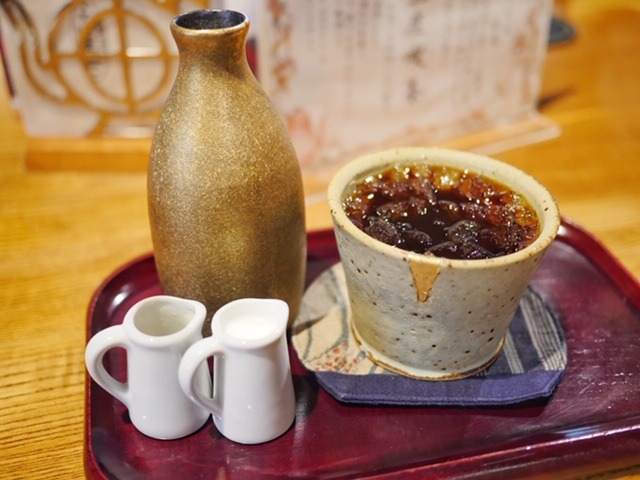
Shogun coffee at Saza Coffee
The coffee is rich and strong, and when you order it at a Saza Coffee café, it comes in a golden carafe with a non-alcoholic Brandy sweetener. This is a must-try in Ibaraki Prefecture, where shogun coffee is a liquid link to the final shogun. Saza Coffee is being hailed as a frontrunner in the fourth wave coffee movement . This is your chance to be a trendsetter!

Saza Coffee
16. Marvel at the rice fields
There is no green like the green of a rice field. I learned a great saying while in Ibaraki. When the rice is heavy and ready for harvest, it bows. In a similar way, CEOs and leaders should be humble, realizing how much they have. What a great lesson in humility from a plant that feeds this nation!
17. Book a photoshoot at the most Instagrammable hotel in Ibaraki
Did you know that I used to be a wedding coordinator? That’s right – in a tiny town in Texas, I helped brides on their biggest day and I loved every second!
At Hotel Crystal Palace in Hitachinaka, the hotel was designed with weddings in mind and I loved every second of my stay there. If you’re planning your big day, the hotel offers a studio with more than a dozen backgrounds for wedding or engagement photos.

Photo set at Hotel Crystal Palace
And if you’re planning your wedding in Japan, you can hold the big day in the stunning chapel next door and bring the party back to the Hotel Crystal Palace.
18. Try soy sauce ice cream
Kurosawa Soy Sauce Factory began as a grain distributor in 1905 and within one year, they were producing soy sauce in their warehouse. This family-owned business is now run by the fourth generation and 15 years ago, they expanded their products to include soy sauce ice cream.

Kurosawa Soy Sauce Factory ice cream options
Ok, it sounds weird, but hear me out! You’ve tried salted caramel ice cream, right? It works because it’s salty and sweet. At the first bite, I was unsure, but once I got over the initial “oh my gosh, it’s soy sauce” shock, I found that I couldn’t stop eating it. I’m usually a slow eater when it comes to ice cream, but I won the clean plate club at Kurosawa! In addition to soy sauce ice cream, they also offer a range of soy sauce pudding, soy sauce chiffon cake and miso pudding in the sweet department. In the savory range, you’ll find a soy sauce to pair with every type of dish!

Kurosawa Soy Sauce Factory
19. Frolic in a field of kawaii flowers
At Hitachi Seaside Park , every season holds a new surprise. The park is comprised of 350 hectares (or roughly 654 football fields) worth of flowers, greenery, bike trails, a BMX course, an amusement park and so much more.
The sunflowers were in full bloom when I visited in August and I thoroughly enjoyed getting Instagram-girl lost in a field of sunflowers!

Hitachi Seaside Park sunflower field
Next to the sunflower patch, a field of 350,000 zinnias add a pop of color to the park.
Perhaps my favorite part, though, are the nearly-neon green kochias. To quote Agnes from Despicable Me , “It’s so fluffy I’m gonna die.” Thirty-two thousand fluff balls cover the hill. So much fluff. In October, these fluff balls will transform from green to pink to brilliant red.

Hitachi Seaside Park
In spring, 4.5 million nemophila or baby blue eyes bloom on that same hill. Tourists come in droves to snap a photo with their favorite flower. And if you visit in late August, be sure to check out the kochia light up nighttime event!
The government owns Hitachi Seaside park, and it’s incredibly affordable at only ¥450 per person. With entry fees that affordable, you can enjoy all the onsite cafes, take a ride on the hop on, hop off seaside train, or rent a bike to explore the park.
Join a tour to Hitachi Seaside Park!
Book this tour for 10% OFF this very floral day! You’ll get a chance to see flowers at Ashikaga Flower Park and Hitachi Seaside Park on this day trip from Tokyo, complete with a BBQ lunch!
Book this tour which is another day trip from Tokyo to see Ashikaga Flower Park and Hitachi Seaside Park. The lunch option includes all you can eat from a choice of 130 different types of sushi, yakiniku and desserts.
20. Watch Japanese baseball
Did you know that Ibaraki has a baseball stadium? Join up to 25,000 fans at Hitachinaka Stadium to catch a Japanese baseball game ! Book your tickets here .
Where to stay in Ibaraki
Hotel terrace the garden.
Just steps from the JR Mito Train Station, Hotel Terrace The Garden Mito is the ideal accommodation for your stay in Mito. From the moment you enter the hotel, you instantly feel ensconced in luxury, with a sprawling lobby and an impressive spiral staircase. The friendly staff at the front desk greets you and gives you your room key as well as a pass to enjoy breakfast.

Mito Hotel Garden The Terrace entrance
I had the luxury of staying in a suite, and if I didn’t have a schedule full of so many fun things to do in Ibaraki, I never would have left the room! The deep soaking tub and a host of high-quality products were calling my name after an evening dancing in the parade.

Mito Hotel Garden The Terrace suite
Although Hotel Terrace The Garden Mito excels at big things like a comfy bed and a plethora of bathroom amenities, they don’t overlook the small stuff. In the room, you’ll find a cell phone, loaded with things to do in the area and an option to take photos that will be emailed to you.

Phone at Mito Hotel Garden The Terrace
At onsite restaurant, Il Bancale, you can choose local or Western options for breakfast. Whatever you choose, make sure your morning coffee is Saza Coffee!

Hotel Crystal Palace
Hitachinaka.
My second night in Ibaraki, I moved to the Hotel Crystal Palace in Hitachinaka. Walking into the lobby, you’re greeted by the tinkle of wind chimes and an expanse of live plants.

Hotel Crystal Palace Ibaraki
At check in, I received my room key, breakfast pass, and a pass to the ramen bar, in case I needed a late night snack! I arrived in my suite to a kind welcome note and origami with sweet treats inside each paper crane!

Origami at Hotel Crystal Palace
Like Hotel Terrace The Garden Mito, Hotel Crystal Palace also offers a cell phone for guests’ usage.

Hotel Crystal Palace Handy telephone
The proximity to Hitachi Seaside Park makes it a fabulous choice for guests interested in visiting the famous park. And the special touches of comfort make it the best place to unwind after a long day of exploring. Put on the provided yukata for a trip to the sauna and hot spring bath, or stay in your room and take advantage of the delicious-smelling bath products and comfy bed.

Hotel Crystal Palace bed in suite room
Dinner with the city council and the inbound tourism task force
The evening I stayed at Hotel Crystal Palace, the Hitachinaka city council’s inbound tourism task force invited me to dinner. They asked me to share my experiences as a blogger, what I thought about travel in Japan and advice on promoting inbound tourism in Ibaraki Prefecture.

And they served the most delicious, beautiful food, specially curated with local products and foods they thought I’d enjoy.
Here are a few of my favorites:

When the evening ended, I was stuffed with food and excited for the future of Ibaraki. The leaders in the community are committed to making Ibaraki a destination for tourists from around the world, and I’m so glad they’ve trusted me to share a little bit of their lovely prefecture with you.
When you’re planning your trip to Japan, I hope you will consider Ibaraki Prefecture. Get away from the hustle and bustle and really relax on your vacation. Immerse yourself in the agricultural hub of Japan and get back to nature. When you go home, you’re sure to have stories to tell for years to come of the kindness of the people, the amazing flavors of the food and the beautiful nature of Ibaraki Prefecture.
Ibaraki Prefecture hosted me on this trip. All opinions are my own and I’d never recommend anything to you that’s not awesome!
Don’t forget these awesome things to do in Ibaraki Prefecture! Pin this post for later!

10 amazing things to do in Ibaraki, Japan!
Jan 15, 2021
- Destination
- 10 Amazing Things
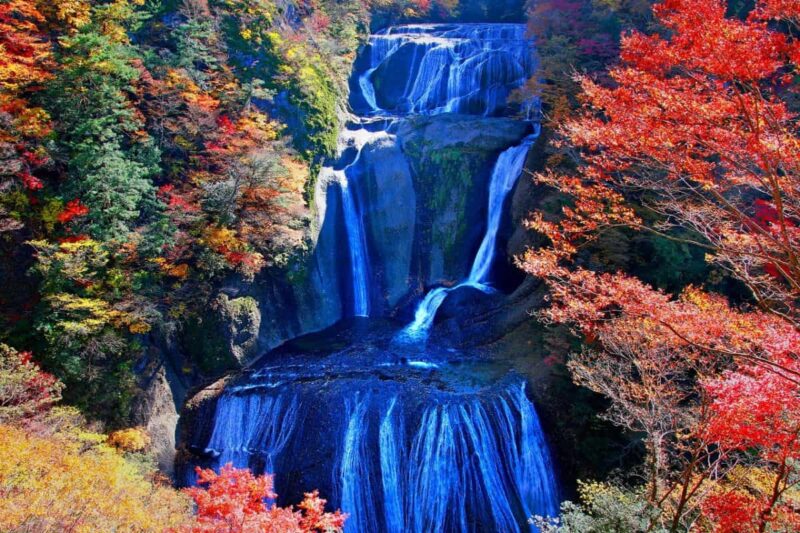
Ibaraki is only around 2 hours north-east of Tokyo, and it is home to many great sightseeing spots like parks, waterfalls, gardens, shrines, temples, and breathtaking natural landscapes.
It is only around two hours north-east of Tokyo, and it’s perfect for a day trip from Tokyo. Ibaraki is known as Japan’s no.1 producer and consumer of Natto , the sticky and stinky fermented beans. It’s also the birthplace of Aikido , a Japanese martial art. The most famous flower park in Ibaraki is the Hitachi Seaside Park, which is best known for its beautiful and gorgeous Nemophila in spring and Kochi in fall.
Brimming with beautiful nature and interesting tourist destinations, how about visiting Ibaraki to have both, an extraordinary, yet a novel adventure?
How to get there
Recommended sightseeing spots in ibaraki:, hitachi seaside park, ushiku daibutsu, kairakuen garden.
- Oarai Isosaki Shrine
Fukuroda Falls
- Ryujin Gorge
- Kashima Jingu Grand Shrine
Mt. Tsukuba
Hananuki valley, lake kasumigaura, ibaraki’ s best local treats:.
Ibaraki is only 2 hours away from Tokyo, and it is accessible by trains, highway buses, and planes. The main transportation hubs in Ibaraki are Mito Station, Tsukuba Station, and Ibaraki Airport.
Some of the best ways to get to Ibaraki from Tokyo is by using the JR Joban Line from Ueno Station, or you can use the JR Narita Line to access major stations in Ibaraki with the JR Narita Line. You can also take the Tsukuba Express Line from Asakusa to Ibaraki.
The recently opened Ibaraki Airport offers domestic flights to Fukuoka, Sapporo, and Kobe, as well as international flights to Seoul and Shanghai.
Recommended sightseeing spots in Ibaraki
Although Ibaraki is often overlooked for its more famous neighbors, the prefecture is blessed with many beautiful natural features, and serves as a major historical and cultural center for Japan.
The prefecture is worth to visit if you’re looking for something off the beaten path, especially if you want to escape from the hustle and bustle of Tokyo. Some of the best spots to visit are the gorgeous Hitachi Seaside Park, a giant Buddha statue, and the twin peaks of Mt. Tsukuba.
Ready to plan your trip? Here are our picks for the best things to do in Ibaraki, Japan!
1. Beautiful sea of flowers at Hitachi Seaside Park
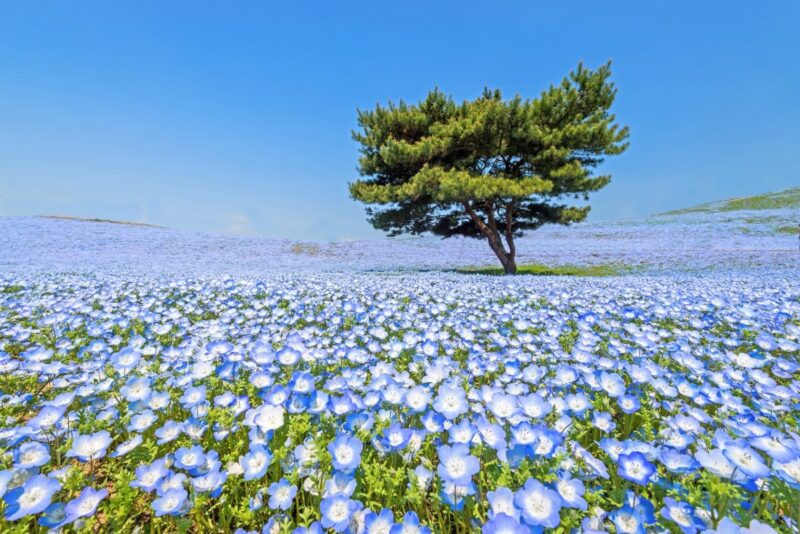
Hitachi Seaside Park is the biggest and the most popular flower park in Ibaraki, and it is best known for its beautiful nemophila in spring. The park has an area of 350 hectares, with 200 of which are open to the public.
The nemophila (baby blue eyes) flowers bloom in mid to late spring, and there are approximately 4.5 million flowers covering the park, creating a massive and spectacular baby blue carpet.

In addition to nemophila, Hitachi Seaside Park is also known for its beautiful kochia (summer cypress), which blooms in summer to early fall. The kochia trees are green in summer, and gradually turn a yellow-green and then gold, and become a vivid red in fall.
- Business hours : see the details here
- Admissions : see the details here
- Access : see the details here
Back To Index
2. See the giant Buddha statue : Ushiku Daibutsu
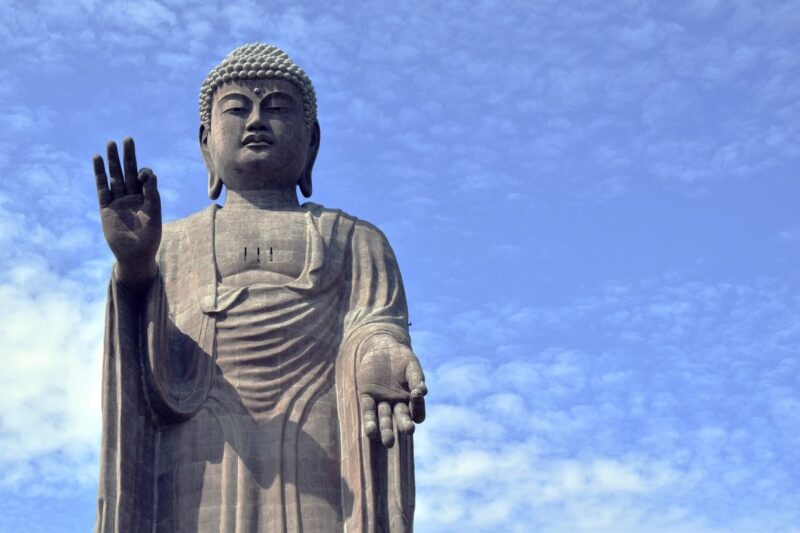
In addition to Hitachi Seaside Park, Ibaraki is also known for its massive Buddha statue called Ushiku Daibutsu. Ushiku Daibutsu is a 120 meter in height, and it holds the Guinness World Record for the tallest standing statue of Buddha.
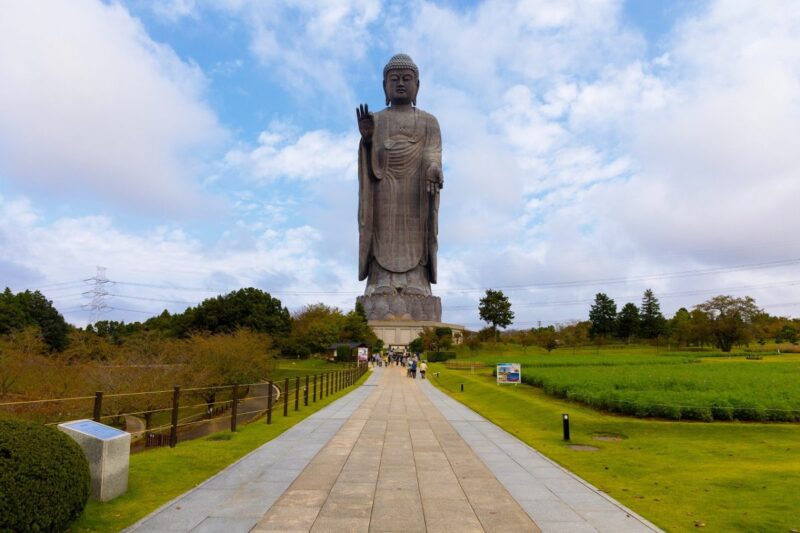
The view of the statue is impressive, and you can enter the inside of the statue if you also want. The entrance will take you to a series of floor levels with different displays and viewpoints, offering you more experiences than a simple observation deck.
The highest point you can go to is at 85 m (around chest level), which is accessible by elevator.
- Business hours : March to September 9:30 – 17:00 (weekdays), 9:30 – 17:30 (weekends and holidays) ; October to February 9:30 – 16:30
- Admissions : 800 yen (age 12 & above), 400 yen (age 4 – 12)
- Website (in Japanese)
3. Stop by the tremendous and gorgeous Kairakuen Garden
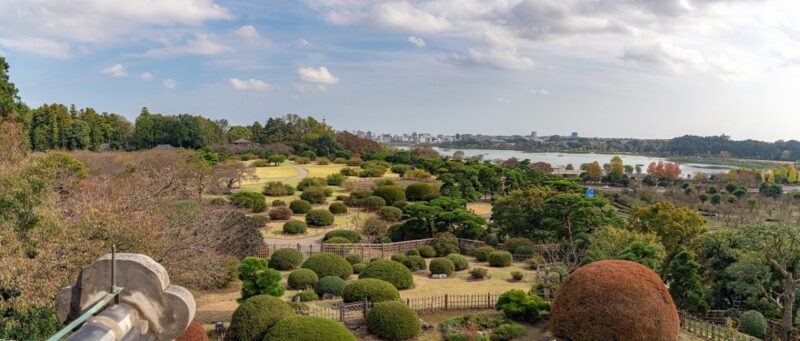
Kairakuen is perhaps the biggest and the most famous Japanese garden in Ibaraki, and it is also one of the “Three Great Gardens of Japan”, along with the Kenrokuen in Kanazawa, and Korakuen in Okayama.
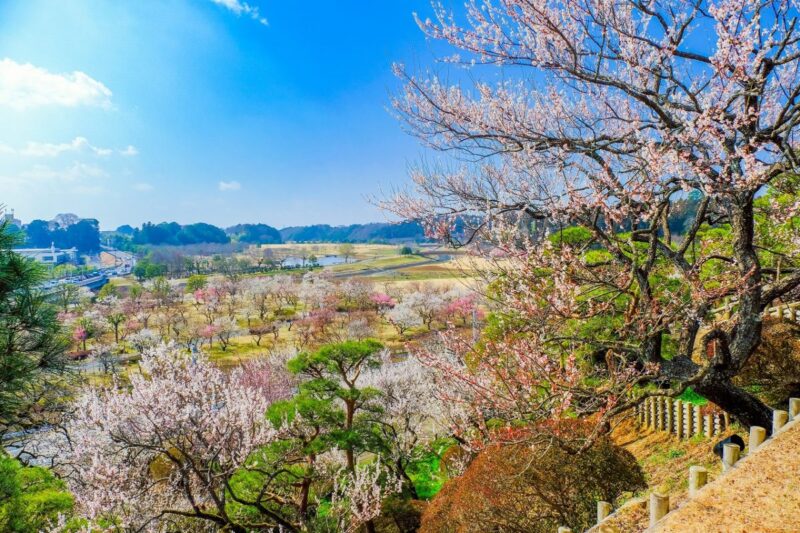
The garden has a 11-hectare of area, and was opened in 1842 by Tokugawa Nariaki, the 9 th feudal lord of Mito. The garden has thousands of plum trees, which blooms in early spring, creating a dainty pink carpet with its blossoms.
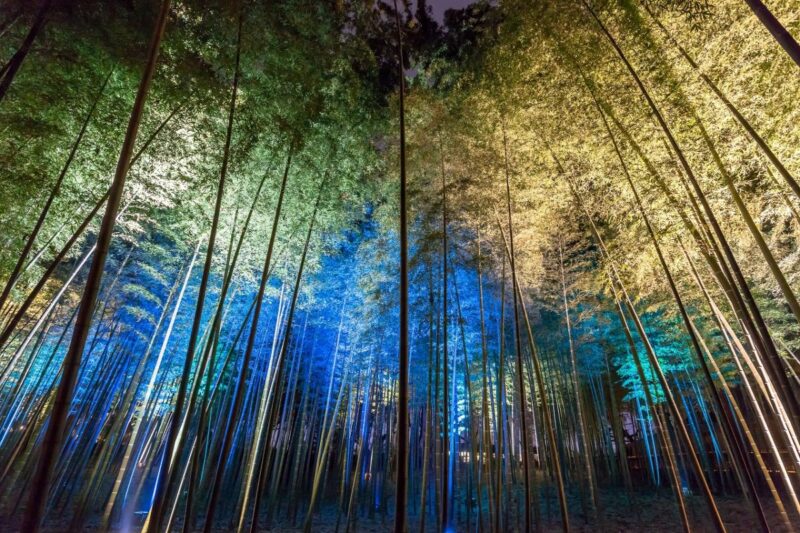
The garden is also known for its beautiful forest illumination, which is held every year in the fall.
- Business hours : 7:00 – 18:00 (October to February 19), 6:00 – 19:00 (February 20 to September)
- Admissions : 300 yen (age 15 & above), 150 yen (age 6 – 14)
4. Find your “Zen” at Oarai Isosaki Shrine
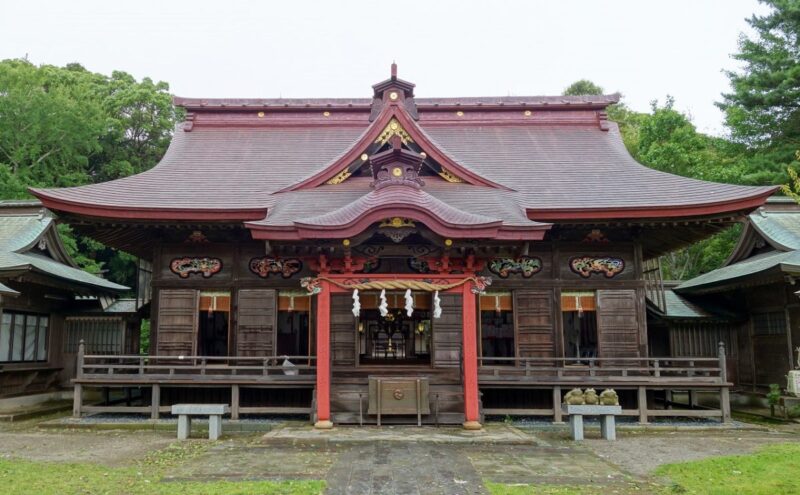
Oarai Isosaki Shrine enshrined Oonamuchi no Mikoto and Sukunahikona no Mikoto, two deities that created Japan.
Unlike other shrines, which are usually in a mountainous area, Oarai Isosaki Shrine is close to Oarai’s shoreline, and it faces the great Pacific Ocean with three torii gates.
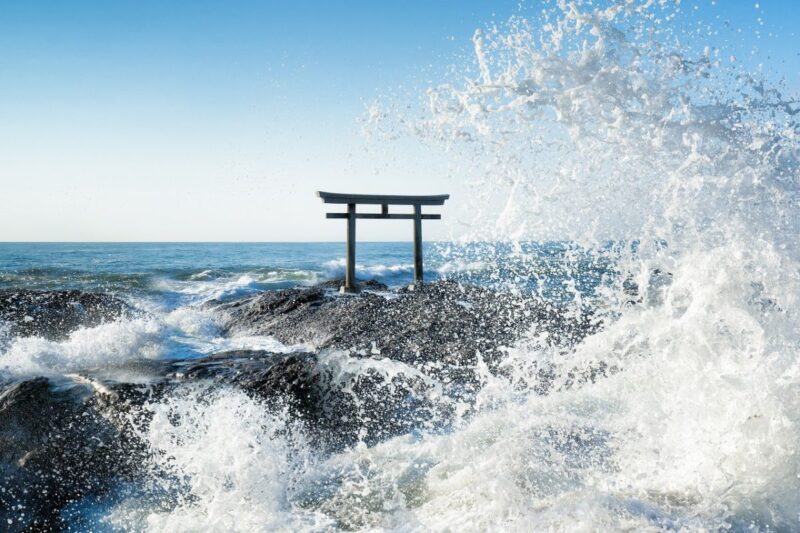
Among those three torii gates, the Kamiiso no Torii, was built in 1959 to commemorate the arrival of the deities. Situated on the reefs, the gate is facing the east and has become a popular sunrise spot in Ibaraki.
Ooarai Isosaki Shrine
- Business hours : 9:00 – 16:00
5. Witness the greatness of Fukuroda Falls
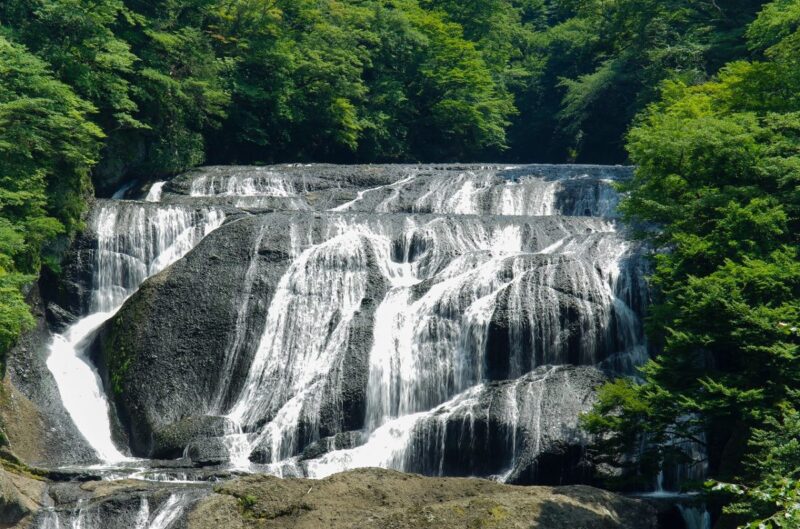
How about visiting Fukuroda Falls for its beautiful sights?
Considered as one of the three most beautiful waterfalls in Japan, Fukuroda Falls is one of the most iconic places in Ibaraki. The waterfalls is 120m high and 73m wide, and it cascades over four layers, looking dramatically different throughout the four seasons.
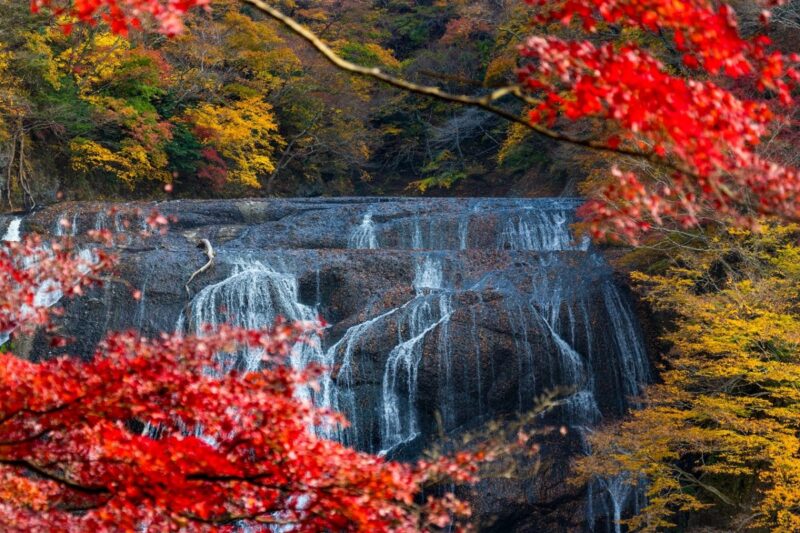
The best timing to visit Fukuroda Falls is in fall, where its surroundings are covered by the red autumn leaves but visiting it in the winter will give you a different sensation as the waterfall freezes. To see the waterfalls from up close, you need to go through a tunnel that takes you to the nearest viewing spot.
- Business hours : 8:00 – 18:00 (May to October), 9:00 – 17:00 (November to April)
- Admissions for the tunnel : 300 yen (age 15 & above), 150 yen (age 6-14)
6. Stop by Ryujin Gorge for its scenic view
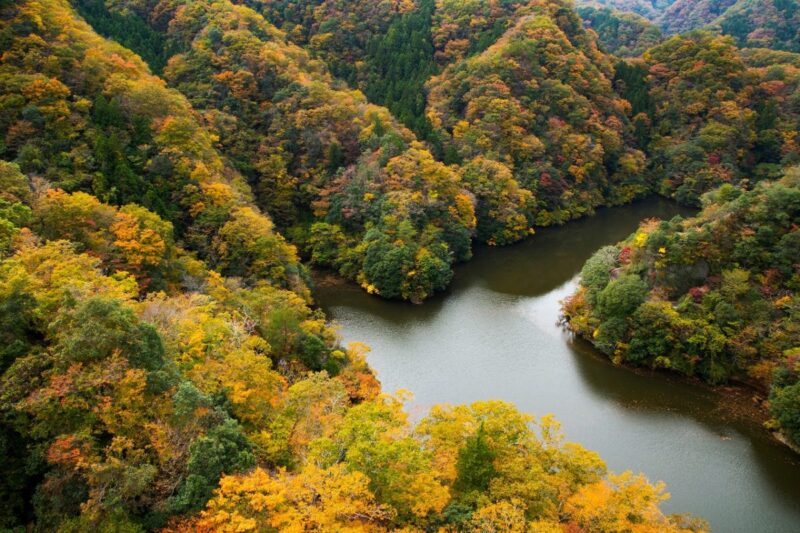
Ryujin Gorge is best known for its all-year-round spectacular view, but it is especially renowned for its incredibly beautiful autumn leaves. Ryujin Gorge has a lake called “Ryujin Lake”, which shape is said to resemble the shape of a dragon, and that is why the gorge, the lake, and the bridge that we’ll talk about, is named “Ryujin”.
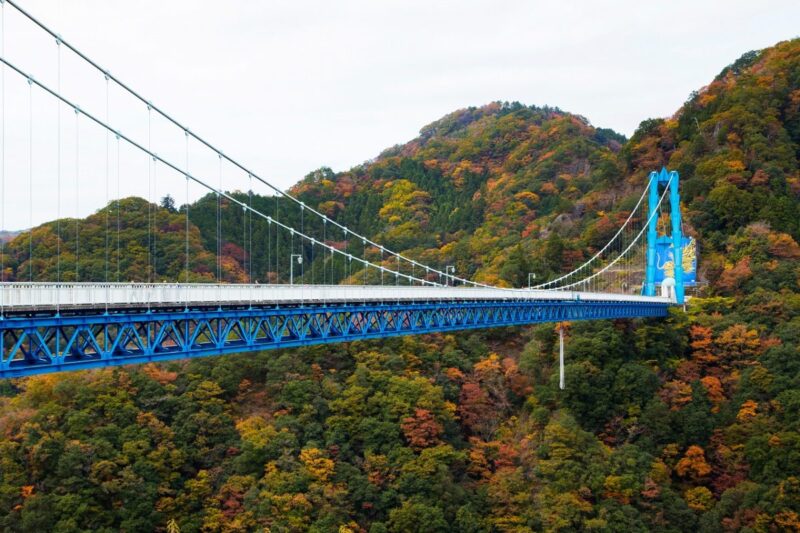
The Ryujin Suspension Bridge is a 375-meter-long bridge that connects two sides of the gorge, and it is known as the longest walkable suspension bridge on Japan’s main island of Honshu. The long bridge is striking with its azure blue hue and dragon art, and the bridge is decorated with thousands of carp streamers on May 5 (children day), and lined with hundreds of lanterns in mid-August, during the Ryujin Gorge Lantern Festival.
Crossing the bridge costs 320 yen and gives you opportunities to take wonderful pictures from the bridge and from the other side. There is also a bungee jumping course that you can take from the middle of the bridge if you’re brave enough.
Ryujin Gorge & suspension bridge
- Business hours : 8:30 – 17:00
- Admissions : 320 yen (age 15 & above), 210 yen (age 6-14)
7. Find your peace at Kashima Shrine!
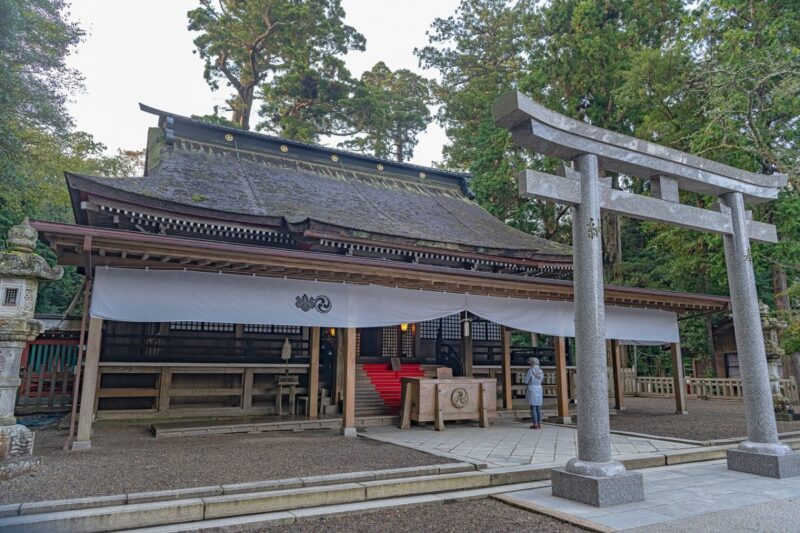
Kashima Shrine’s history dates to the 600s BC, making it one of the oldest shrines, and one of the “three great shrines” in the Kanto region. The shrine is dedicated to Takemikazuchi-no-Okami, the god of thunder and war in Shinto, who is also associated with martial arts. Kashima Shrine is also home to the oldest and the longest sword in Japan, which is considered as a national treasure by the government.
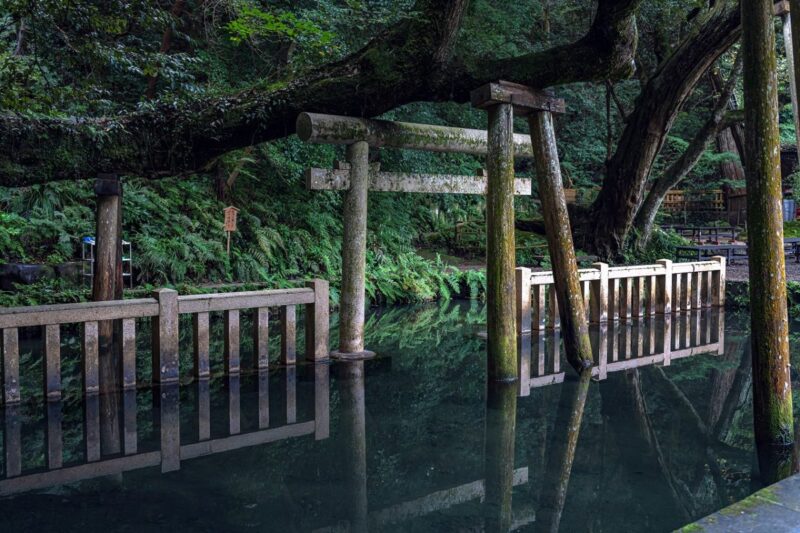
Kashima Shrine draws over 600 thousand visitors annually, and the shrine is famous for its hidden pond that is located behind the shrine buildings, Mitarashi Ike. Mitarashi Ike literally means “holy washing pond”, and the pond is fed by an underground spring that bubbles up to the surface.

The pond was used by the worshipers to cleanse their bodies and souls before they entered the shrine, as it was originally located at the end of the main walkway to the shrine. However, the layout of Kashima Shrine has changed, and these days visitors visit this pond to see the beautiful koi.
Kashima Shrine
- Business hours : 8:30 – 16:30
- Access : a 10-minute walk from Kashima Jingu Station
8. Climb the double peaks of Mt. Tsukuba!

Mt. Tsukuba is a mountain near Tsukuba, Ibaraki, and it is one of the most famous mountains in Japan. Mostly known for its double peaks, named Nyotai and Nantai, those peaks are tribute to Izanami and Izanagi, two deities who are said to be involved in the creation of Japan.
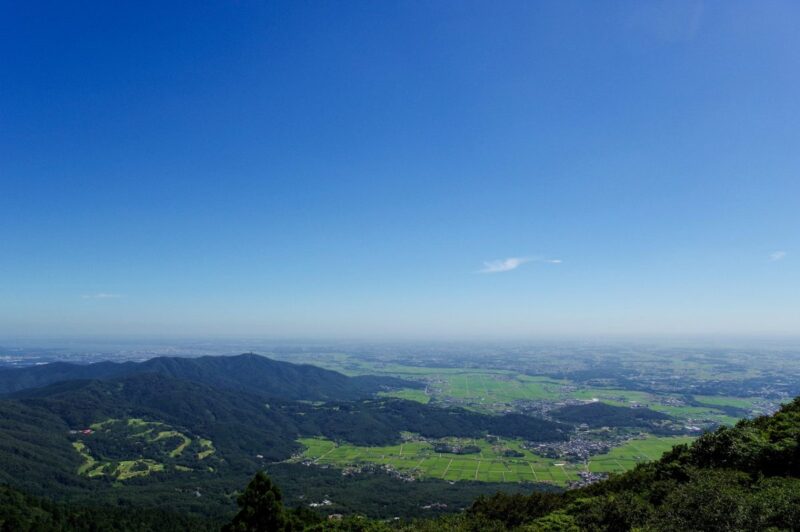
There are a lot of things to see in Mt. Tsukuba, including the large shrine at the foot of the mountain, and a smaller shrine at the top of each peak. There are several different routes you can climb, and you can also use the cable car to get to the top of the mountain. From the summit, you can see most of Kasumigaura, Tsukuba, and even Mt. Fuji in the distance.
9. Stroll around the Hananuki Valley
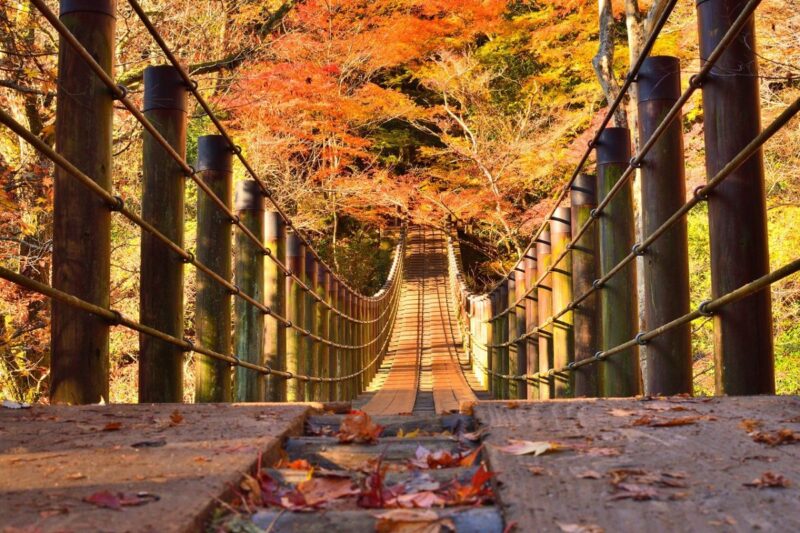
Visiting Ibaraki in fall? How about strolling around the Hananuki Valley for its breathtaking fall foliage?
Hananuki Valley is known as one of the best fall foliage spots in Japan, and it is best known for its breathtaking views that stretch from the Hananuki Dam to the Namerigafuchi and Kotakitazawa Camping Grounds.
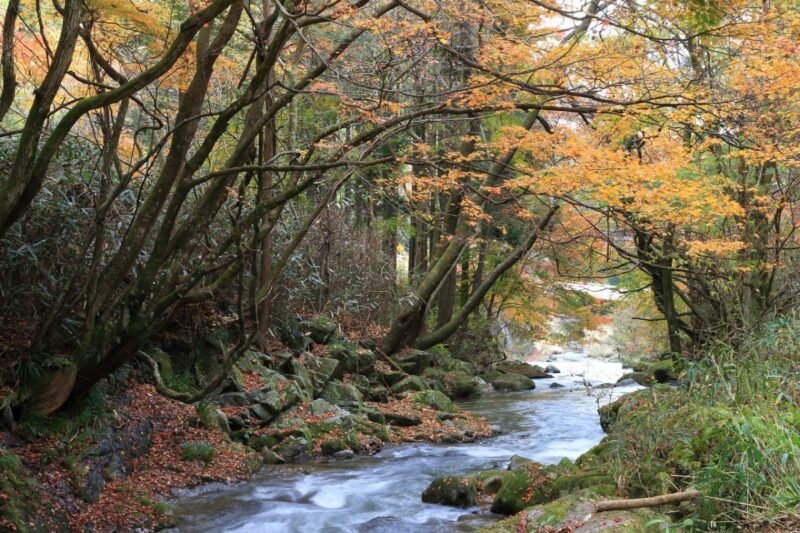
There are a lot of cliffs and waterfalls along the valley, and some of the best parts that you should never miss are the Shiomi Waterfall and the overhanging branches of trees along the clear Hananuki River.
Back To Index
10. Cruise around Lake Kasumigaura with a sailboat!
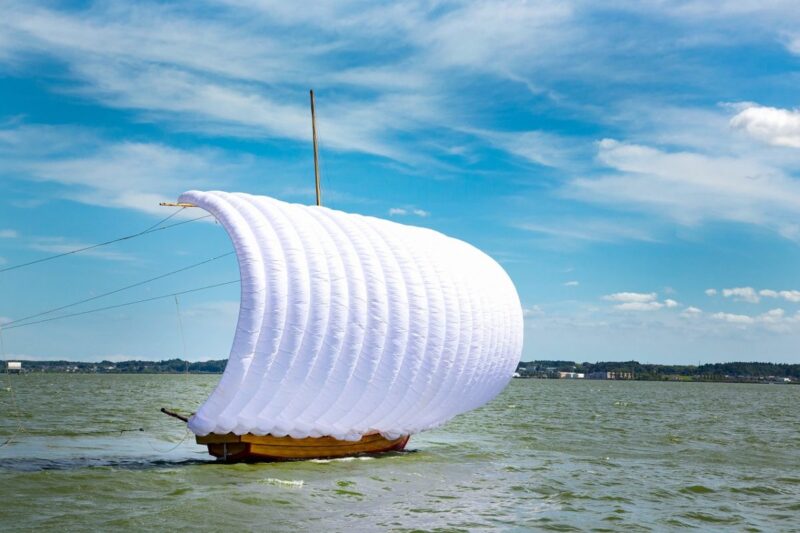
Lake Kasumigaura is known as the second largest lake in Japan, covering almost 170 sqm. and is a place thriving with tourism, fishing, irrigation, and recreation. You’ll see many boats in this lake, sailing around for fish or for fun.
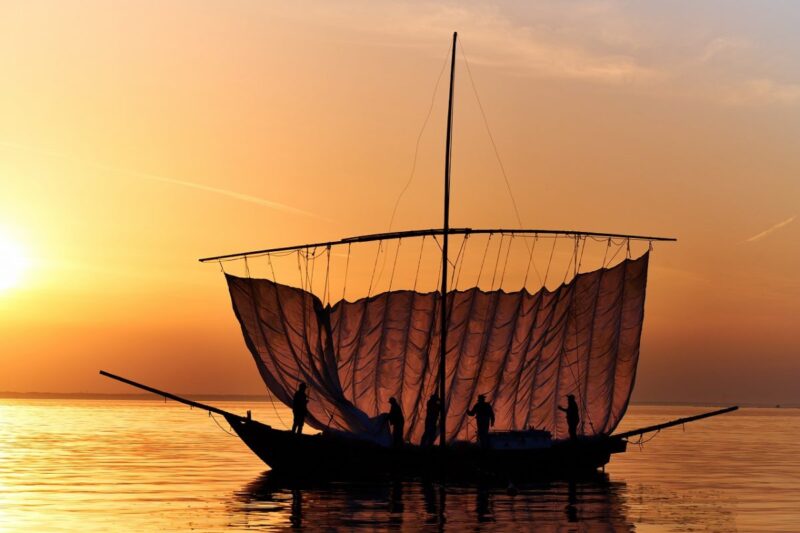
You can get on a sailboat and cruise around the lake from summer to fall, and the best timing for cruising around the lake is before the sunset.
Ibaraki’s best local treats
Ibaraki is blessed with its beautiful nature, and it produces an abundance of agricultural products and marine products. The prefecture is best known as the no.1 producer of natto, the stinky fermented beans, and also home to a variety of local foods, like Anko (angler fish) Nabe and Hoshi Imo (dried sweet potato).
Here are our picks for the best foods to try when visiting Ibaraki!
1. Anko Nabe
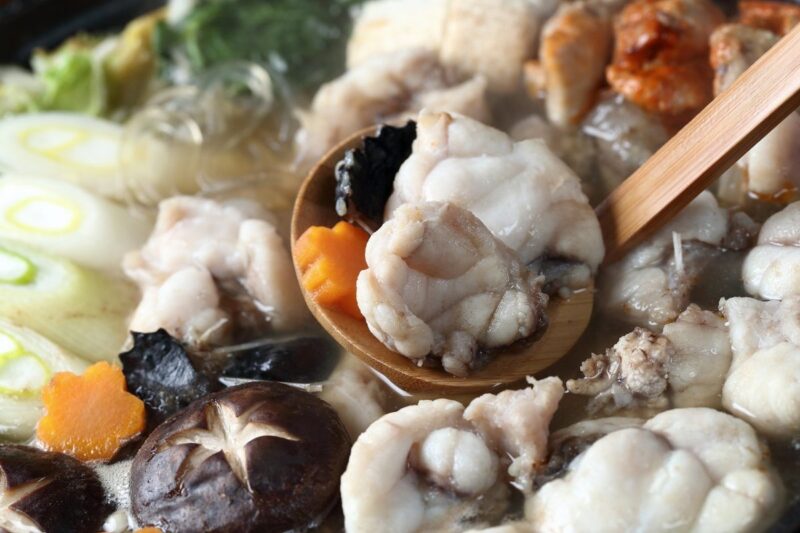
Anko , or anglerfish, is a deep-sea fish that is rich in collagen and originated in Ibaraki. Anko is often served in a nabe (hotpot), together with fresh vegetables like Chinese cabbage, green onions, carrots, and mushrooms. Anko nabe is a favorite winter fish of Ibaraki, so make sure to try this unique dish when visiting the prefecture!
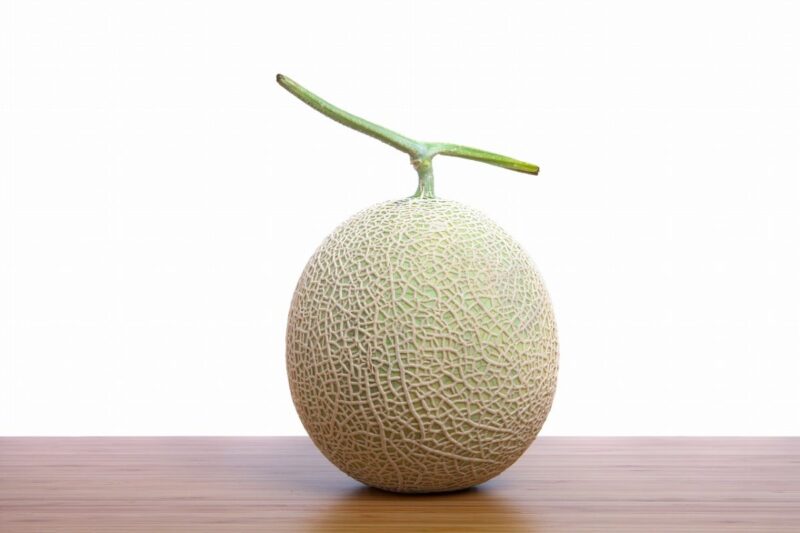
Ibaraki is known as the largest melon producer in Japan, producing about 25% of Japanese local melons. Ibaraki’s melons have high sugar content and firm texture, and they are in season from April to November. Some farms allow you to hand-pick your own melons at their farms, which are usually held in between May and June.
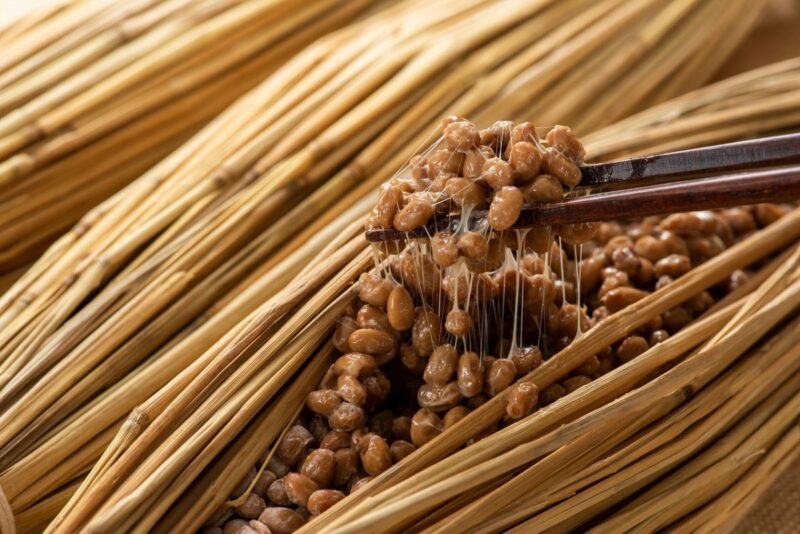
Called as the kingdom of Natto , Ibaraki is known as Japan’s no.1 producer of Natto , the stinky fermented beans. Natto is usually eaten together with rice, and it has many good benefits for your health and beauty. When trying Natto , make sure to stir it up thoroughly with your chopsticks before placing it on top of a bowl of rice.

4. Hoshi Imo
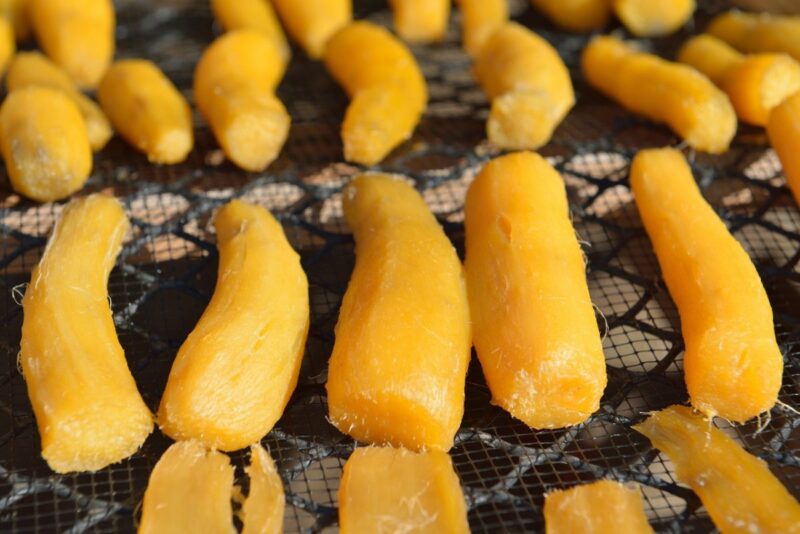
Ibaraki produces around 90% of Japan’s Hoshi Imo ; the dried sweet potato. Hoshi Imo is made by steaming and air drying the sweet potatoes, and it is known as a healthy traditional food. Hoshi Imo is rich in dietary fiber and potassium.
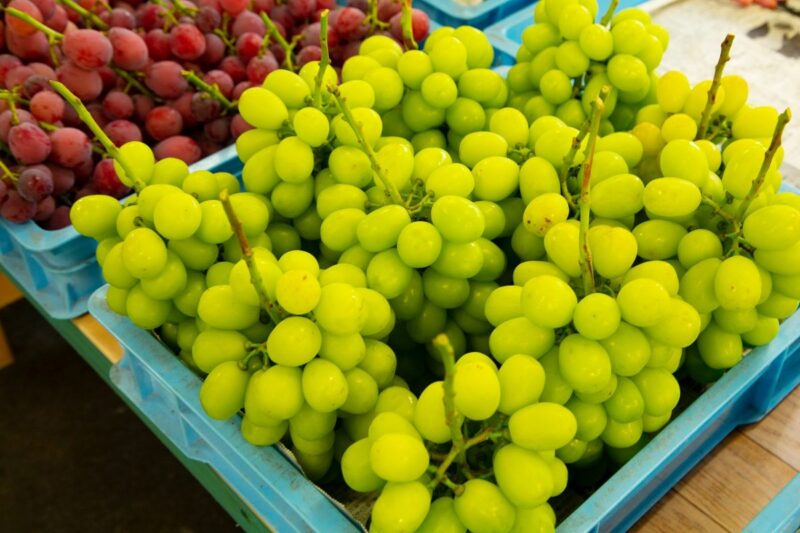
Ibaraki produces many kinds of fruit throughout the years, and one of the best fruits you can try in Ibaraki is their grapes. Farmers in Ibaraki mainly grow a large variety of grapes, but they also started growing European grapes like muscats and Rosario grapes. The variety of grapes you must try when visiting Ibaraki is the “Hitachi Seiryu”, a variety of grapes from Hitachi City, Ibaraki.
Now that you have an idea of how many fabulous spots are in Ibaraki, all you must do is plan your itinerary to enjoy unforgettable experiences in Ibaraki!
Back To Top

fromjapan_en_editor
We share all interesting stories about Japan; travel guide, food, shopping, and many trivial stories. If you’re the one who loves Japan, this is your area.
Recommended Article
Apr 05,2020
Jan 10,2021
Feb 01,2021
Mar 29,2021
Apr 20,2021
Jun 30,2021
Keyword search
Detailed search
Tell us more about yourself: Take our user survey now!
5 Perfect Day Trip Spots To Visit In Ibaraki Prefecture This Fall
All the brilliant colors of autumn.

Only a few hours away from central Tokyo, Ibaraki is a gorgeous place to see all that the fall season has to offer in Japan.
While Tokyo has plenty of fall hiking spots and beautiful parks to see autumn foliage , those seeking a quick weekend getaway to fully immerse themselves in the splendor of fall should head to Ibaraki prefecture.
Home to some of the most picturesque spots in the Kanto area, where you can find several of Japan’s Important Intangible Cultural Properties, like Yuki-tsumugi silk, Ibaraki is also the perfect place to find unique gifts and traditional flavors that the big city just can’t offer. The following five places are sure to delight photography fans, couples, those with families, and nature lovers alike.
1. Ryujin Big Suspension Bridge
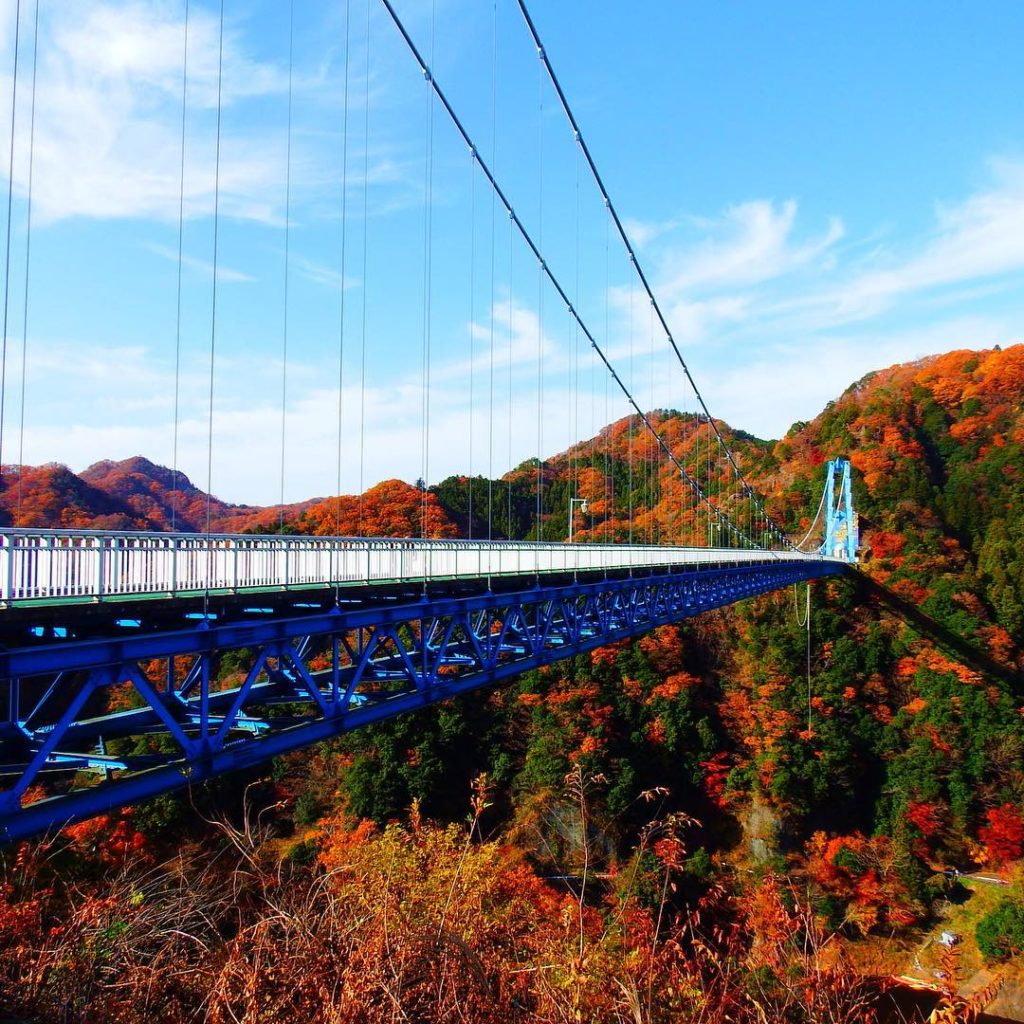
Ryujinotsuribashi , or Ryujin Big Suspension Bridge, is a 375-meter long bridge over a man-made lake in Ryujin Gorge, in Hitachi-ota, Ibaraki. It’s strictly a pedestrian bridge, with glass panels in the floor in some spots, allowing visitors to check out the rushing waters of Ryujin River just below their feet. Famed for its 100-meter high bungee jump attraction, this bridge is also an excellent place to look out at the autumn foliage. There’s also a nearby park, hiking courses, and hot spring to enjoy as well.
Bonus for couples visiting this bridge, there is a carillon at one end with three wooden bells, known as the bell of love, the bell of hope, and the bell of happiness. These bells will only ring when their switches are pushed by two people simultaneously.
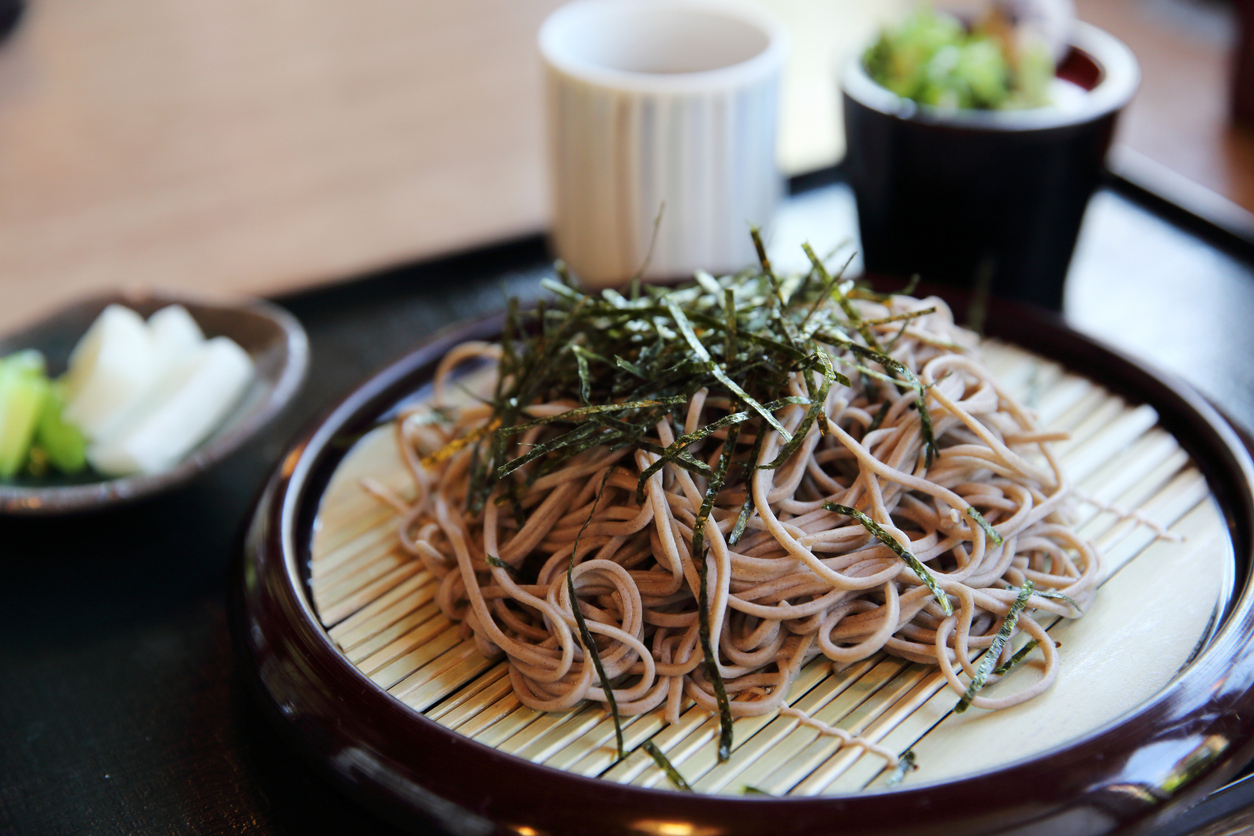
After scaring yourself silly with the heights and maybe some bungee jumping, you’ll probably be feeling pretty hungry. Hitachi soba noodles are renowned nationwide for its rich taste and firmness. You’ll find soba restaurants practically everywhere you go, but if you want something truly homemade tasting, head to one of the smaller, less touristy shops.
Where: 2133-6 Keganocho, Hitachiota, Ibaraki When to go: Throughout November Recommended for: Couples, adrenaline junkies
2. Hananuki Gorge
View this post on Instagram A post shared by Shreya Matkar 🎑 (@_japanophile_) on Oct 5, 2019 at 11:08am PDT
A large natural gorge in Takahagi City, Hananuki Gorge is best known for its numerous waterfalls that cascade into a series of basins. There are also other dams and streams here, as well as plenty of walking trails and walkways to discover. A particular highlight of this gorge is Shiomidaki Tsuribashi, a 60-meter long suspension bridge that offers absolutely amazing views of the landscape around you.
Most visitors wait until mid-November when the fall colors are at their peak to visit, so if you want to avoid the crowds, visiting earlier might be for the best.
Where: Ono, Takahagi, Ibaraki When to go: Mid to late November Recommended for: Anyone with a camera, nature lovers
3. Fukuroda Falls
View this post on Instagram A post shared by Japan Rail Pass (@jrailpass) on Oct 19, 2018 at 5:30am PDT
If you end up missing the fall foliage and visit in the winter, you won’t be disappointed either. Once the weather gets truly cold, the falls freeze solid, creating a towering pillar of pure white ice.
Fukuroda Falls is also known as a lover’s sanctuary, as there is a statue dedicated to lovers around the world here, which is a popular photography spot for couples.
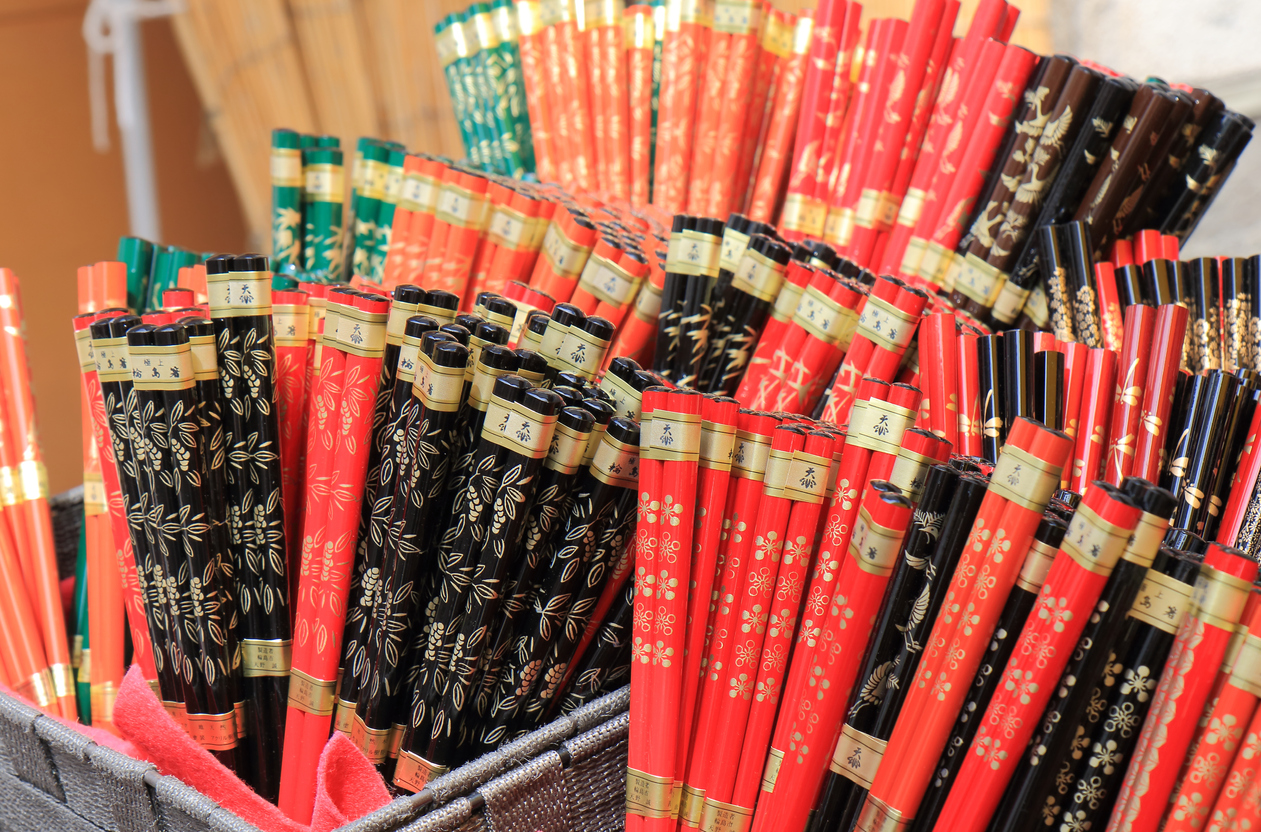
If you’re looking for souvenirs of your time in the Daigo area, my personal favorite Daigo urushi , or lacquerware. Produced not that far from Fukuroda Falls, the town of Daigo is home to Japan’s second-highest lacquer output, and where you’ll find beautiful sake cups, vases, chopsticks, tableware and even keychains in rich, glossy shades of red, brown, and black.
Where: 3-19 Fukuroda, Daigo, Kuji, Ibaraki When to go: Early to mid-November Recommended for: Couples, families, photography fanatics
4. Oarai Isosaki Shrine & Kamiiso no Torii
View this post on Instagram A post shared by さき (@ss__mgram) on Sep 28, 2019 at 3:10am PDT
Located on a hill overlooking the Pacific Ocean, Oarai Isosaki Shrine was first founded in 856 when the deity Sukunahikona-no-mikoto descended on the shore of Oarai. It has been home to a permanent shrine and a spot of worship since 1730. Three torii gates are included within its properties, but the most well-known (and photographed) of the bunch is the Kamiiso no Torii , which stands on a reef in the Pacific Ocean. This spot is said to be where the deity landed.
The shrine itself is surrounded by beautiful woods that transform into all the warm colors of autumn each year, which is reason enough to visit, but those with a love of the obscure may also want to visit the Oarai Sea Museum. There, visitors can learn about the history of the fishing industry and the integral part it has played in the history and worship of the area.
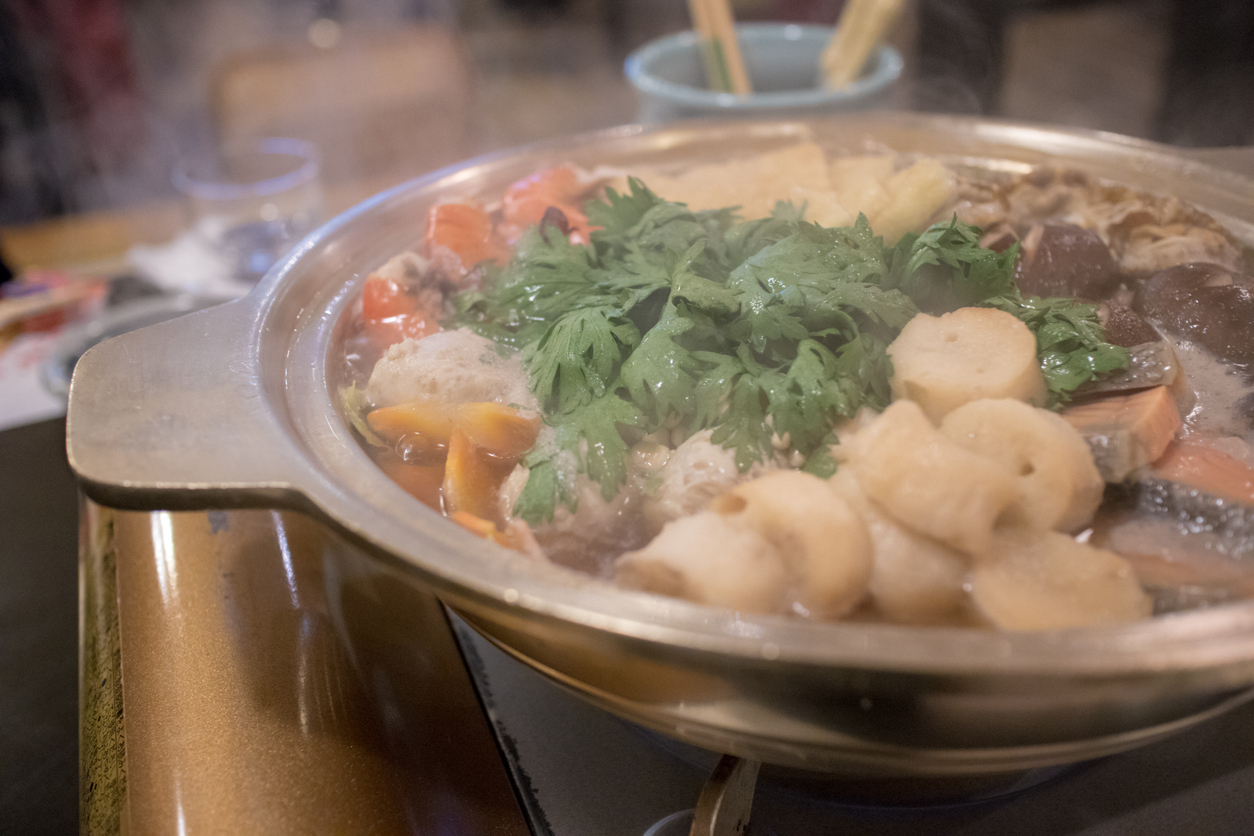
This is also a great area to try one of Ibaraki’s most famous seasonal dishes in. In the late fall and winter, anko (anglerfish) hot pot is a common dish in Ibaraki prefecture. Rich in collagen, this deepsea fish is typically served in a nabe style hot pot with fresh winter vegetables like hakusai (Chinese cabbage) and green onions.
Where: 6890 Isohamacho, Oarai, Higashiibaraki, Ibaraki When to go: Throughout November Recommended for: Anyone who’s missing the ocean views
5. Kairakuen Garden
View this post on Instagram A post shared by Jordan Holland (@jordan_holland_photos) on Jun 25, 2019 at 4:57am PDT
Alongside Kenrokuen in Ishikawa prefecture and Korakuen in Okayama prefecture, Kairakuen is one of Japan’s Three Great Gardens. The newest of the three, Kairakuen was originally completed in 1841 by the regional lord Tokugawa Nariaki, and designed not only for his enjoyment but for that of the public as well. As the story goes, Lord Nariaki opened the garden to the public because he saw little difference between the classes—in fact, the name ‘Kairakuen’ means ‘park to be enjoyed together.’
There is a bamboo grove, a cedar forest, tea ceremony rooms, plum trees, cherry trees, azaleas, wisteria, and beautiful views of Lake Senba as well. This park is breathtaking all year round, so if you aren’t able to visit in the fall, late winter is also highly recommended. There are 3,000 plum trees made up of some 100 different varieties within the grounds, which fill the park with brilliant pink and white petals from late January onward.
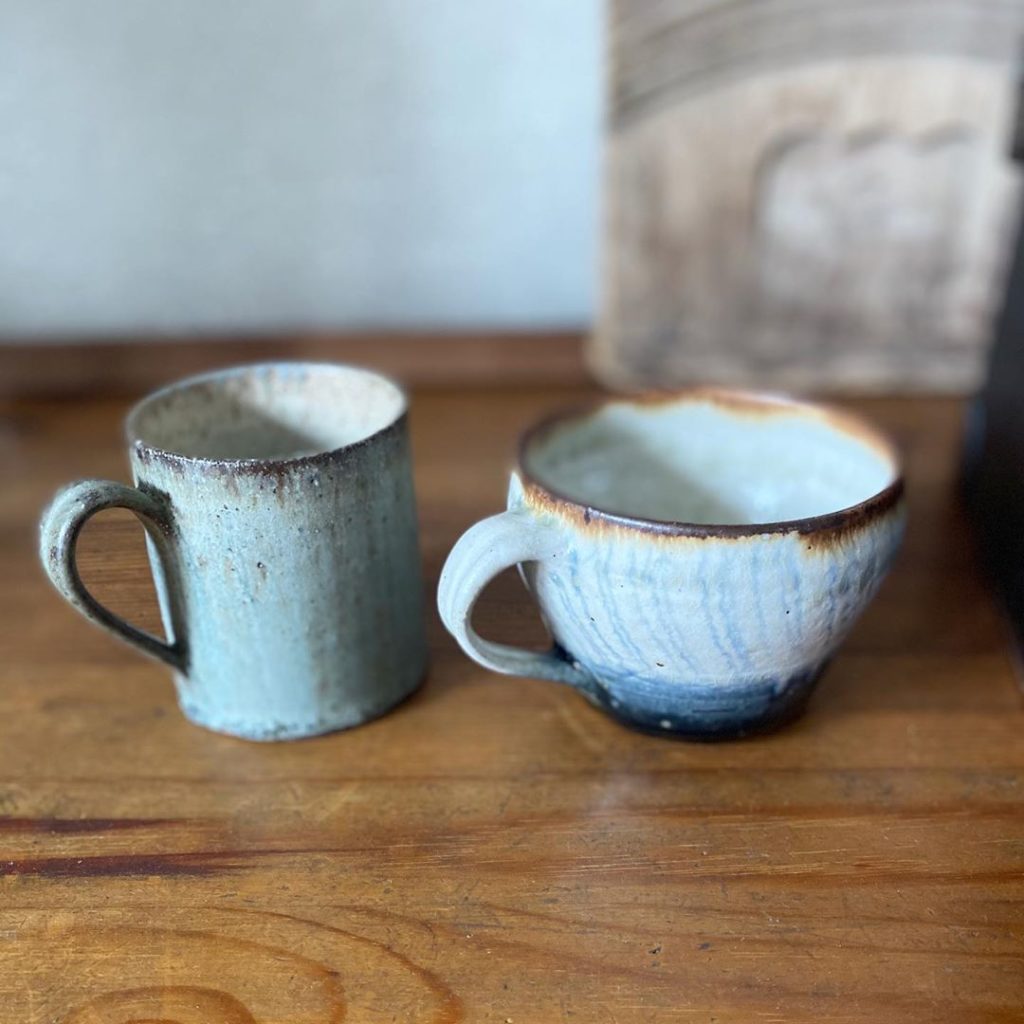
While you’re in this area, be sure to stop by one of the many artisan shops to get a piece of Kasama-yaki to remember your trip by. A type of pottery from the Edo period, Kasama-yaki is a highly unique, very stylized form of pottery that many still consider one of the best arts to come from that era.
Where: 1 Tokiwacho, Mito, Ibaraki
When to go: Mid to late November Recommended for: Families, nature lovers, pottery fans If you want to immerse yourself in the beautiful colors of fall and really see a different side of Japan, then a visit to Ibaraki is a must!
Did we miss any of your favorite spots to visit during the fall in Ibaraki? Let us know in the comments below!
Leave a Reply Cancel reply
Your email address will not be published. Required fields are marked *
Save my name, email, and website in this browser for the next time I comment.
This site is protected by reCAPTCHA and the Google Privacy Policy and Terms of Service apply.
This Week(End)
Tokyo events for may 2024.
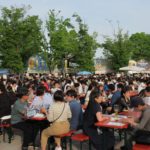
Shiba Park Oktoberfest 2024

The Ultimate After-Work Stress Relief
Jingu stadium night yoga 2024.

Save The Beach, Save The Ocean
Greenroom festival 2024.
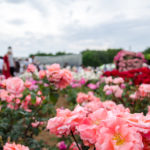
Bed of Roses
Jindai botanical garden's spring rose festival.

Laos Festival 2024
50 ways to see, feel and taste tokyo.

Your Guide To The Best Things To Do In Tokyo!
Other articles by hilary.

Dating Apps in Japan 2024: What’s Worth It and Not?

Coping With White Day’s Emotional Toll in Japan

Valentine’s Day Do’s & Don’ts In Japan

Tokyo’s Top 10 Offbeat Museums

Letters from Japan: Goodbye 2023
Contribute To Savvy Tokyo
Share your voice with savvy tokyo’s readers.
@savvytokyo What convenient apps do you use living in Tokyo?💧📲 #mymizu #freewater #lifeintokyo #lifeinjapan #ecofriendly ♬ やってみよう - WANIMA
Related Articles You Might Like
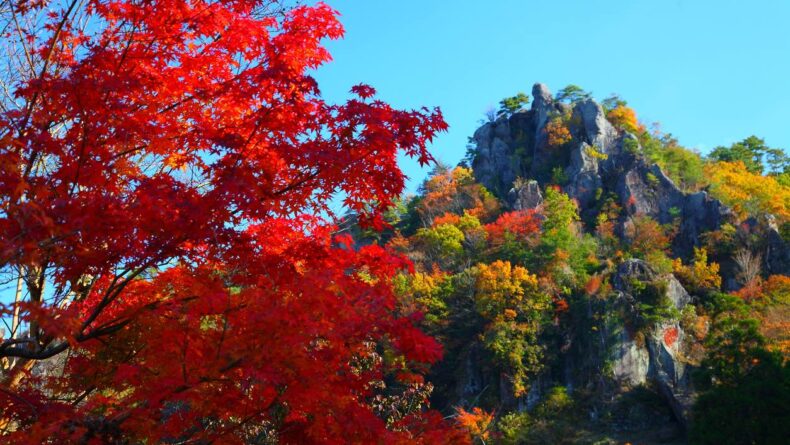
5 Hikes Around Tokyo To Catch Stunning Views Of Autumn Leaves
Escape the concrete jungle and crowded parks in the city and immerse yourself in mother nature’s greatest gift to Japan: the chameleon-like transformation of earthy...
By Erika van 't Veld
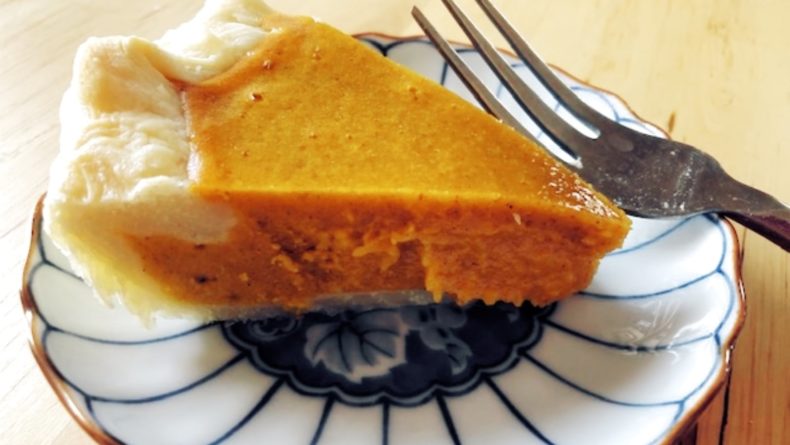
Recipe: Spiced Kabocha (Japanese Squash) Pie
You’ll be reaching for more than one slice of this fall-flavored dessert.
By Amya Miller
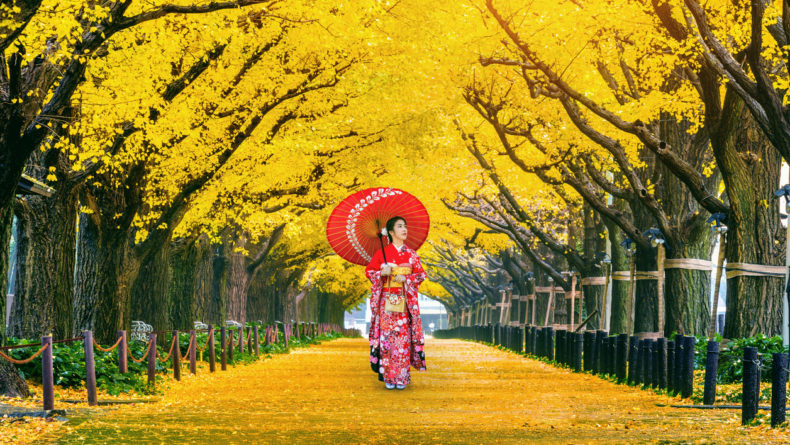
10 Gorgeous Autumn Foliage Spots In And Near Tokyo
Some of Japan's best autumn foliage destinations are just a train ride away.
By Jes Kalled
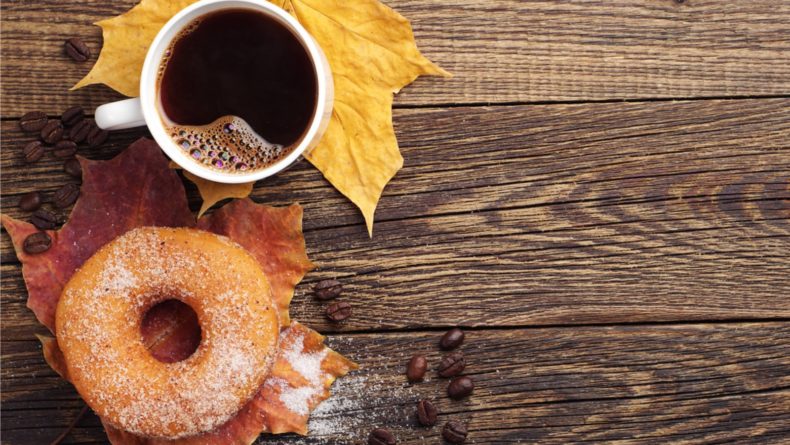
Autumn-Flavored Japanese Donuts That You’ll Fall In Love With
While spring is typically Japan's season with all the attention—thanks to the countless sakura-themed treats that get released around that time of year—autumn is criminally...
By Lucy Dayman
Top Things to Do in Ibaraki Prefecture, Japan
Things to do in ibaraki prefecture, explore popular experiences, popular cities in ibaraki prefecture.

Ways to tour Ibaraki Prefecture

Mt. Fuji & Lake Kawaguchiko Private 1 Day Tour With Pick & Drop

Real Drift Car Riding Experience Private JDM Daikoku Tsukuba Fuji

[Narita Airport Terminals 1, 2] 40-60km Sawara Itako Historic Bike Tour

Private Kimono Collage Art Making in an old house

The Tallest Great Buddha Spot Walking Tour

Private Soy Sauce Brewery Tour at Century Old Factory in Ibaraki

Private Vacation Photography Session with Local Photographer in Tokyo

Private Adventure Tour in Northern Ibaraki and Washi Paper Making

Kasama yaki handmade pottery experience

Full-Day Private Adventure in Ibaraki and Fukuroda Waterfalls
Top attractions in ibaraki prefecture.

Private Sightseeing Tours

Historical Tours

Tours & Sightseeing
What travellers are saying.
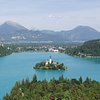
- Destinations
11 Best Things to Do in Ibaraki
Ibaraki Travel Guide: What to Do in Ibaraki Now
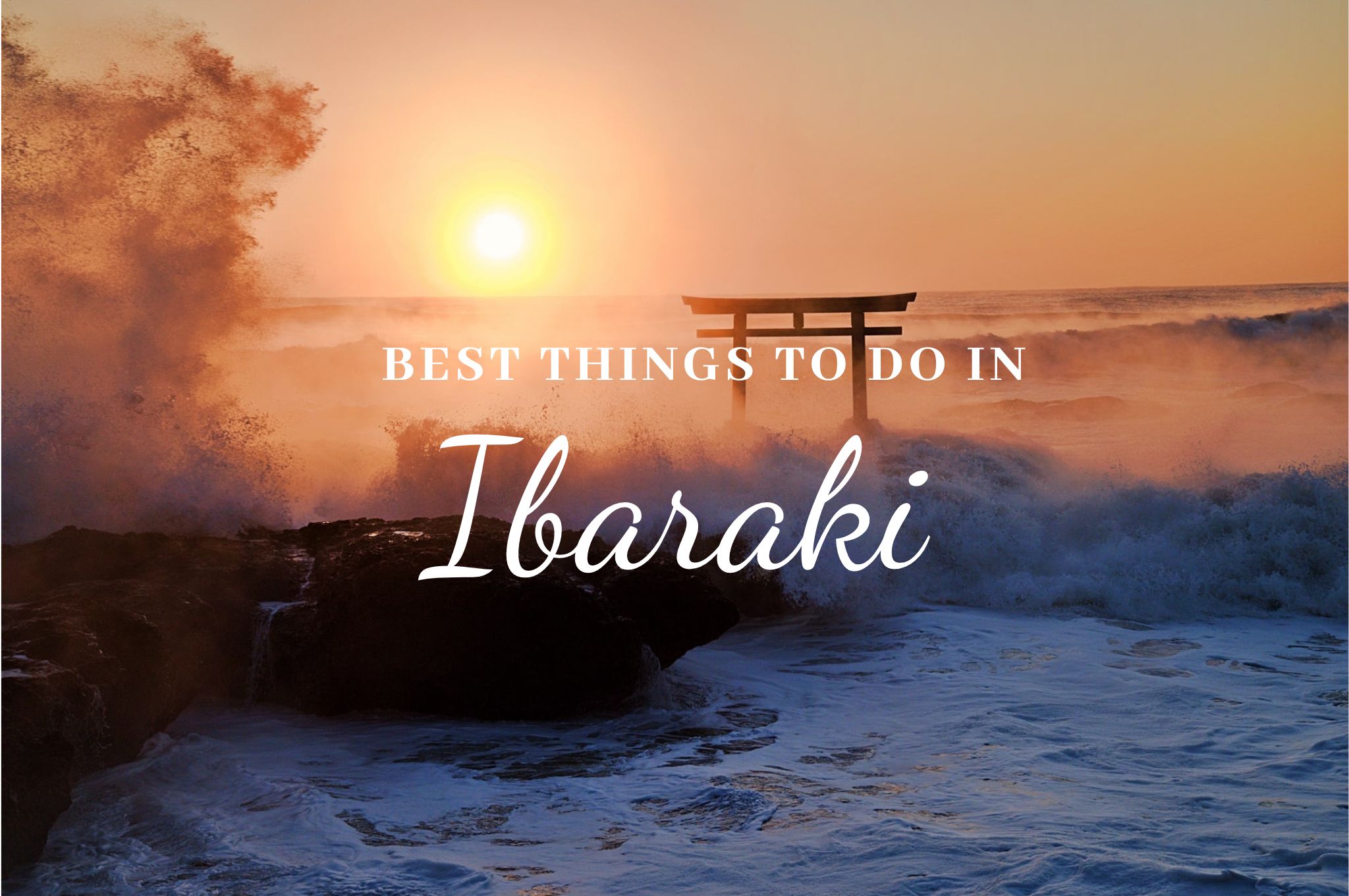
Ahh, Ibaraki Prefecture. At the forefront of one of the most polarizing famous Japanese specialties (any natto lovers out there?), the stronghold of the Mito clan , one of the branches of the Tokugawa family during the Edo period, and home to one of the most important cities in the whole country in terms of science due to the high concentration of scientific research facilities, among many more interesting things. Sitting on the northeastern side of the Kanto region and flanked by the Pacific Ocean on the eastern border, Ibaraki tends to fly under the radar for many foreign visitors to Japan, which is why I’m here to advocate for these awesome lands with a list of the Best things to do in Ibaraki!
With this Kanto Region Bucket List, let’s also check out the surrounding tourist attractions: Best Things to Do in Kanto
*Please note that this article contains affiliate links.
1. Deplete Your Camera Batteries at Hitachi Seaside Park
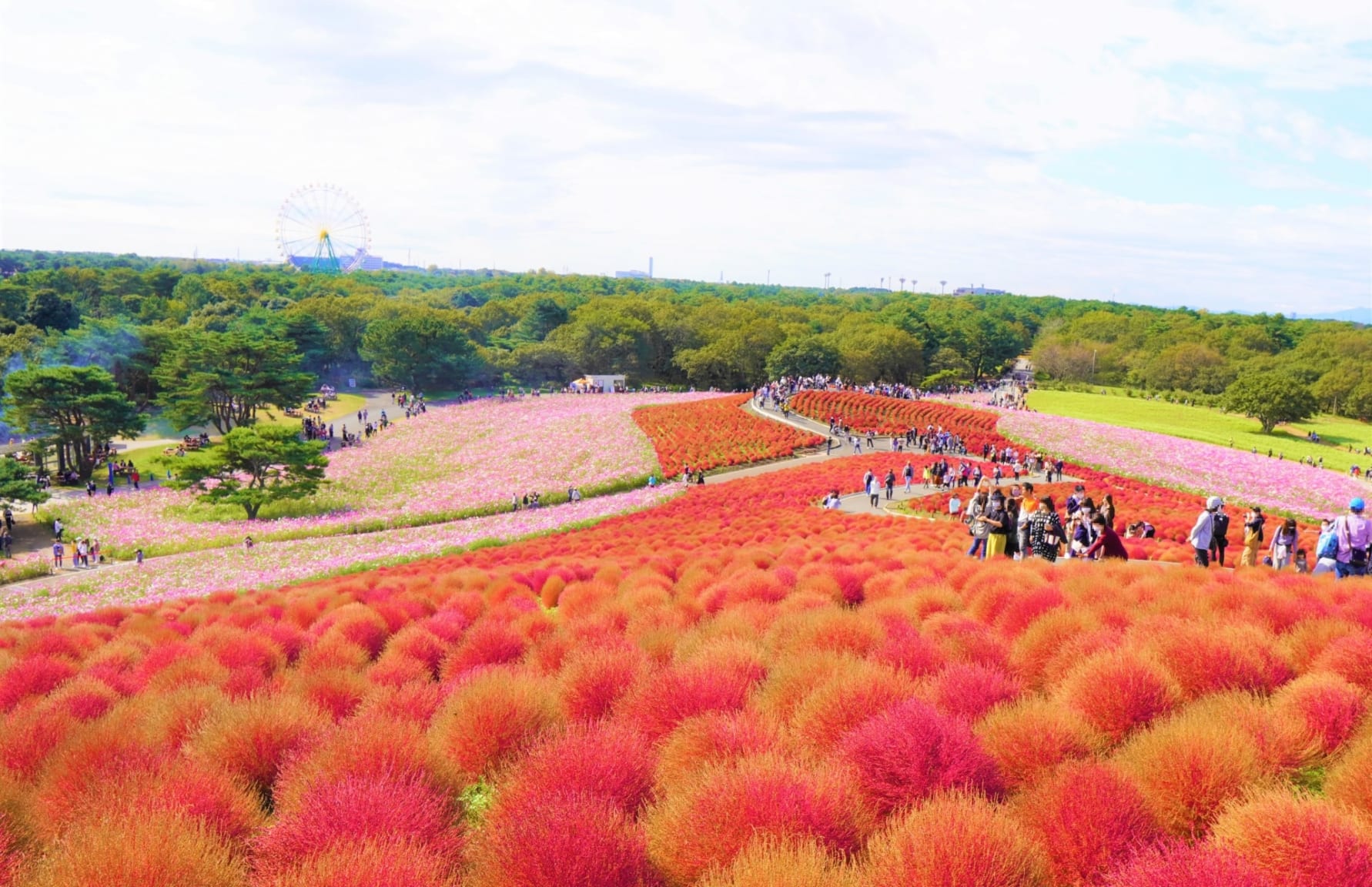
Check out more about Hitachi Seaside Park in the following articles.
▶ Kochia Carnival at Hitachi Seaside Park Autumn
▶ Nemophila Harmony at Hitachi Seaside Park
And while you’re at Hitachinaka city, why not have an extra experience such as trying top-class Japanese Kaiseki lunch and Tea ceremony? Kyoyuzen Hanamiyako (京遊膳 花みやこ) is a restaurant listed in the Gault et Millau guide (the only restaurant in Ibaraki listed as of 2022). Experience the Japanese Kaiseki course meal at its top level with carefully selected ingredients and tableware (drink-pairing add-on option available). Complete the experience with a tea ceremony hosted by the restaurant proprietor who is also a tea ceremony master.
Book Online: Kaiseki Lunch & Tea Ceremony at Kyoyuzen Hanamiyako in Hitachinaka, Ibaraki Prefecture
Information
2. Pay Respect to Japan’s Tallest Buddha Statue
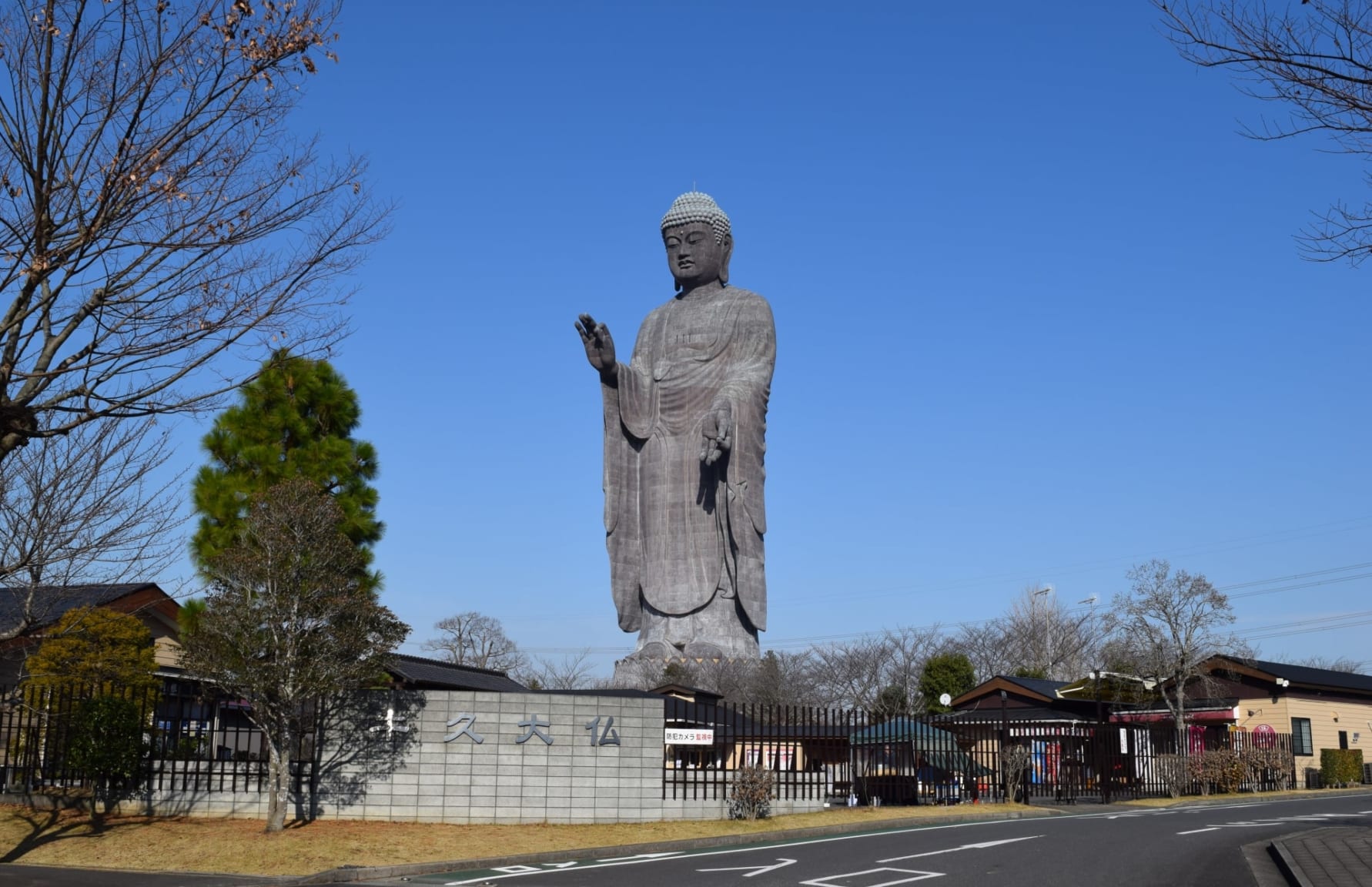
3. Go on a Relaxing Hike at Mt. Tsukuba
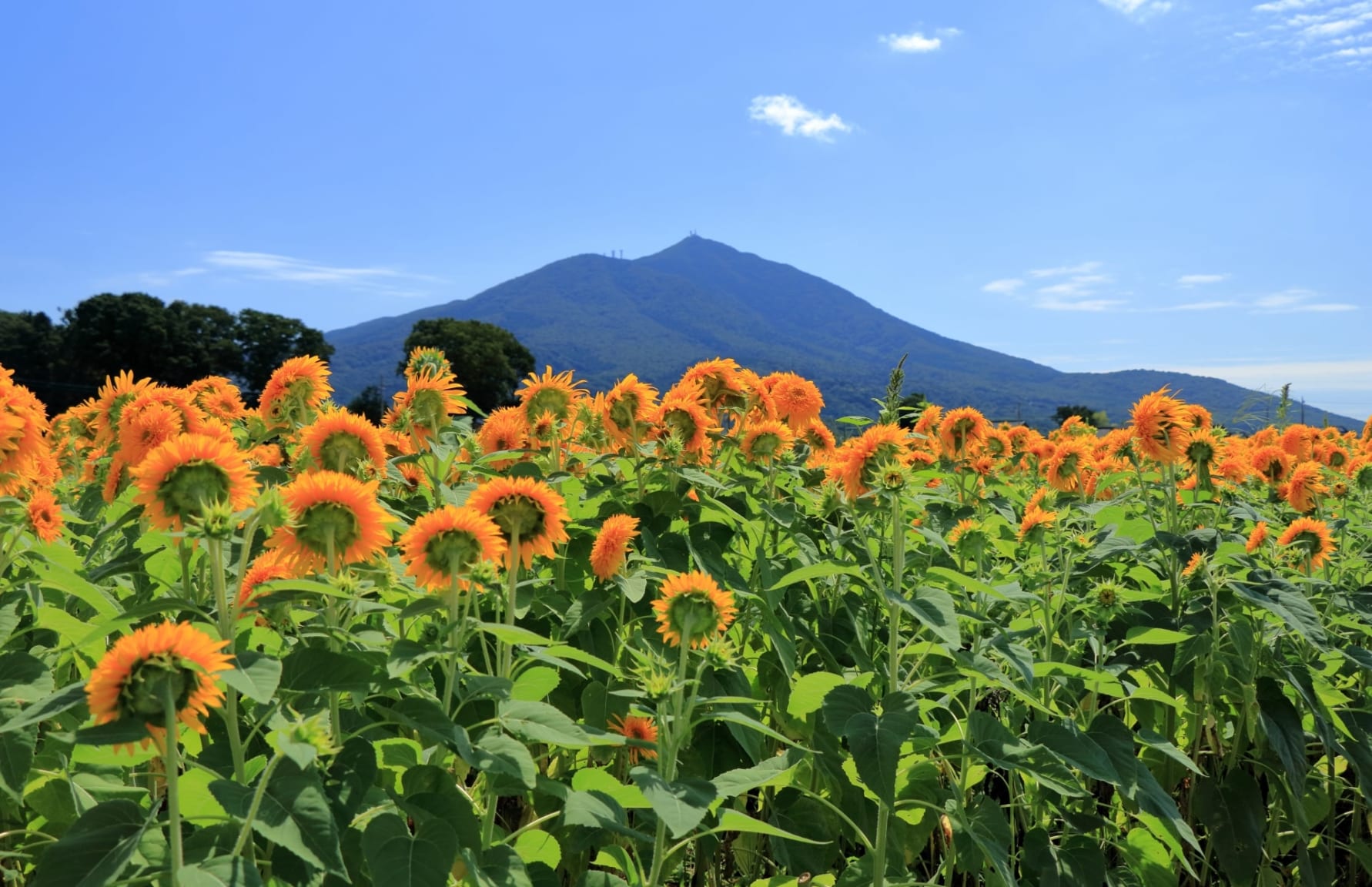
▶ Mt. Tsukuba official website: https://mount-tsukuba.com/
▶ Mt. Tsukuba cablecar and ropeway official website: https://www.mt-tsukuba.com/global/en/
A good way you can enjoy an Mt. Tsukuba hike is by being part of a hiking tour. There is a half-day tour you can take with an English-speaking, highly experienced guide who can customize your tour depending on your hiking experience and preferences. Experience Mt. Tsukuba to its fullest by checking out little-known paths and breathtaking view spots while hearing detailed explanations and fascinating stories about the mountain.
Book Online: Guided Mt. Tsukuba Hiking Tour (Half-Day) With a Veteran of 400 Climbs!
4. Take a peaceful stroll in Kairakuen
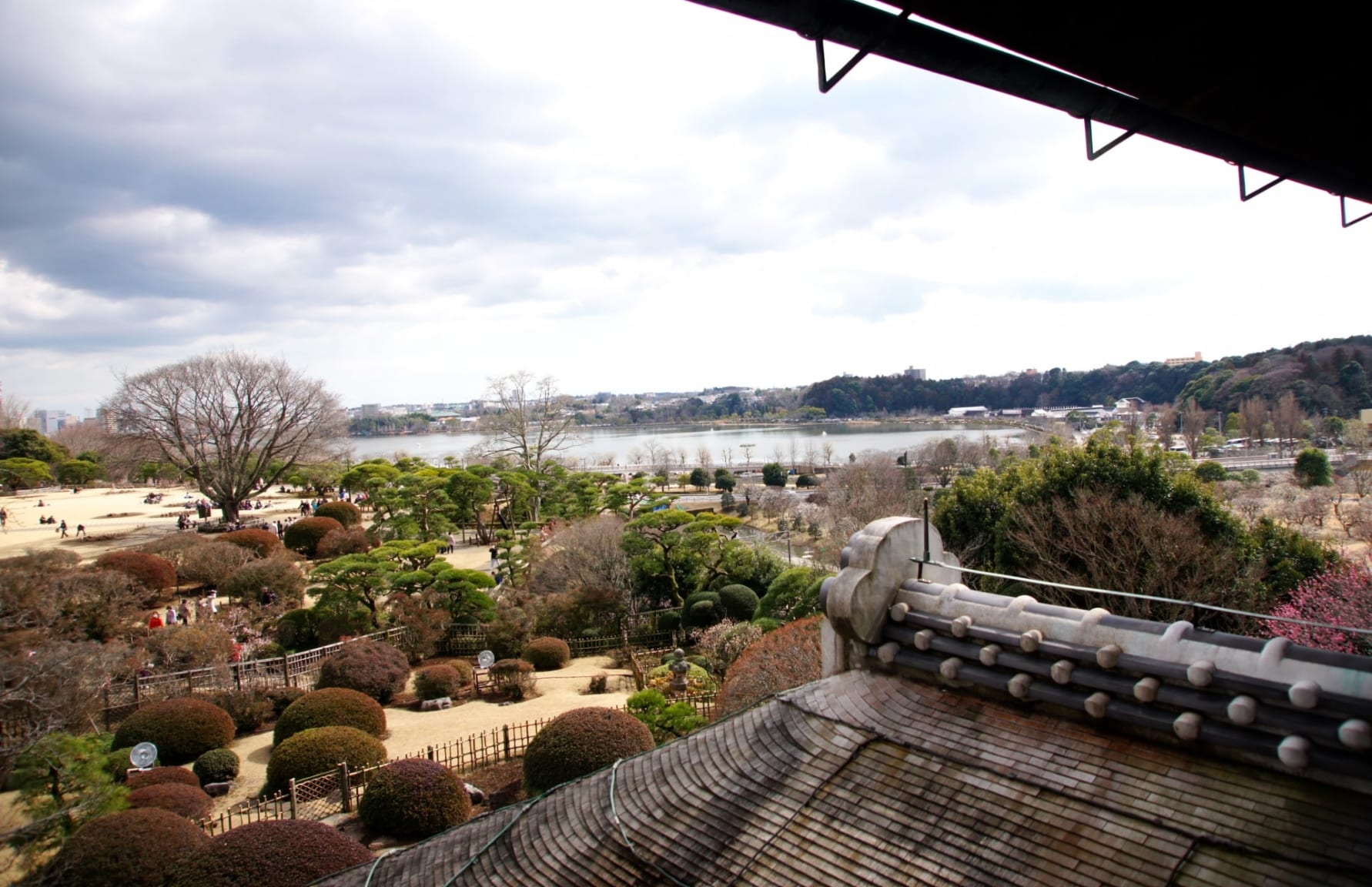
5. Discover the mythical birthplace of Japan at Oarai Isosaki Shrine
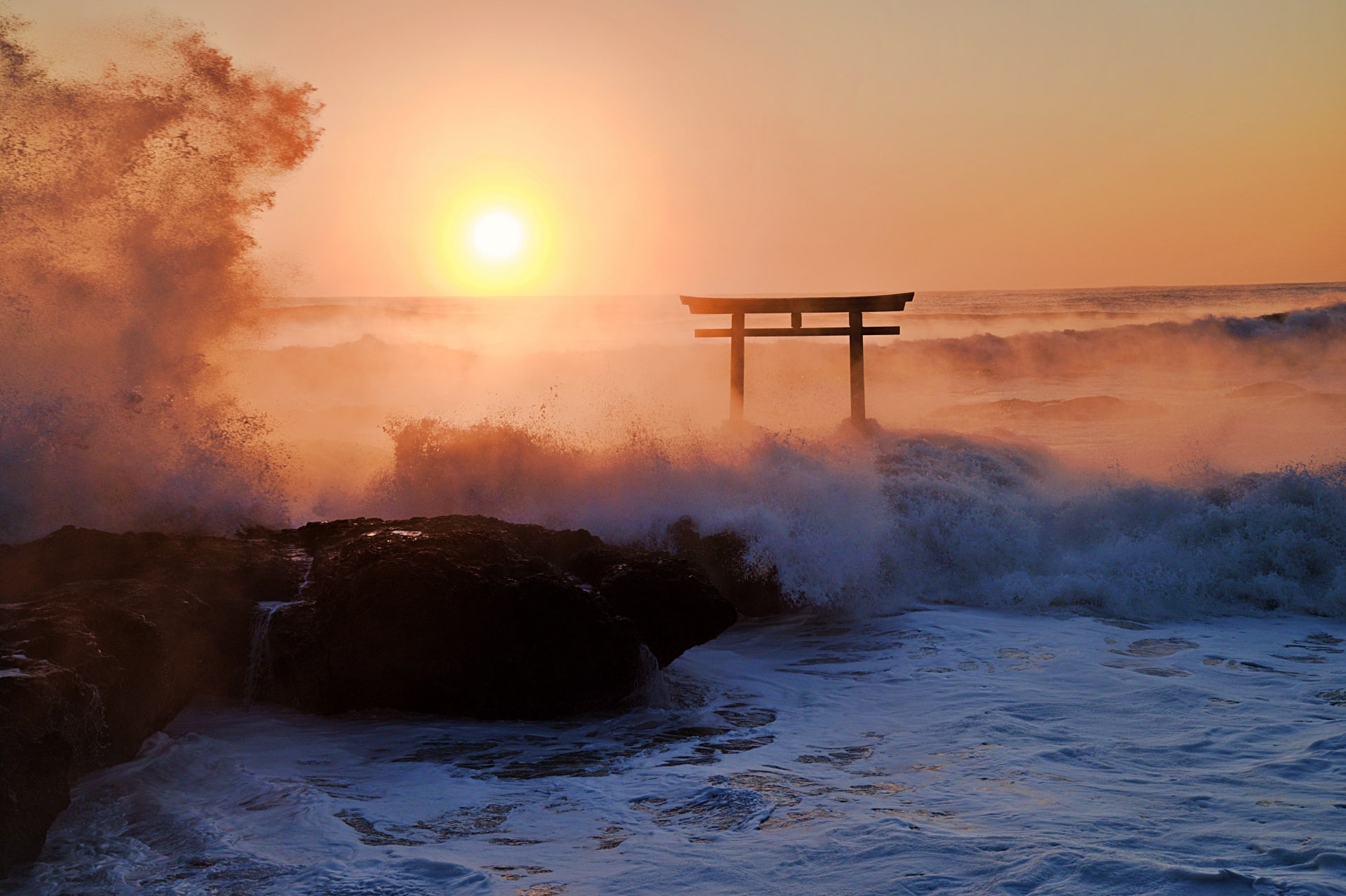
6. Walk Under a Tunnel of Leaves at Hananuki Valley
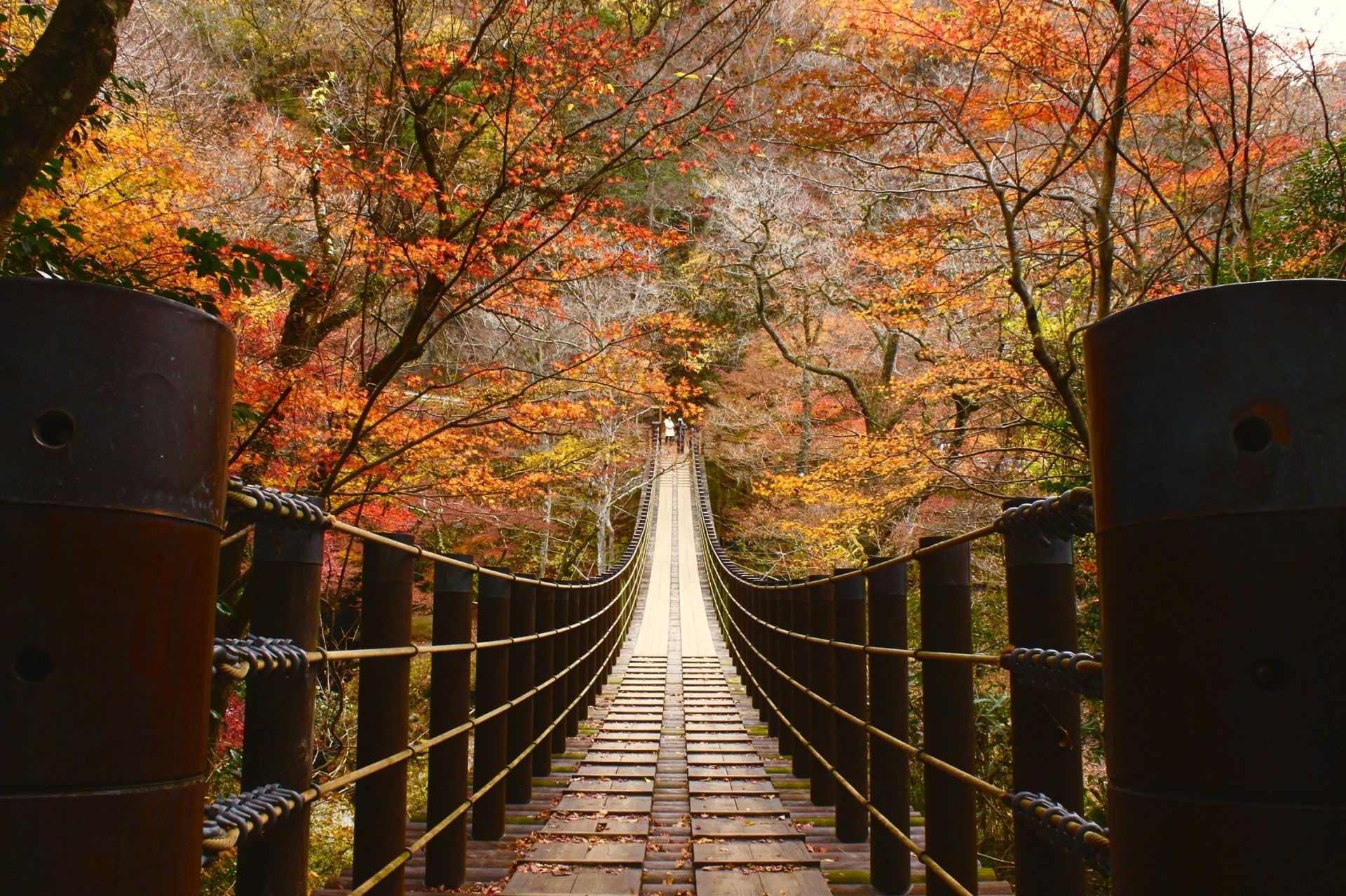
7. Cycling & Lotus Root Digging around Lake Kasumigaura
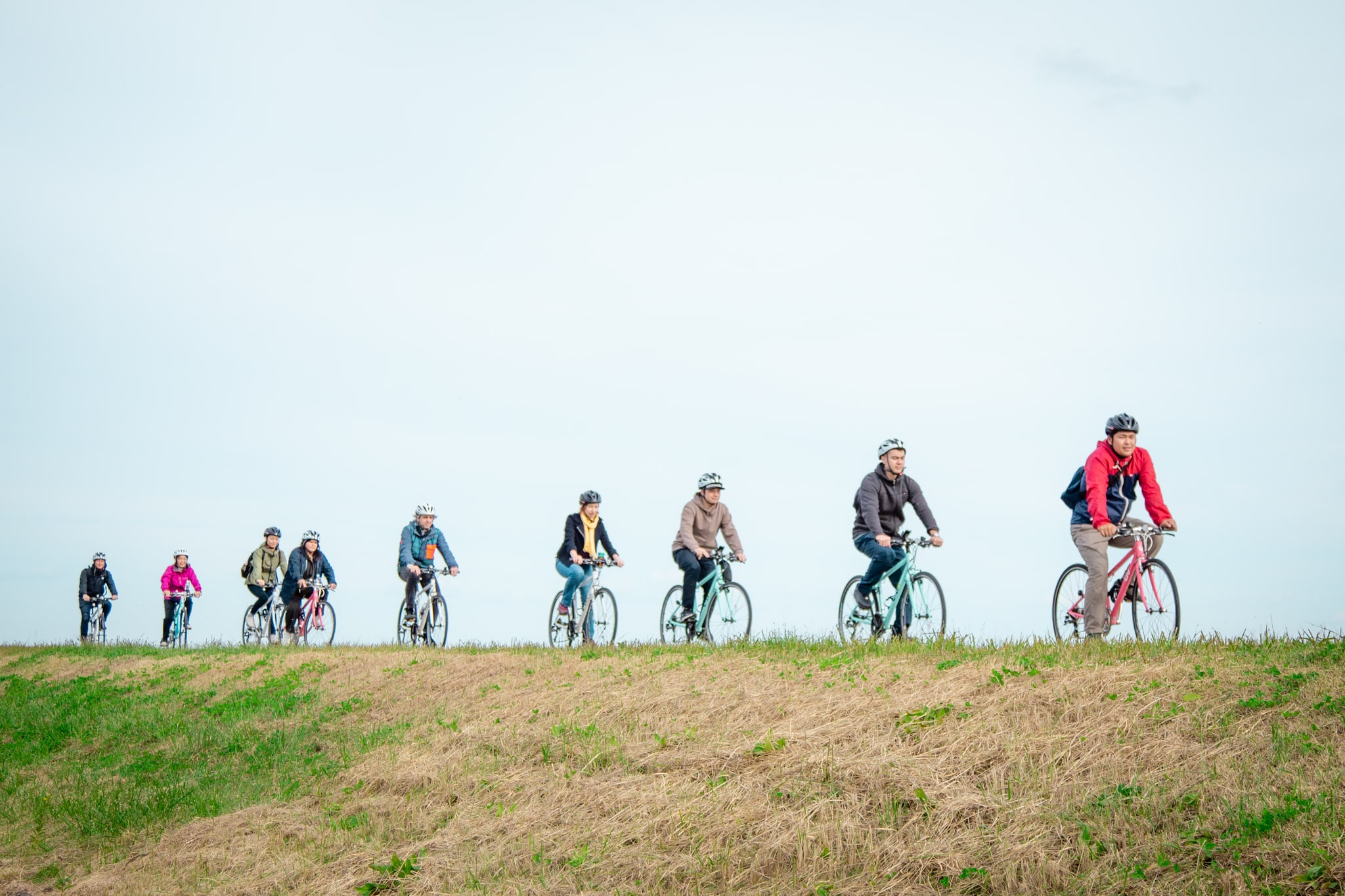
Another popular spot in Ibaraki is Lake Kasumigaura (霞ケ浦) . Located in the mid-east area of Ibaraki, Lake Kasumigaura is the second largest lake in Japan, only coming behind Lake Biwa in Shiga prefecture. The lake is a popular spot for cruising, fishing, and birdwatching.
Part of the lake borders the cities of Kasumigaura and Tsuchiura which are particularly famous for cycling and being the number 1 Lotus root (蓮根) producer in Japan. The cycling part is famous mainly because of the cycling route you can take around the lake which has little ups and downs across its 140km circumference. You will be surprised at how Tsuchiura station is built and adjusted so that cycling enthusiasts can enjoy their stay to the fullest. And regarding the lotus root, this is a popular ingredient in Japanese cuisine that can be prepared in various ways. When you cut the root, you will see many holes in the cross-section. In Japan, it is said that you can see into the future through these holes, thus, eating it brings good luck to you.
There is a tour you can take where you can experience both cycling and lotus rood digging nearby Lake Kasumigaura. This tour starts with the cycling experience around the lake. Feel the refreshing breeze while enjoying the spectacular view of the lake (You may even spot the Ushiku Great Buddha in the distance if the weather conditions allow it). Then you will have the unique experience of digging up lotus roots, assisted by local producers. They will lend you all the gear necessary and show you how this unique process is done. It is definitely a set of experiences you won’t be able to have elsewhere.
Book Online: Lake Kasumigaura Cycling Tour & Lotus Root Digging Experience in Ibaraki Prefecture
8. Pick Seasonal Fruits in Ibaraki
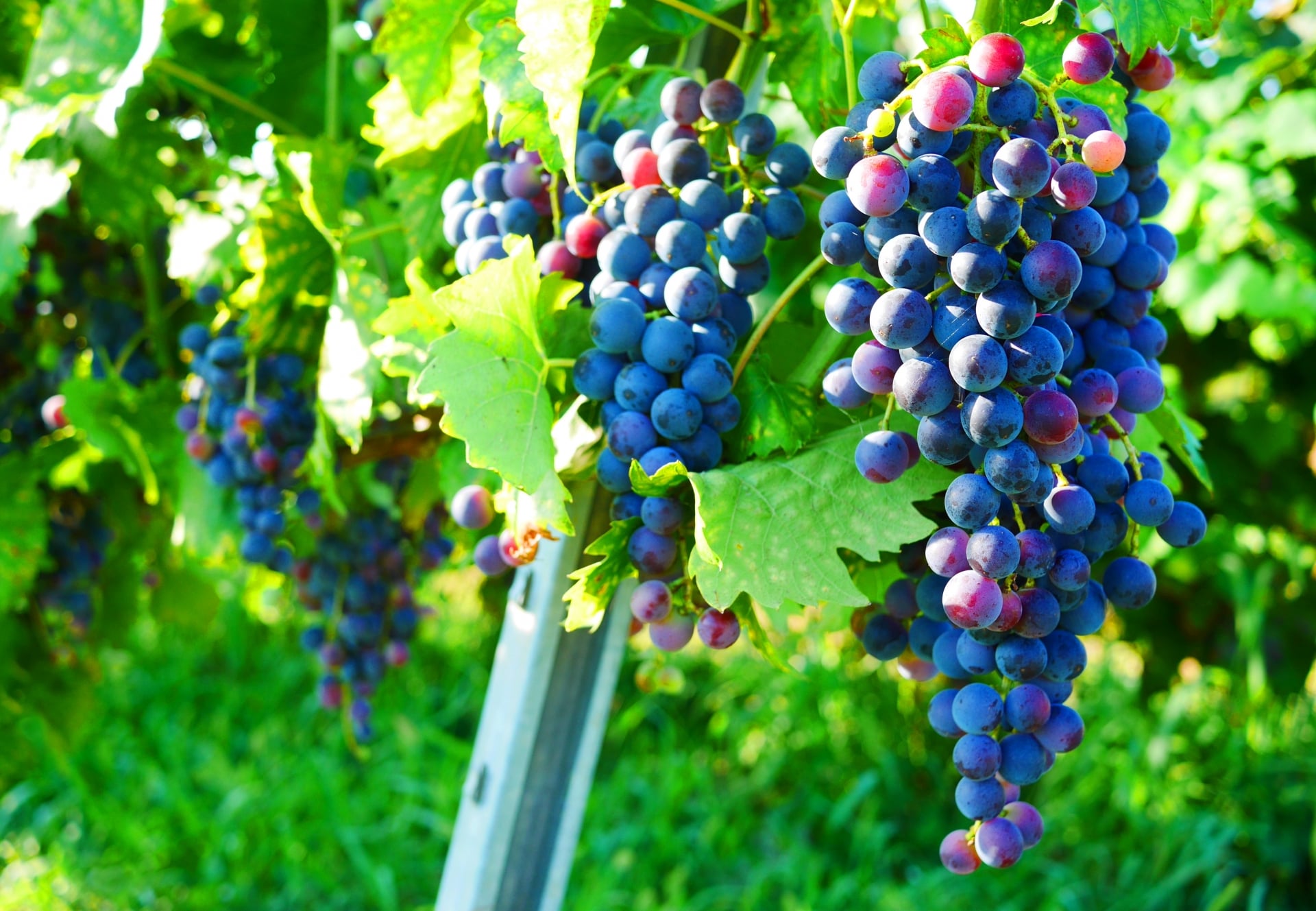
9. See some of Japan’s best Fireworks in Tsuchiura

10. Embark on a Tour of Sake Brewery
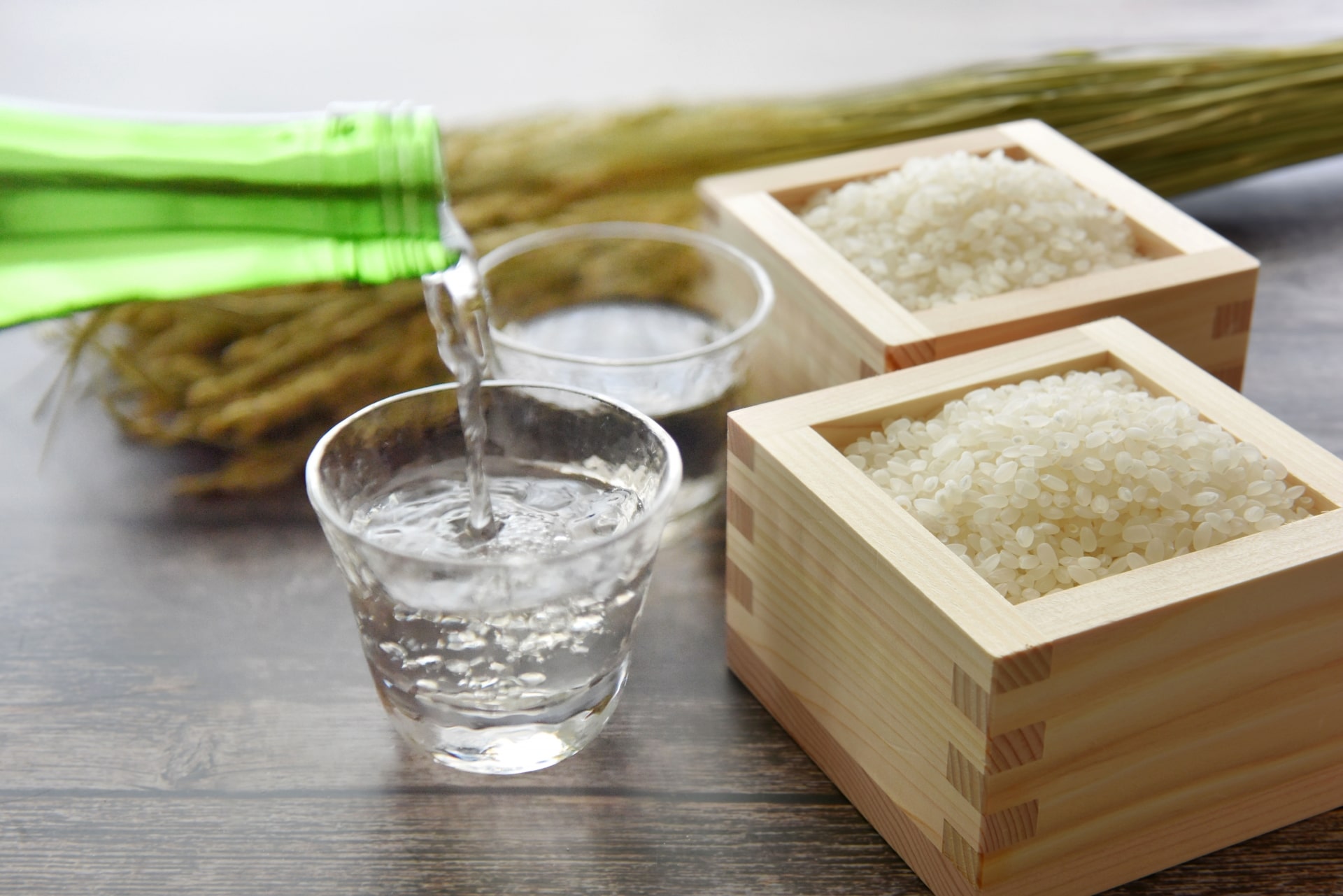
▶ Ibaraki Sake Brewery Association official website: http://ibaraki-sake.or.jp/
A tour we highly recommend is the Sake pairing experience at Sudo Honke (須藤本家). Sudo Honke is Japan’s oldest sake brewery (founded in 1141) with a rich history and popularity that has attracted many famous people to visit. You can experience Sake pairing with their wide variety of products along with traditional Japanese dishes. This is a good opportunity to taste and learn the complexity and nuances of the pairing of Sake and Japanese cuisine.
Book Online: Sake Pairing Experience at Japan’s Oldest Sake Brewery Sudo Honke in Ibaraki
11. Get an Adrenaline rush at Ryujin Bridge
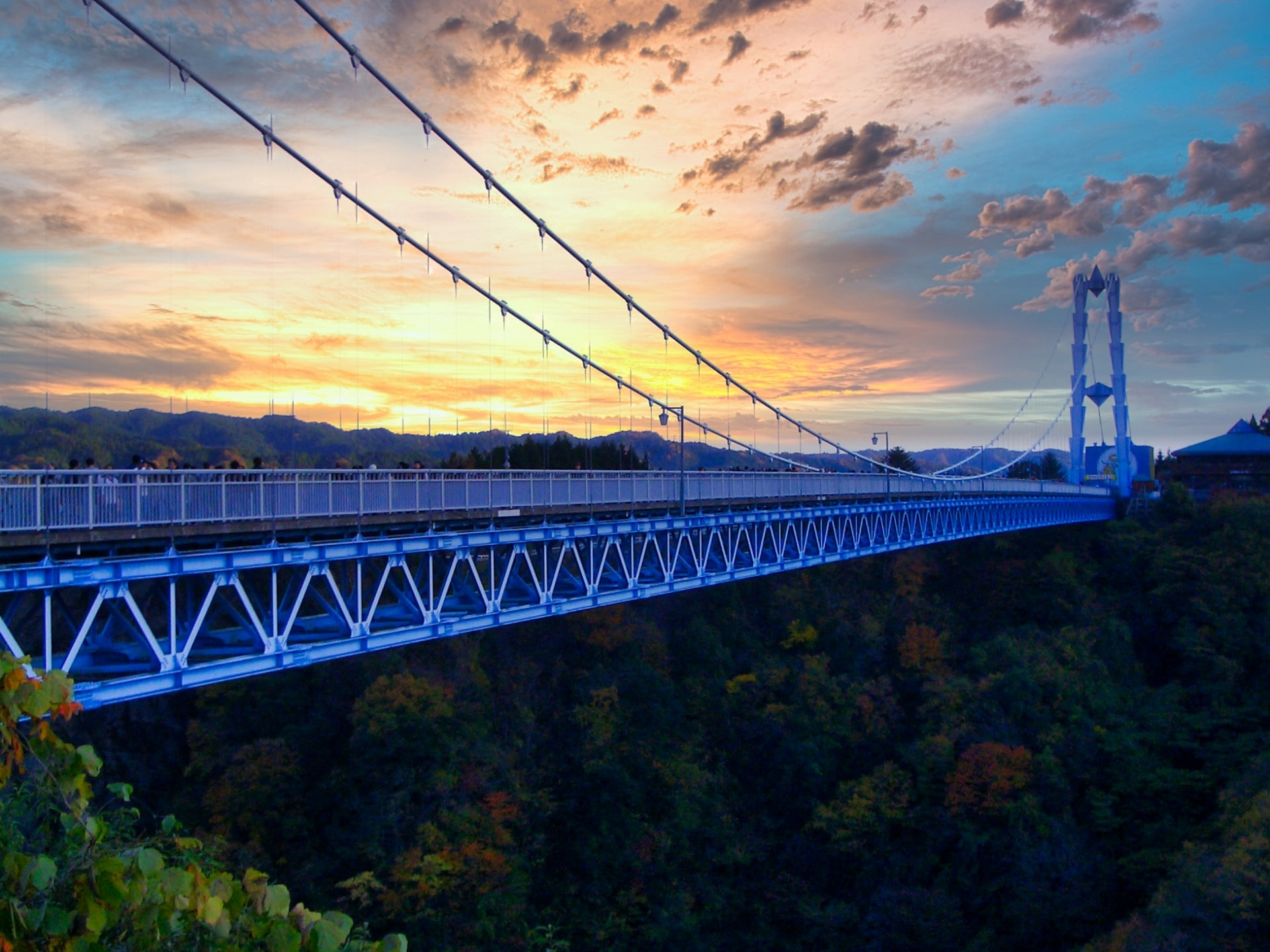
Coming to Ibaraki for the First Time? Here’s What You Should Know
You are probably coming from Tokyo, so your most convenient ridea are either the JR Joban Line from Ueno Station or the Tsukuba Express. Bear in mind that leaving the metropolis also means there are not so many public transportation options, so renting a car should be considered. Also, if you’re just coming for a day-trip, my top picks from this list that you should definitely not miss are Kairakuen and Oarai Isosaki Shrine! These are two of the most important places in all of Japan and they’re just a short 30-min drive from each other.
▽Here are the attractions you should experience across Japan with this Japan Bucket List!▽

Check best things to do in other prefectures in Kanto below!
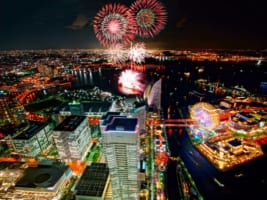
Ibaraki could be well considered one of Japan’s hidden jewels. Still reasonably close to Tokyo and full of impressive sights and experiences, it’s still unaffected by the woes of massive tourism that have started to affect some other famous Japanese locations during the past few years. But with so many interesting spots, it’s only a matter of time before Ibaraki is discovered by the spotlights! So I encourage you to take your chances and explore Ibaraki before the crowds take notice!
For more information about traveling in Japan, check these articles below, too!
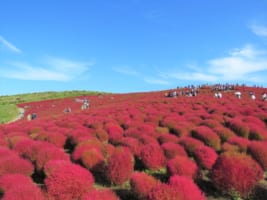
▽Related Articles▽
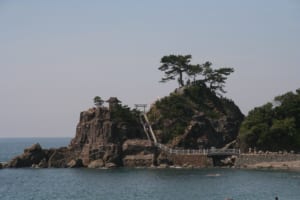
▼ Editor’s Picks ▼
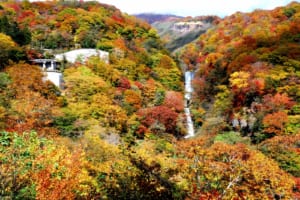
Photographer, journalist, and avid urban cyclist, making sense of Japan since 2017. I was born in Caracas and lived for 14 years in Barcelona before moving to Tokyo. Currently working towards my goal of visiting every prefecture in Japan, I hope to share with readers the everlasting joy of discovery and the neverending urge to keep exploring.
- Things to Do
12 Things to Do in Ibaraki in Spring
From plum blossoms to cherry blossoms and hydrangea, there are wonderful things to discover in Ibaraki from February to late June.
Makabe Hina Doll Festival
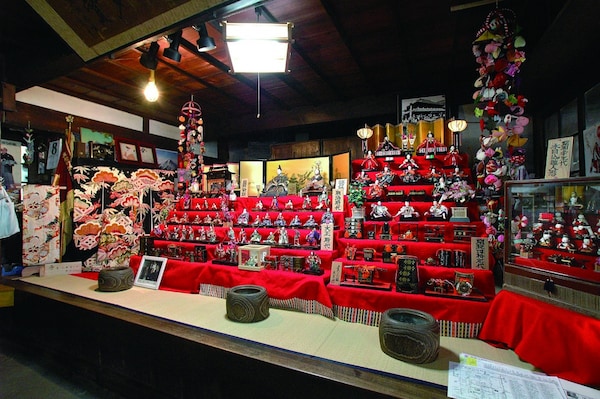
Hina dolls are decorated at nearly 180 houses on a charming street with storefronts. Access: 25 min. by bus from JR Iwase Station or 50 min. by bus from Tsukuba Station on the Tsukuba Express Line.
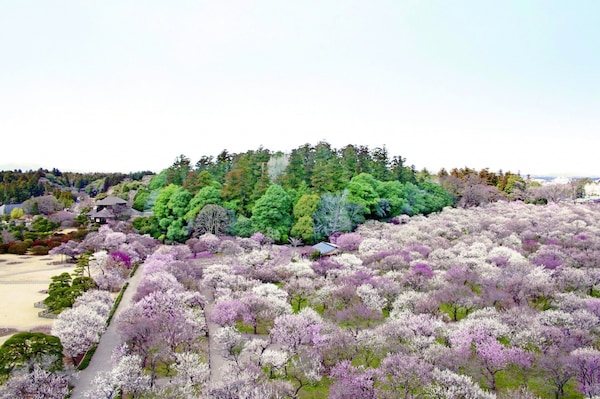
One of the Three Great Gardens of Japan. Established by the Tokugawa family, it is well known for its plum blossoms. Access: 20 min. by bus from JR Mito Station.
Koga Park (Peach Blossom Festival)
A park with different flowers in each season. Five different varieties of peach blossoms bloom during the Peach Blossom Festival. Access: 10 min. by taxi from JR Koga Station.
A Han school from the end of the Tokugawa Shogunate. Origin of the historical studies known as Mitogaku, which impacted many high-minded patriots. Access: 8 min. walk from JR Mito Station.
Kashimajingu-Shrine
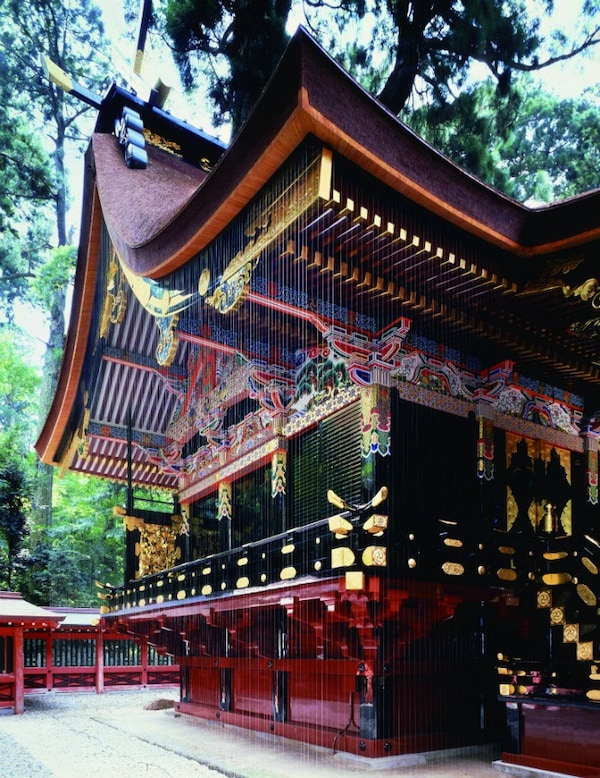
The head shrine for around 600 Kashima shrines across the country, with an exceptionally long history. Access: 10 min. walk from JR Kashima-Jingu Station.
Kasama Inari Shrine
One of the three leading Inari shrines in Japan, enshrining the deity commonly known as O-inari-sama. Access: 8 min. by bus from JR Kasama Station.
Hitachi Fudoki no Oka
Well known for Japan's largest lion head and as a good spot for viewing cherry blossoms. Access: Take a bus for 10 min. from JR Ishioka Station and walk for 15 min.
Art Tower Mito

A cultural complex with a concert hall, theater and modern art gallery, with a symbolic 100-meter-tall tower. Access: Take a bus for 10 min. from JR Mito Station and walk for 2 min.
Cherry Blossoms along Fukuoka-zeki

One of the three largest weirs (floodgates) in the Kanto region. There are around 600 cherry trees along the approximately 1.8-kilometer walking trail. Access: 10 min. by taxi from Midorino Station on the Tsukuba Express Line.
Hitachi Seaside Park (Nemophila)
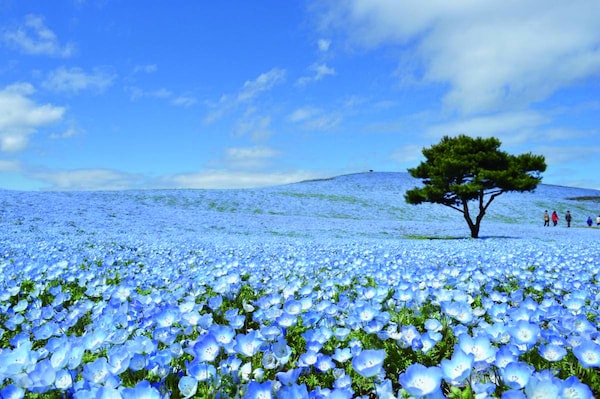
The view of the blue hill blends beautifully with the sky and sea. Access: 20 min. by bus from JR Katsuta Station.
Itako Riverside Iris Park
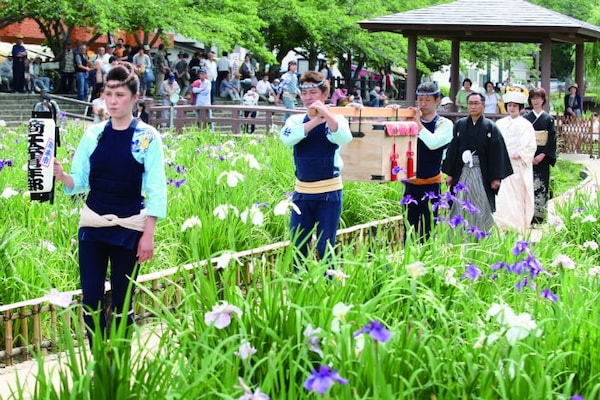
Enjoy the riverside atmosphere along with the view of a million irises in approximately 500 different varieties. Access: 1 min. walk from JR Itako Station.
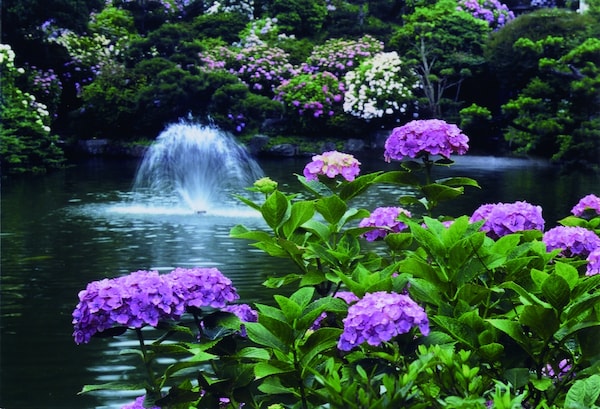
A purely Japanese-style garden with a pond and a small hill. In early summer, 6 ,000 hydrangeas of around 100 different varieties are in full bloom. Access: 14 min. by bus from JR Mito Station.

This website uses cookies.

- TRAVEL Where to Go When to Go What to Do Tips and Advice Where to Stay
- CULTURE Sports Arts & Entertainment Traditions Cultural Tips History
- FOOD & DRINKS Where to Eat Bars and Brewery Regional Specialty
- SPECIAL EVENTS Festivals Shows & Concerts Tournaments & Competitions Exhibits
- ANIME Anime Spots Anime Events Recommendations Anime Tours
- LUXURY Experiences Luxury Accommodations Dining Luxury Tours

LEARN ALL ABOUT IBARAKI PREFECTURE AND SOME THINGS THAT MAKE IT UNIQUE!

The Fukuroda Waterfall of Daigo, Ibaraki in the Summer The Fukuroda Falls fill the Taki River below. The water flows down from a height of 120 meters (400 feet) down and across four tiers 73 meters (240 feet) wide, which makes this waterfall one of the most sought-after destinations in Japan . Each season offers its own exclusive experience including fiery leaves in autumn and ice climbing on the frozen streams in winter . Along with Nachi Fall in Wakayama Prefecture and Kegon Fall in Tochigi Prefecture , these three great falls look more like cloth fluttering down than water. I felt dizzy climbing the stairs to each viewing tiers (opting not to take the available elevators) and the whooshing of the falls followed me across the suspension bridge. From the top, I felt extremely calm, and my head and sight realigned thanks to the effervescent presence of the falls.

Mt. Tsukuba

The View of Kanto Plain from Mount Tsukuba at Night According to legend, a deity landed on Mt. Fuji and asked to stay for the night. Proud Mt. Fuji refused the god, but humble Mt. Tsukuba, of Tsukuba City, welcomed the guest. As a result, Mt. Fuji’s slopes are cold and barren, while Mt. Tsukuba bursts with vegetation. You can reach Mt. Tsukuba’s summits by hiking the 877 meters (2877 feet) in a 2-hour summit, or by taking the ropeway or the cable car. If you reach Mt. Tsukuba by bus, get off at the Tsukubasan Jinja Iriguchi stop and take the cable car. For visitors coming by car, we recommend taking the ropeway. Mt. Tsukuba famously has two peaks, Mt. Nantai-san and Mt. Nyotai-san, which represent a married couple. Shintoists seek blessings for marital bliss, and each season gives a different face of the mountain. Late winter, early spring , and fall, the milder seasons for outdoor excursions, provide the most spectacular views. From mid-February to mid-March , Mt. Tsukuba heralds the arrival of spring as over 30 varieties of plum trees burst in bloom. From the end of September to November , crimson and gold autumn leaves paint the slopes in a magnificent display.

A Young Man Bungee Jumps from the Ryujin Suspension Bridge in the Spring The Ryujin Bridge stretches 375 meters (1230 feet) to connect the two sides of this gorge in Hitachiota City. The Ryujin river curves through the valleys like the dragon said to have lived here long ago. Historical sites like Higashi Kanasa Shrine pepper the national park below, and ancient, traditional festivals take place throughout the year. Hiking trails ranging in beginner and advanced levels circle around Ryujin river in the off seasons for festivals. Each trail exceeds 5 km (3 miles) and offers visitors a chance to take in the rocky courses of legend, brilliant virgin forests, and the promenade by the clear lakes .

Festival Goers Enjoy a Field of Iris One of Ibaraki’s oldest traditions takes place in Itako City. As the Iris bloom in June , wedding season starts and the Suigo-Itako Ayame Festival opens. During this time, brides don traditional wedding gowns and board yomeiri boats. They cross the river in front of spectators to meet their husbands on the other side. The flower festivals of Ibaraki have attracted visitors from all over the world in recent years. The rich soils of Ibaraki don't only make famous sites but also famous food and arts.

Anglerfish Hot-Pot

Hoshi Imo Ibaraki’s famed dried sweet potatoes ( Hoshi Imo ) make the perfect souvenir to share with friends and family back home. Ibaraki’s ability to grow and ship potatoes and other crops goes unmatched by most parts of Japan. You can experience rural lifestyles in more immersive situations, like staying on a farm and helping with the harvest. Or, in an hour by paying a flat fee to pick and eat as much fruit from orchards and vineyards as you like. Fish and seafood fill the nearby shores. Homecooked Anglerfish Hot-Pot, a favorite amongst locals in winter, filled with Ibaraki vegetables makes the perfect dinner during your stay here .

A Pottery Artist Creates a New Piece

Kagami Crystal Glass The handmade ceramics of Kasama, Ibaraki top the art world in Japan. Kasama holds a festival every year for local artists to sell their wares during Golden Week ( April 29 - May 5), and Japanese people from as far as Hokkaido and Okinawa attend. The highly sought after Kagami Crystal, although made as far back as the Edo period by individuals, only became more available to the public when Ibaraki opened the first factory for mass production. I hope this short highlight of Ibaraki’s natural, man-made, and historical features has moved you to want to delve deeper into this wonderful prefecture. For a more in-depth look at things to do, see, and eat in Ibaraki, check out our other blogs on this wonderful place!
10 THINGS TO DO IN IBARAKI
Day trip from tokyo: ibaraki, see kochia at hitachi seaside park in autumn, where to stay in ibaraki: the mito plaza hotel, click here to see our group tours to hitachi seaside park in ibaraki prefecture, click here to create your private journey to ibaraki prefecture.

NORTHERN OR SOUTHERN JAPAN? WHICH TO VISIT NEXT
TRAVEL | Where to Go
Article | April 22nd, 2024 | May Hamamoto
Can’t get enough of Japan after visiting Tokyo, Kyoto, and Osaka, but are torn between the charms ......

12 OF OUR FAVORITE JAPANESE FESTIVALS
SPECIAL EVENTS | Festivals
Article | April 11th, 2024 | Dayna Hannah
Attending a Japanese festival is an experience unlike any other! Here are our favorite annual events......

WHEN TO SEE CHERRY BLOSSOMS BLOOM IN JAPAN | 2024
TRAVEL | When to Go
Article | March 29th, 2024 | Dayna Hannah
From Okinawa to Hokkaido, here's where and when to see cherry blossoms in Japan.......
Search Group Tour
2024, 2025 & 2026 group tour calendar, subscribe to blog via email.
Your Email Address
POPULAR ARTICLES

TOP PLACES TO SEE IN JAPAN IN 2024: 20 CITIES WE LOVE

50 THINGS TO DO IN JAPAN

WHEN IS THE BEST TIME TO VISIT JAPAN?

WHAT IS KOBE BEEF?

WHAT IS GEISHA

10 THINGS TO DO IN SHIBUYA

JAPANESE FOOD

5 Things to do on a Day Trip to Ibaraki
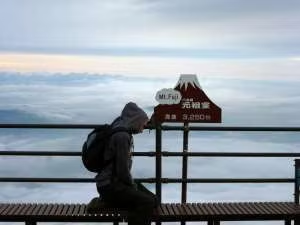
by GoWithGuide travel specialist: Luke K.
Things To Do
Ibaraki Prefecture can be reached in under one hour from Tokyo. If you are looking to get out of the city and explore somewhere new, then a day trip to Ibaraki can offer many different attractions to keep you entertained. From bungee jumping to space exploration, here are just five great suggestions for a one day trip to Ibaraki:
1. jump off a suspension bridge.
(image by photozou.jp )
This symbolic bridge has giant blue steel towers which evoke a dragon dancing through the sky. The dragon that is illustrated on the walls is also spectacular. At Ryujin Gorge which the bridge passes over, there are also many events throughout the seasons which take advantage of the wonderful view. There is the Koi Nobori (Carp Streamer) Festival from mid-April to mid-May. About 1000 streamers are hung by the bridge to pray for the healthy growth of children, and the sight of magnificently competing streamers over the wonderfully green Ryujin Gorge is overwhelming. During this period, mini carp streamers also make an appearance on the major roads in the area. On Children’s Day (May 5th), kids of junior high school age and younger can cross the bridge for free. From early August to mid-August, the Lantern Festival is held. 500 lanterns and 100 bamboo lanterns (candles placed in hollow bamboo trunks) decorate the area around the bridge which bring about a magical world.
A splendid soundscape is also created from the many wind chimes that come in from all over the country. Admission to cross the bridge is free after 5 p.m. on the days when the lanterns are lit. During November, there is the Fall Foliage Festival. There are many strangely-shaped rocks on the precipices, and Ryujin Gorge stands out even further with the many changes to features such as the waterfalls, the deep pools and the shallows. In this period, the much-praised fresh Hitachi Autumn soba can be eaten. All kinds of events can be enjoyed such as a stamp rally for the surrounding area and wadaiko drum performances. Then, there is bungee jumping which sprang into fame overnight due to a commercial. Since its beginnings in March 2014, over 10,000 people have already taken the plunge. There are plenty of thrills and exhilaration with this dive from the Japan’s highest jump at 100 meters. At several places across the bridge, there are acrylic windows from where you can look straight down into the gorge.
Admission: Adult: ¥ 310 / Child: ¥ 210
- Guidebook from Planetyze about Ryujin Large Suspension Bridge - Reviews from TripAdvisor about Ryujin Large Suspension Bridge - Tours of Ryujin Large Suspension Bridge
2. Learn about going to space
(image by flickr.com )
JAXA (Japan Aerospace Exploration Agency) is an organization bringing together Japan’s researchers in space development. Its Tsukuba Space Center has been a base for the country’s space development work since its inception in 1972. General entry is possible and visitors can experience cutting-edge technology up close. On entering the facility, the first thing that can be seen at Rocket Plaza is the 50-meter H-II rocket. The purely domestically-made rocket which took about 10 years to develop has a size which is eye-opening. The Space Dome which is the permanent display area is divided into 5 areas in which actual satellites, genuine rocket engines and a life-size model of the Japanese Experiment Module “Kibo” (Hope) can be seen up close. There is also a mini-lecture of about 25 minutes given 5 times a day which doesn’t require any reservations. At the back of the Space Dome, there is Planet Cube. There are special exhibitions under themes that change every season and a museum shop. Products related to space such as space food and stationery are popular.
The popular facility tour requires advance reservations. The 3 courses that have been operating up to now will be made into 1 course from October 2015 which will require admission (70 min. duration). The “Kibo” operations control room and the basic training facilities for astronauts are seen here. Also twice a year in spring and autumn, there are special exhibitions in which otherwise inaccessible buildings can be entered so that visitors can get an even deeper knowledge about space.
Admission: Free
- Guidebook from Planetyze about Tsukuba Space Center - Reviews from TripAdvisor about Tsukuba Space Center - Tours of Tsukuba Space Center
3. Enjoy fish at an interactive aquarium
(image by commons.wikimedia.org )
One hour by train directly from Tokyo . The Kanto region’s largest aquarium is composed of 9 areas. In the Encounter Sea zone, there is the giant water tank that is the largest in the entire facility in which you can see the amazing sight of 20,000 fish representing 80 species from offshore Oarai. In the Seas of the World zone, you can see the sharks that are the symbol of the aquarium. Within this zone, you will want to focus on the common smooth-hound, the only shark of its type found only at this aquarium. In the Ocean Sunfish tank which is the largest of its type in the entire nation, several ocean sunfish are raised.
The aquarium also has a Museum zone that is not found in any other current aquarium in which there are numerous deeply interesting exhibits such as a model of a shark 4 meters in length, a model of the world’s largest ocean sunfish, and a specimen of a shark’s tooth. Another attractive feature is the many opportunities for interaction. There is the popular program of the 50-minute Exploration Tour at the Backyard of the aquarium. Separated into the 2 courses of General and Specialist, they are held 3 times a day. The numbered tickets that are distributed when the aquarium opens are given out on a first come, first serve system so you will want to come to the aquarium early.
Then, there is Kidsland which is popular with children. They can watch the 15-minute Fun Fact Fishing video which is shown 4 times a day and enjoyably learn about ocean life through experiments. At the Touching Pool where you will be able to get in touch with the animals, you can pick up creatures such as starfish and sea urchins. Doctor fish which nibble on the cuticles of people are raised here and once you place your hand into the water tank, it’s fun to see the fish close in and start nipping at your skin. You can also observe the Penguins’ Walk Time, and the Aqua Viewing is also popular for being able to chat with the divers in the water.
Admission: Adult: ¥ 1,850 / Child: ¥ 930
- Guidebook from Planetyze about Aqua World Oarai Aquarium - Reviews from TripAdvisor about Aqua World Oarai Aquarium - Tours of Aqua World Oarai Aquarium
4. Enjoy a nice cold beer
(image by アサヒビール )
The Ibaraki factory opened in 1991. Its 130,000 sq. meter grounds include Japan’s largest beer manufacturing line. In its beer division, 6 brands are brewed including the brand with the largest share in the nation, Super Dry. Outside of the factory, there is a battery of 150 fermentation tanks which can hold the equivalent of 1.4 million 350ml cans of beer! The part of the factory where the final stage of packaging takes place also has jet machines of considerable size. The sight of the many lines going at full speed is incredible.
The factory tour lasts for 90 minutes in which you get a deep understanding of the fermentation process through actual handling of the hops and malt, tank models and a video of the fermentation taking place. After the tour, the beer tasting takes place atop the 60m AIM Tower where you can drink up to 3 tumblers of 4 types of Super Dry. The snacks that are provided with the beer are only found at the Asahi Beer Factory. Popular and delicious, they can be bought as souvenirs at the 1st floor gift shop. Soft drinks are also provided so even non-drinkers can enjoy themselves. That one glass while looking over the Kanto Plain is an exceptional experience.
Another highlight is the lush open garden within the grounds. Located in front of the orientation theater before going on the factory tour, observers inside the factory might feel that they are right in the middle of the water since the pond has a higher location. In the garden, there are about 30 types of trees and flowering plants, and you can take a walk through the area before and after the tour.
Admission: Free
- Guidebook from Planetyze about Asahi Beer Ibaraki Factory - Reviews from TripAdvisor about Asahi Beer Ibaraki Factory - Tours in Asahi Beer Ibaraki Factory
5. View a frozen waterfall
Fukuroda Falls is located on the Taki River, a tributary of the Kuji River which flows from Ibaraki Prefecture into the Pacific Ocean. One characteristic of Fukuroda is the large 4-tiered rock face over which the water flows like a ribbon being pulled. It is from there that it was given its alternate name of Yodo (4 times) Falls, but according to one story, a legendary poet from the Heian Era, Saigyo, once remarked “One has to come and see the waterfall once every season to get a sense of its true character” as a form of praise which may also be the origin for the name. It is from its beauty that it was selected as one of the Three Great Waterfalls of Japan. The town of Daigo where the waterfall is located is in the middle of the mountains so it gets especially chilly in the winter. For that reason, the water that flows over the falls freezes and Fukuroda becomes a pure white ice fall which can be observed.
During the winter, there are events which include the lighting up of the falls, and the illumination of the suspension bridge in front of the observation point which create a wintry fairytale-like scene. Also the autumn colors at the falls and in the surrounding vicinity between early and mid-November are a highlight. The trees that turn red and gold during that time bring out the wonder of the falls. There are 2 ways to reach the observation point. The course that heads for the point by getting out of the tunnel is impressive for suddenly bringing the falls right in front of you, while the approach from the riverside walking path on the opposite side means that you can see the falls from a distance and it’s great for that leisurely stroll while enjoying the combination of the falls with the autumn colors. Along with being able to view the front of Fukuroda Falls from the observation point, there is another observation point 40m above the ground which can be accessed from behind via 2 elevators so that you can get a bird’s-eye view of the falls. If you’re good at walking, then taking the Tsukioreyama hiking course is also good. The 20-minute trip up to the top ensures a close view of Fukuroda Falls that can only be seen by the climbers.
Admission: Adult: ¥ 300 / Child: ¥ 150
- Guidebook from Planetyze about Fukuroda Falls - Reviews from TripAdvisor about Fukuroda Falls - Tours of Fukuroda Falls
Popular Tokyo Tour Guides
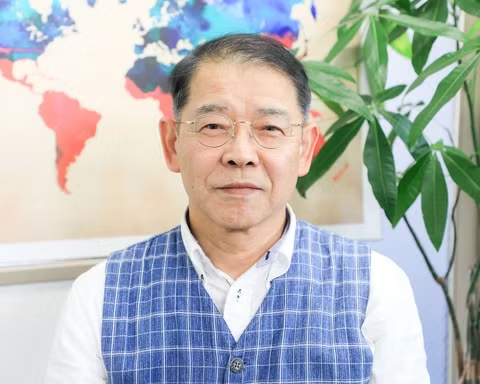
Hello, my name is Yasuro (Mr). I was born and brought up in Kansai, graduated from a univ in Kobe city, after moved into Kanto, 30 years in Tokyo, 2.5 years in Nagoya city, 7.5 years abroad (KL & S'pore) as a rep of a construction company and I got the National Guide Certificate in 2011. My hobbies are making Haiku poems, singing various songs (voice-training for 18 years), playing the folk-guitar, trekking in mountains like Takao and Okutama in the West of Tokyo, visiting museums like in Ueno Park and travelling around Japan to make Haiku poems. Thank you for your attention.
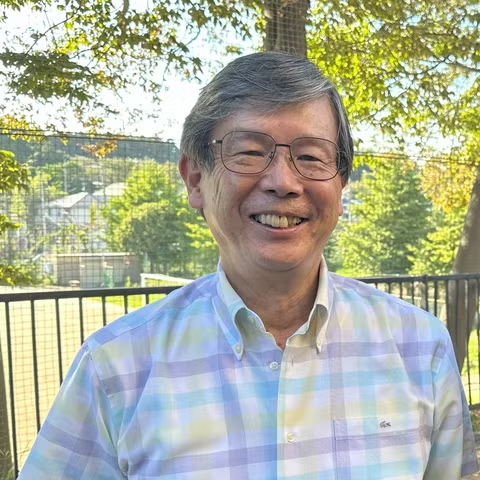
I’m so excited to have a chance to show you around my favorite spots in Kanagawa prefecture. I was born in Kanagawa. I spent my whole school life, including university, here in Kanagawa. I worked as a high school English teacher here for 40 years. I love Kanagawa so much. We have many interesting tourist spots, like Hakone, Kamakura, Enoshima and Yokohama. I got my tour guide license in English in 2009. I am still an English teacher. To give an interesting and impressive lesson to young high school students, I’ve learnt and gathered many kinds of information. I also have a license to teach social studies, so I have a wide range of knowledge about Japanese culture and history. I’m sure to provide you an interesting tour.

My name is Shusaku. I was born and raised in Osaka, where I had the opportunity to immerse myself in the beautiful landscapes and rich culture of the region. During my travels to 10 different countries, I came to realize the importance of listening to the locals to truly understand the culture and charm of a place. This experience taught me that local knowledge and experiences are invaluable in building a deeper understanding and connection while traveling. In my tours, I make it a point to not only showcase the popular tourist destinations but also to share insights into the everyday lives of locals and the culture of the region. By incorporating stories and knowledge from locals, I aim to provide a more enriching travel experience. My mission in life is to foster a deeper understanding of the world through travel and to build connections with people from different backgrounds. I look forward to creating unforgettable memories and sharing new discoveries with all of you!
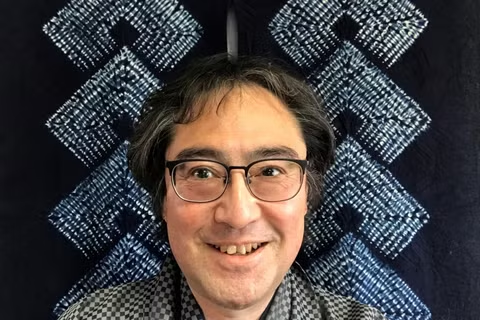
I live in Yokohama, Kanagawa prefecture. I have a license to teach in high schools and was admitted to the degree of Master of Arts in Teaching English as a Second Language in the University of Birmingham. Until 2015 I had been teaching English at public high schools in Kanagawa for 37 years. During that time, I had some experience of guiding students from overseas through sister-school relationship around Tokyo and Kanagawa. Therefore, I had good command of English with the TOEIC score of 935. As for a tour guide experience I earned the certificate of National Government Licensed Guide-Interpreter in English and since then I have guided tourists to the popular sites around Tokyo, Yokohama, Kamakura and Yokosuka. My guiding focuses on introducing not only Japanese historical and cultural backgrounds but also giving tourists some tips to travel Japan only by themselves, such as how to use trains and subways, find good restaurants, reserve tickets, buy survenier, and speak basic Japanese. In addition, my tour includes opportunities to experience Japanese culture like Zen meditation, ninja performance, visiting anime's location sites based on tourists' request. Besides, by means of my hobbies of writing English Haiku and Waka (traditional Japanese poems) and performing Rakugo (traditional Japanese funny story telling) in English, I can surely entertain tourists during the tour. My moto as a tour guide is let the tourists have a once-in-a-lifetime experience in Japan with my profound, intelligible and interestiog guiding.
Plan your trip to tokyo.
Chat with a local tour guide who can help organize your trip.
Related Blogs
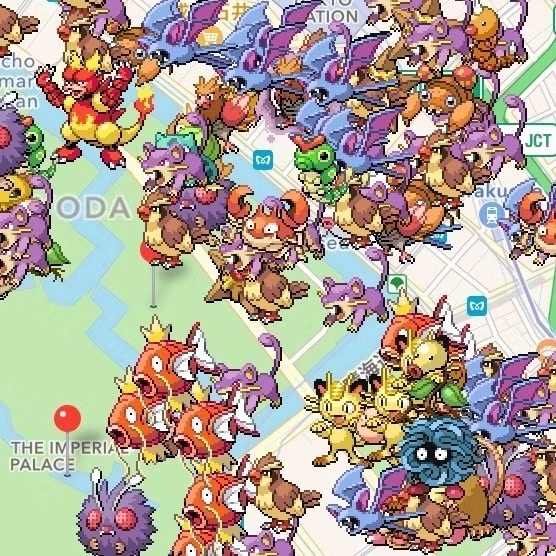
10 Best Places for Pokémon Go in Tokyo
Tokyo, Japan
⭐⭐⭐⭐⭐ Come & enjoy the beauty of Japan with our highly rated Japan private tours. LAST UPDATED: October 15, 2022 TLDR: The 10 best places for P...

Tokyo's Top 10 Sites for Anime and Manga Lovers
Tokyo, and in particular akihabara, has a plethora of museums, shops, cafes, and other sites targeted towards anime and manga lovers. as such, tokyo ....

10 Must-Go Shopping Destinations in Shibuya
Shibuya is a popular shopping district within tokyo where you can find a variety of places for entertainment and recreation such as shopping malls, re....

10 Best Onsen (Hot Springs) Around Tokyo
⭐⭐⭐⭐⭐ come & enjoy the beauty of japan with our highly rated japan private tours. last updated: october 15, 2022what is an "onsen"an "onsen" (温泉) is ..., follow us on social media.
- - K-town Now
- Asia-Pacific
- - Storm Tracker
- Middle East
- Map of Memorials
- Entertainment
- - Video Games
- Europe Travel
- - Quick Trips
- - After Hours
- Pacific Travel
- The Meat and Potatoes of Life
- U.S. Travel
- Storm Tracker
- Rewards for readers
- Get Stripes
- Stripes Lite
- Archives/Library
- Special Publications
- Mobile Apps
- Email Newsletters
- Digital Access
- Home Delivery
- Marine Corps
- Coast Guard
- Space Force
- Archive photo of the day
- - Schedules Europe
- - Scoreboards Europe
- - Schedules Pacific
- - Scoreboards Pacific
- - Pacific Sports Blog
- - WW II Podcast
- - Military Matters
- - Force for Hire
- Out of Uniform
- - WW II Videos
- Communities
- Stripes Europe
- Stripes Guam
- Stripes Japan
- Stripes Korea
- Stripes Okinawa
- Our Other Websites
- In Memoriam
- Month of the Military Child
- Best of Germany
- Best of the Pacific
- Letters to Santa
Quick Trips
Oceanside oarai a family-friendly getaway in japan.
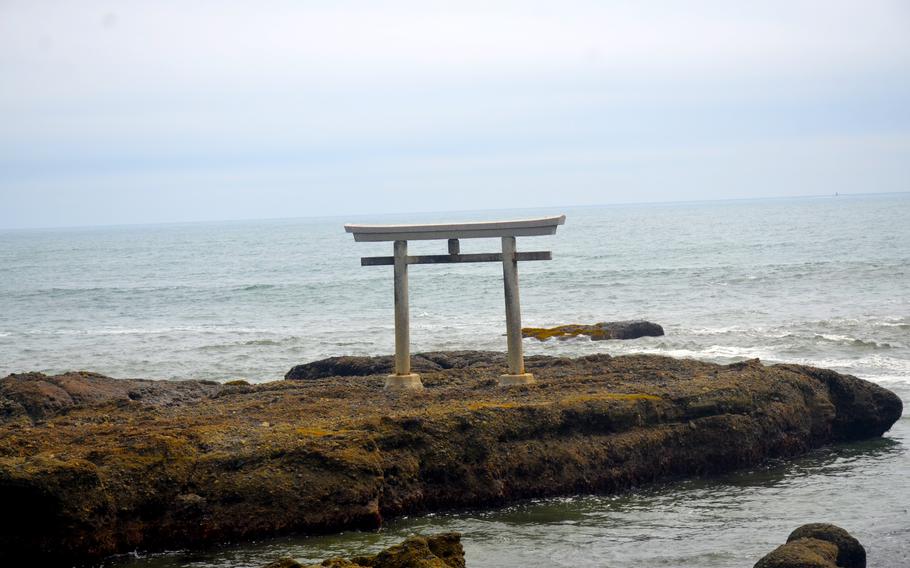
Oarai's Kamiiso no Torii, a gate erected on coastal rocks, is a popular spot for photographers to catch the sunrise. (Alex Wilson/Stars and Stripes)
Japan may have a reputation for exemplary public transit systems, but small towns such as Oarai in Ibaraki prefecture present the perfect opportunity for a weekend road trip with the family.
Nestled between Lake Hinuma, the Naka River and the Pacific Ocean, Oarai is 9 square miles with a population of approximately 15,000 people. It lacks the hustle and bustle of Tokyo, Yokohama or Kyoto, but holds a wide variety of entertainment for anyone interested in Japanese food, culture and history.
The town’s premier attraction is Aqua World, a five-story, 213,000-square-foot aquarium that’s home to 68,000 fish and other sea creatures for a total of 580 different species. The aquarium is also home to Japan’s largest variety of sharks, with 59 different species on display.
For families more interested in eating fish than looking at them, Oarai boasts a highly popular open-air fish market that’s just a 15-minute walk from Aqua World.
At Nakaminato Fish Market, just south of Oarai’s main port, visitors may purchase freshly caught fish or try authentic Japanese cuisine such as sushi or takoyaki.
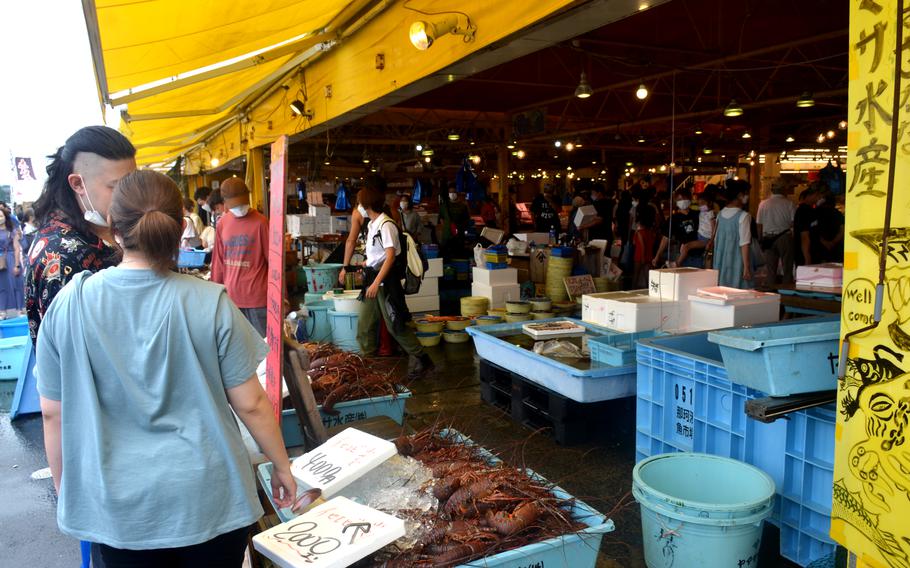
The Nakaminato Fish Market is just south of Oarai's main port and features a wide variety of fresh seafood and seafood restaurants. (Alex Wilson/Stars and Stripes)
Traveling farther south along Oarai’s coastline, visitors may find the town’s most picturesque attraction, a site much older than anything else in town.
Built more than 1,000 years ago, the Oarai Isosaki Shrine is a Shinto temple dedicated to Daikoku-sama, a god of nation-building and prosperity, and Sukunahikona no Mikoto, a god of medicine.
A short walk from the shrine is Oarai’s famous Kamiiso no Torii. A traditional Japanese torii, or gate, marks the entrance to a shrine or other sacred site. The Kamiiso no Torii is built on a series of oceanside cliffs. Mornings at the location are awash with photographers, who hope to catch the dramatic scene of the sun rising alongside or within the gate itself.
Oarai is a 1 ½-hour drive from Tokyo or 2 ½ hours from Yokosuka, just the right destination for a weekend getaway or a daytrip.
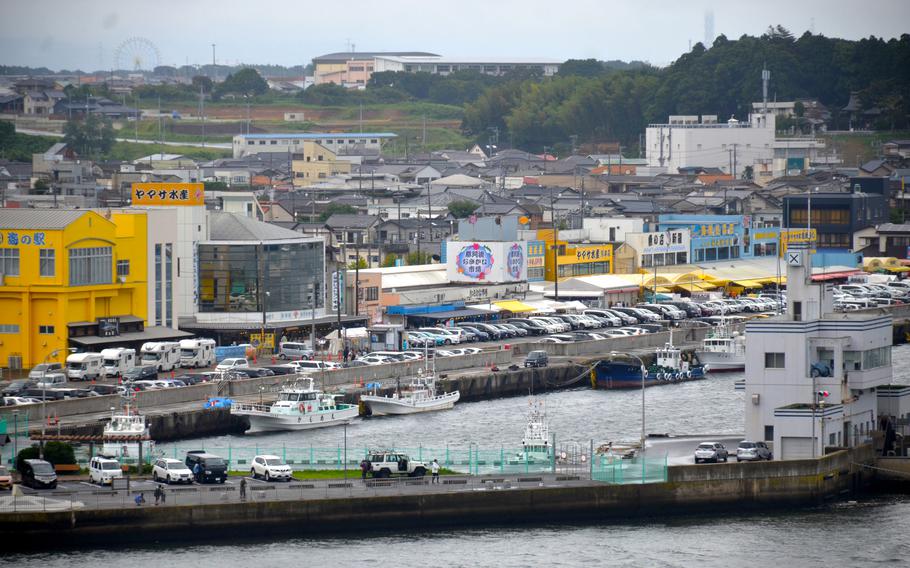
The small town of Oarai is a well-known fishing village with an open-air seafood market and a large aquarium. (Alex Wilson/Stars and Stripes)
Without a car, the easiest option is to take the JR East Line from Shinagawa Station to Mito Station, and then transfer to the Kashimarinka Tetsudo Oarai-Kashima line. Oarai’s expansive topography makes an ideal setting for a drive, but pedestrians may easily find a bus or taxi. And the small-town scenery makes for a great view while walking too.
Location: Higashiibaraki district, Ibaraki prefecture (Google coordinatates: 36.315730, 140.573809)
Directions: Shinagawa Station’s JR East Line to Mito Station, Kashimarinka Tetsudo Oarai-Kashima Line to Oarai Station.
Cost: Aqua World admission: 2,000 yen ($13.51) for adults; train fare: 4,220 yen
Food: Fresh seafood, sushi, Chinese cuisine, Italian
Information : www.Oarai-Info.jp/page/dir000476.html
Twitter: @AlexMNWilson
Sign Up for Daily Headlines
Sign up to receive a daily email of today's top military news stories from Stars and Stripes and top news outlets from around the world.
Sign Up Now
Hitachi Seaside Park
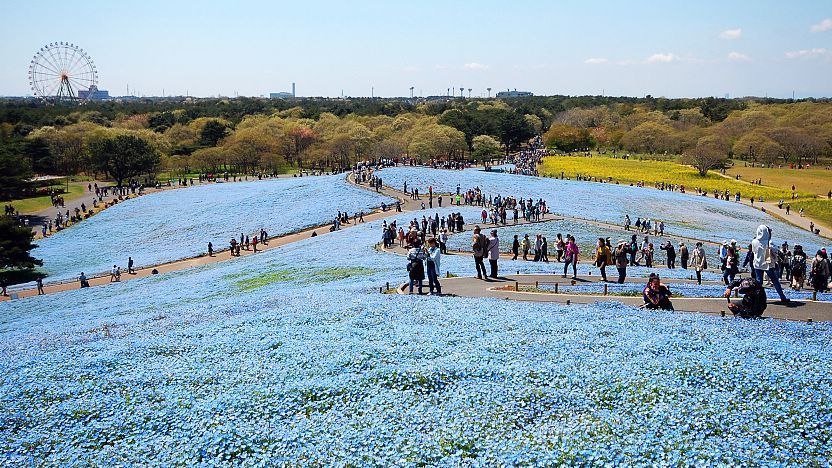
Hitachi Seaside Park (�Ђ����C�l����, Hitachi Kaihin Kōen) is a spacious park near Mito in Ibaraki Prefecture featuring a variety of green spaces and seasonal flowers spread out across 350 hectares, as well as an amusement park and several cycling and walking trails.
The park's iconic flower is the blue nemophila, which covers Miharashi Hill in the spring and mimics the color of the sky. The flowers are usually at their peak from late April to mid May. Paths crisscross the hill providing views over the Pacific Ocean and the rest of the park. In fall, the hill is covered by green kokia bushes which slowly turn red as the weather turns cooler. These autumnal colors are usually best from early to mid October.
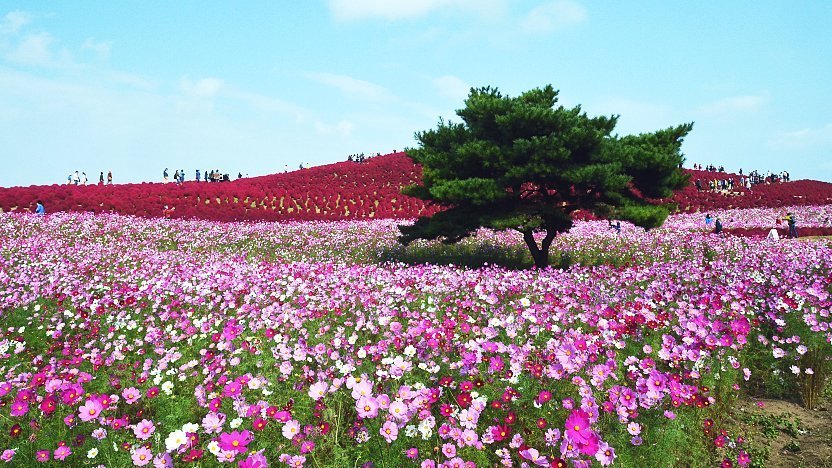
Although the nemophila are the most well-known of the park's flowers, assorted other flowers bloom throughout most of the year. Near the park's main entrance is a large forested area featuring the Suisen Garden where narcissus usually bloom from mid March, while across the lake tulips bloom usually around late April.
Although flowers are seasonal highlights, the park can be enjoyed year round. There are walking trails through the extensive Hitachinaka Nature Forest, while the Dune Garden showcases plants native to the coastline of Japan. Even when the rest of the park is crowded, this area often remains relatively quiet.
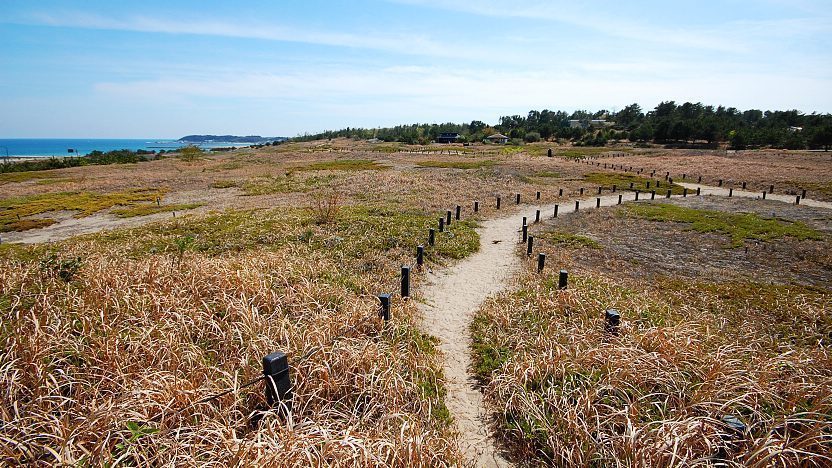
Hitachi Seaside Park also features a small amusement park with over 25 rides and attractions, including a 100 meter tall Ferris wheel, putter golf, a BMX course and a roller coaster among others. Most of the rides and activities require extra fees. Restaurants and rest areas are scattered throughout the park, and a BBQ area is available for picnics.
Due to the size of the park, there are two other methods of getting around besides walking. Rental bicycles are available starting from 450 yen for three hours of use, and almost eleven kilometers of cycling paths - separate from pedestrian paths - allow easy access to the different areas of the park. A small train (on tires) also travels the perimeter of the park with stops at numerous locations. The train costs 600 yen for a 1-day pass.
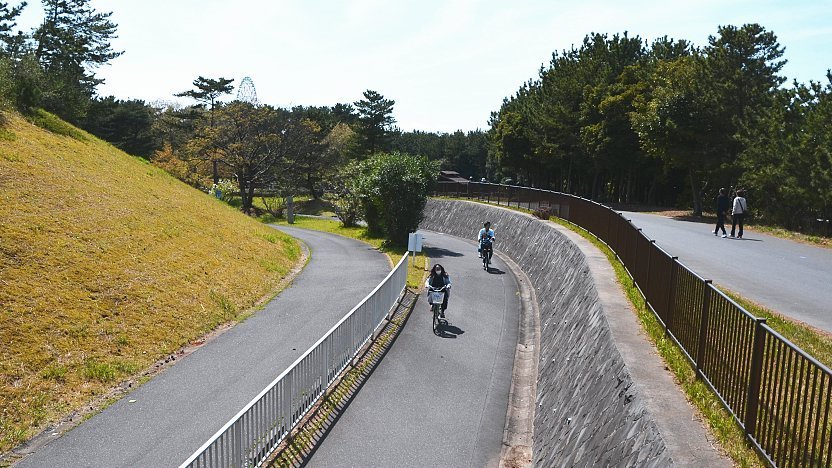
Getting there and around
From Mito Station , take the JR Joban Line to Katsuta Station (5 minutes, 190 yen one way, multiple trains/hour), from where the buses takes you to the park (15 minutes, 400 yen one way, every 20-30 minutes).
By highway bus from Tokyo
Infrequent, direct highway buses connect Tokyo Station with Hitachi Seaside Park. The one way ride takes about 2.5 hours, costs 2300 yen and is not covered by the Japan Rail Pass .
How to get to and around Mito
Hours and Fees
Questions? Ask in our forum .
Links and Resources

- Tours & Experiences
- Tailor-made Trips
- Bahasa Indonesia
We are happy to see you again!
Continue with
Or use email.
No Account? Create one
Create account
Already have an account? Sign in
Quickly Sign up with
I agree to Japan Travel's Terms of Service and Privacy Policy . Terms of--> and acknowledge that Japan Travel's Privacy--> applies to me.-->
Email reset password link
Please check your inbox and click the link we will send to you.
A Day Trip to Yūki, Ibaraki
A city with a long history of Japanese textiles

Textiles have long played an important role in Japanese life. Japanese weavers and dyers developed their own distinctive styles with silk, hemp, cotton and other fibers, by using a range of weaves and decorative treatments. Japanese textiles are world-renowned for their intricate design and beautiful natural color, and although through the years new styles have evolved to reflect today’s trends, their original aesthetic and traditional technique has been retained.
One important textile center of Japan lies just 60-minutes north by train from Tokyo in a charming city called Yūki, located in Ibaraki Prefecture. It is a city rich in tradition and it is the birthplace of Yūki-Tsumugi. Yūki-Tsumugi is a Japanese silk-weaving technique with a 2,000-year history and is regarded as one of the highest-quality silk textiles in Japan. It is known for its strong, but light and soft characteristics giving it the reputation as being the finest of kimono textiles that can last for three generations and with a bit of cleaning and care even longer.
Yūki-Tsumugi is a technique so unique that in 1956 the Japanese Government designated it as a nationally important intangible cultural heritage and in 2010 it was inscribed on the UNESCO Representative List of the Intangible Cultural Heritage of Humanity. To produce Yūki-Tsumugi, it takes about 40 processes all done by hand, from taking the floss of silk worms and spinning it to yarn to dyeing the yarn then on to weaving, and depending on the detail it is a process that could take from several months up to one year or more for one 13 meter-long textile which would create one kimono.
The history and the technique of producing Yūki-Tsumugi is fascinating and one of a kind, it continues to be handed down from generation to generation, with many of the skilled men and women involved in the process still living in Yūki to this day. Taking a trip to Yūki you can learn first hand the history of Yūki-Tsumugi and experience some of the process through a number of the workshops that are offered.
You can find many of the cultural centers, museums, and shops within walking distance to each other and not far from the city’s main train station Yūki Station. Upon arriving at Yūki Station you will find the Tourist Information Center just outside to the right of the building. In the same building there is Kiraku Kimono Dressing Room where on weekends from 10AM - 3PM you can experience wearing your own Yūki-Tsumugi kimono. The cost for the daily rental is JPY 2,000 for females and JPY 2,500 for males.
There are a couple of recommended places to visit to learn about the history, technique and process of Yūki-Tsumugi. One is the Yūki City Traditional Crafts Center , they are open everyday from 10AM - 4PM, except Wednesdays. Here you can find a detailed overview in English of the history and each step in the process of Yūki-Tsumugi. There are even areas to experience spinning the silk floss into yarn for free or weaving your own item such as a coaster for JPY 1,500 while experiencing using the traditional weaving loom called a Jibata.
Another place is Tsumugi-no-Yakata , a facility that consists of several traditional Japanese-style buildings that surround a beautiful and peaceful courtyard. The facility has a museum showcasing the history of Yūki-Tsumugi, a workshop area for weaving experiences and indigo plant dyeing experiences, in addition to an exhibition hall and shop where you can view and or purchase a variety of items created from the Yūki-Tsumugi technique. Tsumugi-no-Yakata is open daily from 9AM - 5PM, except on Tuesdays.
While walking through the city, you will certainly pass many traditional shops selling local food products and delicacies of Yūki, such as miso, soy sauce, sake, and a sweet treat called yude manjyu (a boiled rice cake served warm with red bean paste). Don’t miss out on the many temples, shrines, and historic cultural properties to be explored in city as well. There are many places of interest to make a day trip to Yūki a fulfilling experience.
- Share on Facebook
- Share on Twitter
- Copy link to share
By Niaya Harper
Community writer
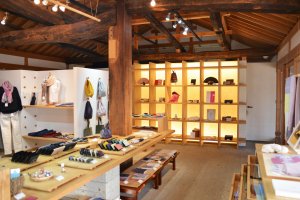
Information
Map ( Directions )
Explore nearby

Yuiichi Festival
By Tom Roseveare

Yuki's Traditional Silk-Weaving
By Elysse Hurtado

Zen Coffee and Cup Café

Shaved Iced at Cafe Symphony
Top articles.
- Recommended

Anime Museums in Tokyo

Sapporo Beer Opens New Brewery in Tokyo’s Ebisu

Guide to Golden Week

Tokyo One of the World's Most Walkable Cities

2024 Grand Sumo Tournaments

Kurobe Unazuki Canyon Route to Link with Tateyama Kurobe Alpine Route

Haneda Airport Ranked World's Cleanest

Valley of Witches: a New Ghibli Park Attraction

Mount Omuro

Two New Demon Slayer Attractions Are Opening at Universal Studios Japan

Guide to Bringing Medicines Into Japan

Your Name: Real-Life Locations in Tokyo

Sanja Matsuri

Hachiko Statue in Shibuya

Japanese Urban Legends

Daikoku Car Meet

Iwatayama Monkey Park

Shibuya Crossing

Guide to Suica Cards
More from this category.
By Ignatius Koh

5 Spirited Away Locations You..
By Serena Kim

Hamamatsu Festival

5 Floating Torii Destinations..
Join the discussion.

Let us know how we can help.
Help us improve JapanTravel.com
We welcome any suggestions regarding this content. Your feedback is confidential and will be used to help improve this page.
Suggest an edit
https://en.japantravel.com/ibaraki/a-day-trip-to-yūki-ibaraki/43061
Thank you for your support!
Your feedback has been sent.
I have read and agree to the Privacy Policy
Ibaraki Highlights
Ibaraki’s top 8 fall foliage spots: enjoy splendid views near tokyo.
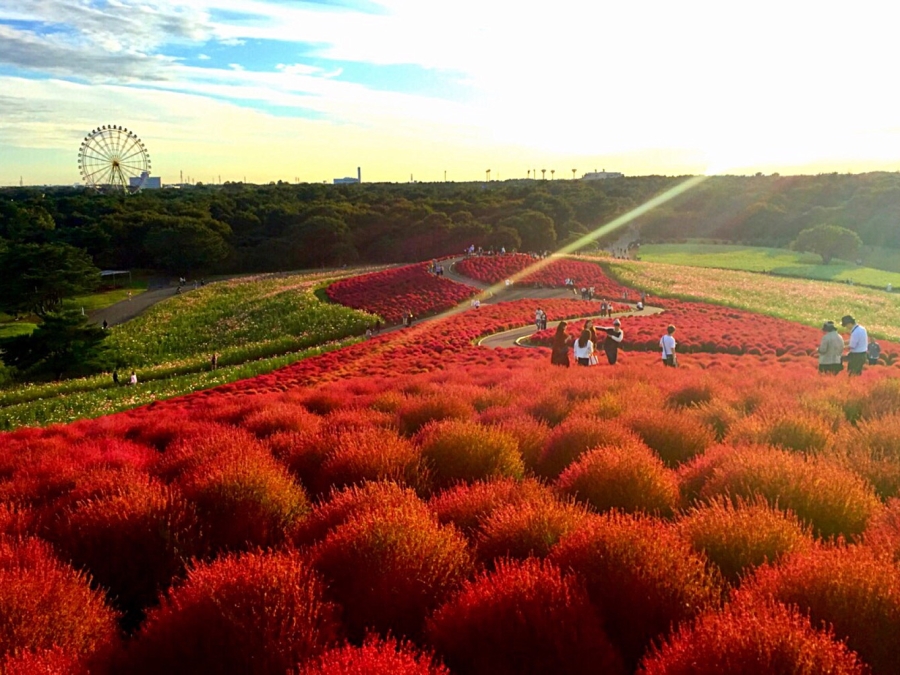
Ibaraki Prefecture, accessible by day trip from Tokyo, is a famous destination for autumn foliage. This article introduces eight splendid autumn foliage spots in Ibaraki―from popular attractions like Hitachi Seaside Park and Fukuroda Falls to Ryujin Suspension Bridge, where adventure seekers can experience a 100-meter-high bungee jump.
Excellent Access From Tokyo! Enjoy Autumn Foliage Amidst Ibaraki's Beautiful Nature
During the fall, the leaves of the trees turn red and yellow. Alongside the cherry blossoms, autumn foliage is one of the popular seasonal charms in Japan.
If you want to see the fall foliage, it’s best to enjoy it amidst beautiful natural surroundings—away from the hustle and bustle of the city. With that in mind, Ibaraki is easily accessible from Tokyo by day trip and offers many famous locations for autumn foliage.
This article introduces Ibaraki’s best locations to enjoy the autumn foliage.
While the peak season for viewing autumn foliage may vary depending on the specific location, generally speaking, November is the best time to see the leaves in the greater Tokyo area, including Ibaraki. Notably, on weekends and national holidays, these popular foliage spots tend to be quite crowded with Japanese visitors. To fully enjoy the beauty of the foliage in a relaxed atmosphere, we recommend visiting on a weekday.
Using the above map as a reference, find a spot that’s easily accessible for you!
1. Ryujin Suspension Bridge (Northern Ibaraki)
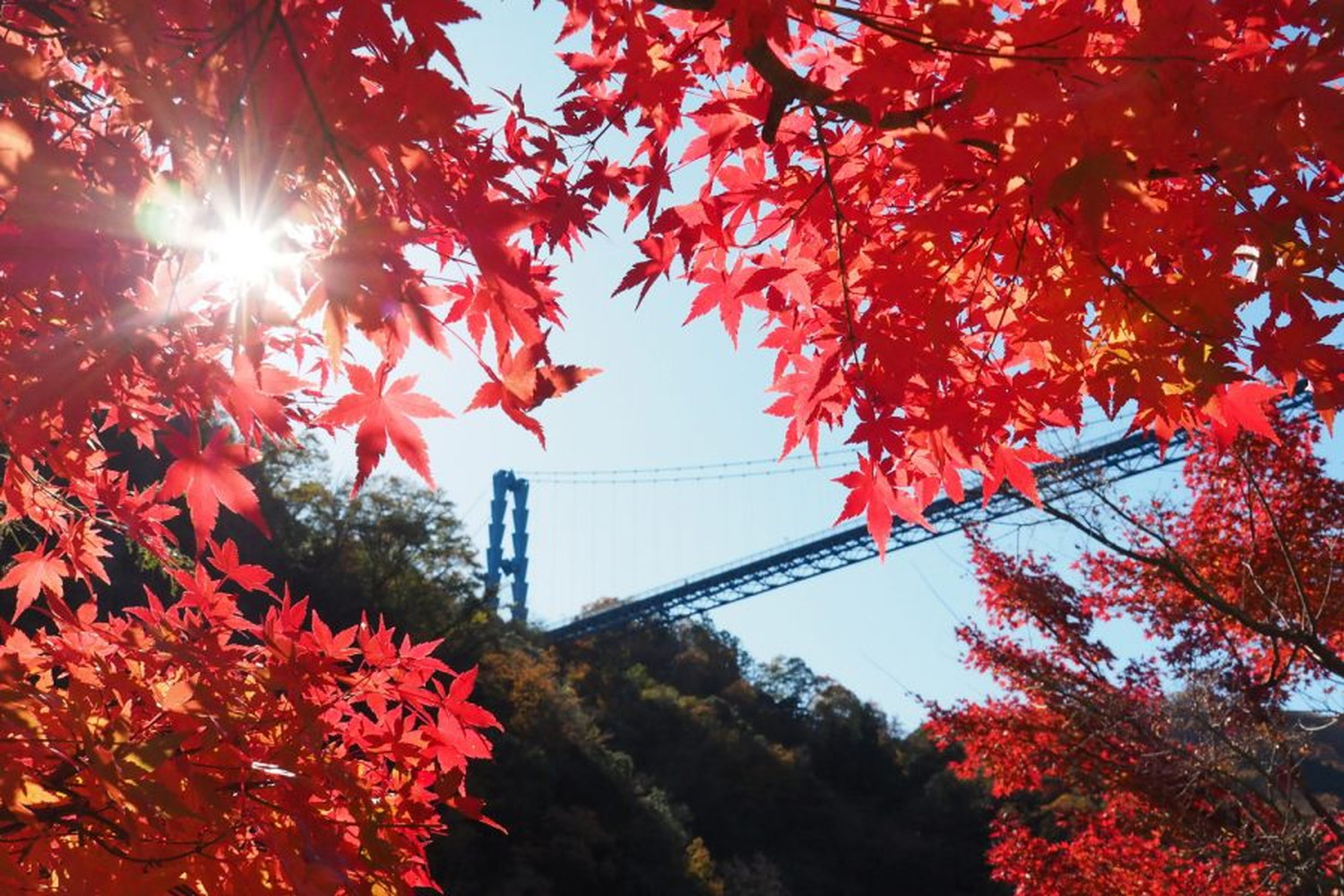
The Ryujin Gorge is a deep, V-shaped valley located in the Okukuji Prefectural Natural Park. Ryujin means Dragon God in the Japanese language. At the origin of this name is a legend about a pair of dragons that lived here in ancient times. Also, when seen from above, the river winds through the gorge in a dragon-shaped-like manner.
The Ryujin Suspension Bridge extends 375 meters between the two towers at its opposite ends. It’s the third-longest pedestrian-only bridge in Japan.
In November, the Ryujin Gorge and the surrounding mountains are beautifully dyed in bright red and yellow hues. The spectacular scenery created by the autumn leaves, gorge, and bridge can be enjoyed from various places. One of the best vantage points is the terrace at Ryujin Cafe, built on a steep cliff in the gorge.
The Ryujin Suspension Bridge is also famous for thrill-seekers to enjoy a 100-meter bungee jump (the second highest in Japan). When you attempt this challenge during autumn, the feeling is akin to diving among colorful autumn leaves. Visitors can also ride a canoe or boat while gazing at the gorge’s stunning autumn foliage and small waterfalls.
Autumn foliage season is also the perfect time to enjoy a regional specialty known as Hitachi Aki Soba, a traditional buckwheat noodle dish. You can try it at local restaurants in the town of Ryujin Gorge, Hitachiota City.
Information
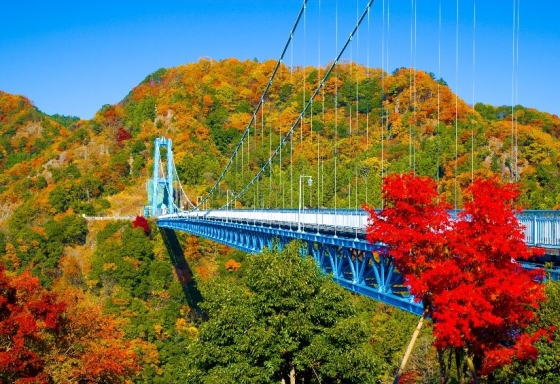
Ryujin Suspension Bridge
Ryujin Suspension Bridge stands 100 meters above the Ryujin Dam Reservoir. Spanning 375 meters, the bridge is inspired by the legend of a dragon said to reside in the Ryujin River. It offers panoramic views of the area’s mountainous landscape, including wild cherry blossoms during the spring and fiery foliage in autumn. The bridge is also home to Japan’s highest bungee jump! This bungee jump is the ultimate way to take in the surrounding mountains if you're up to the challenge. If throwing yourself off bridges isn’t your thing, there’s plenty more to explore in the surrounding area as well, including hiking trails, hot springs, and restaurants serving the region’s specialty: soba noodles!
2. See Kochia at Hitachi Seaside Park (Central Ibaraki)

In the Tokyo area, the kaede maple trees, momiji maple trees, and ginkgo trees―famous for their beautiful fall foliage―change color in November. However, people who can’t visit Japan in November don’t need to worry! In October, you can already enjoy the fall foliage in Ibaraki.
Hitachi Seaside Park is well known as a spectacular spot for viewing the blue Nemophila flowers in the spring. It’s also a unique fall foliage destination. Red kochia bushes, highlighting autumn at Hitachi Seaside Park, begin changing color in early October and are at their peak in mid-October. They take on a golden hue in late October, making it especially feel like autumn.
The kochia has a refreshing green color in the summer, pleasing the eye. However, the red kochia covering the hillside like a carpet during fall is genuinely breathtaking. If you can’t visit Japan in November, why not visit the kochia in October?
The shops and dining facilities within Hitachi Seaside Park offer kochia-inspired sweets during this time of the year. These desserts are truly worthy of sharing on social media!
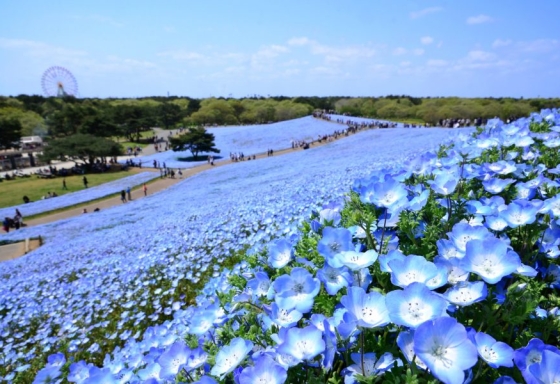
Hitachi Seaside Park
Hitachi Seaside Park is perhaps Ibaraki's most famous tourist destination for its Instagram-friendly fields of flowers. This vast park is best known for the stunning blue nemophila flowers in spring (mid-April onwards) and bright red kochia bushes in autumn (October). There's plenty to see year-round, including daffodils, tulips, sunflowers, and oil-seed rape blossoms. In addition to flowers, it is home to a small amusement park and traditional Japanese farmhouses. Once inside, visitors can enjoy a stroll, rent a bicycle, or ride the Seaside Train to get around. The park is entirely wheelchair accessible. Moreover, Hitachi Seaside Park is located close to other destinations such as Aquaworld Aquarium, Nakaminato Fish Market, and Kairakuen Park. In other words, it's easy to plan a one or two-day trip to all of these major sites!
3. Fukuroda Falls (Northern Ibaraki)
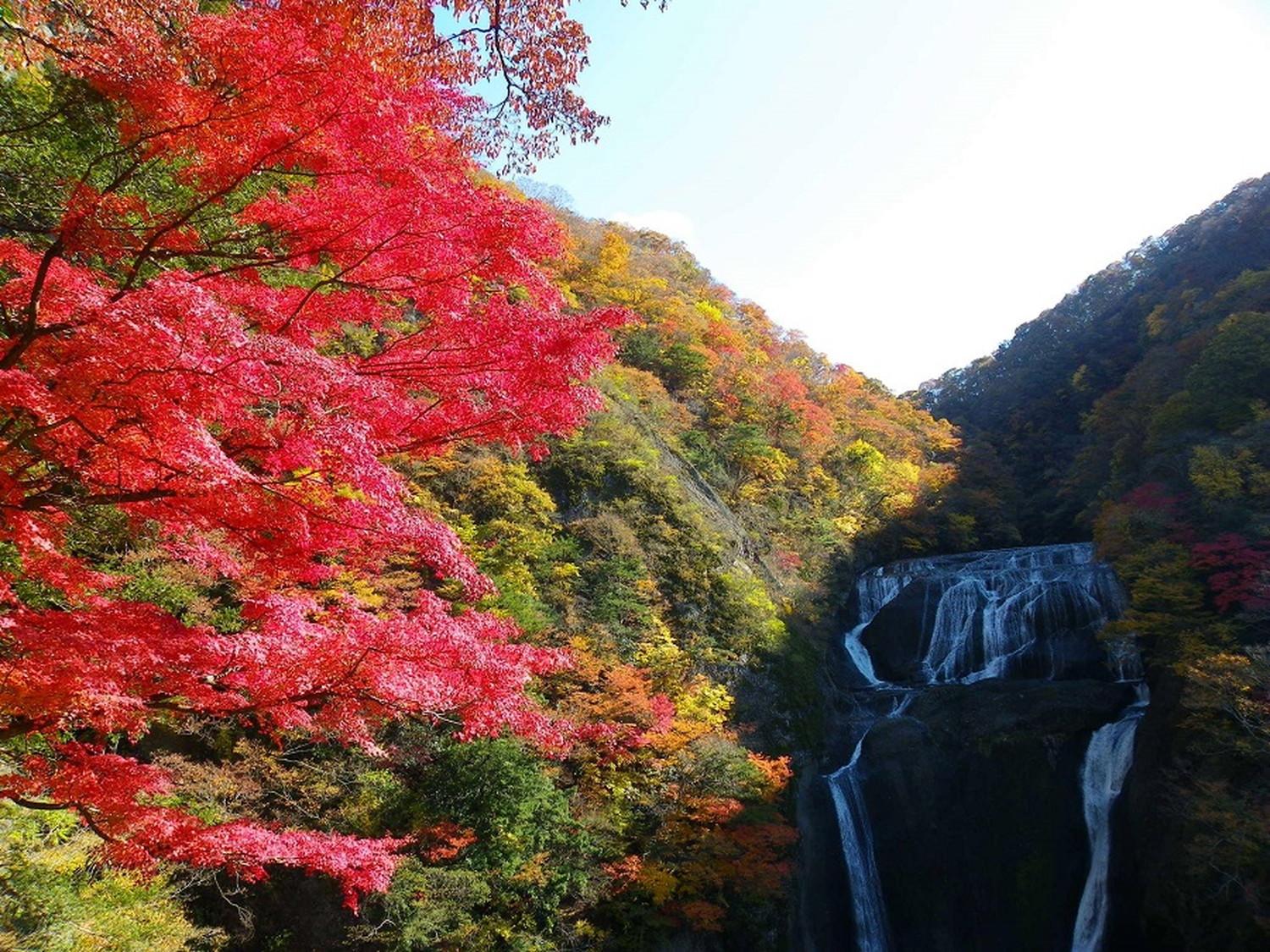
Fukuroda Falls, located in Daigo Town, is a popular tourist attraction in Ibaraki. Along with Nikko’s Kegon Falls, it’s ranked as one of Japan’s Three Great Waterfalls.
The waterfall is quite impressive – it’s 120 meters tall and 73 meters wide. It is also known as “Yodo Falls” due to the water cascading down a rock face that has four tiers.
Fukuroda Falls is surrounded by kaede maple trees and Japanese chestnut oak trees (kunugi). From early to mid-November, the area is colored by bright red and yellow hues. A variety of waterfall scenes can be enjoyed from Observatory One and Observatory Two, the latter of which has three viewing decks. The suspension bridge located beneath the falls also offers an impressive view.
Before, during, and after the autumn foliage season there are other noteworthy highlights such as the waterfall evening illumination and the tunnel leading up to the falls, lit up and beautifully decorated.
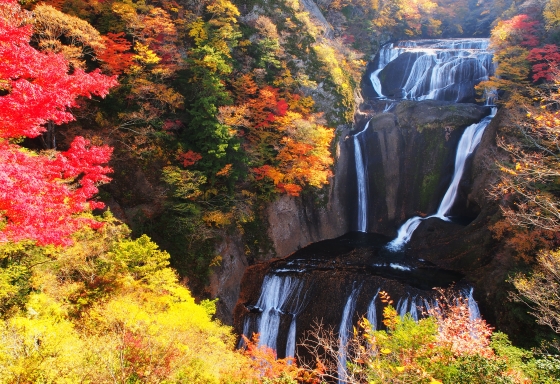
Fukuroda Falls
Fukuroda Falls is ranked among Japan’s "Three Great Waterfalls." A visit here will quickly reveal why. Water cascades over four levels of the rocky cliff face, earning it the nickname "Yondo no Taki" (four times waterfalls). In autumn, the falls are breathtaking when the fiery foliage transforms the surrounding mountains. But if you can’t make it in autumn, don’t worry! In winter, the waterfall freezes over in a stunning icy spectacle. In the summertime, the cool spray of the rushing water makes them a great place to escape the heat. The Fukuroda Falls area is where several beginner-friendly hiking trails begin. It's a great way to explore more of northern Ibaraki’s stunning mountains. If hiking isn’t your thing, head to one of the soba noodle restaurants or souvenir shops at the base of the falls. You can even sample the area’s famous apple pie!
4. Eigenji Temple: Known as Momiji-dera (Northern Ibaraki)
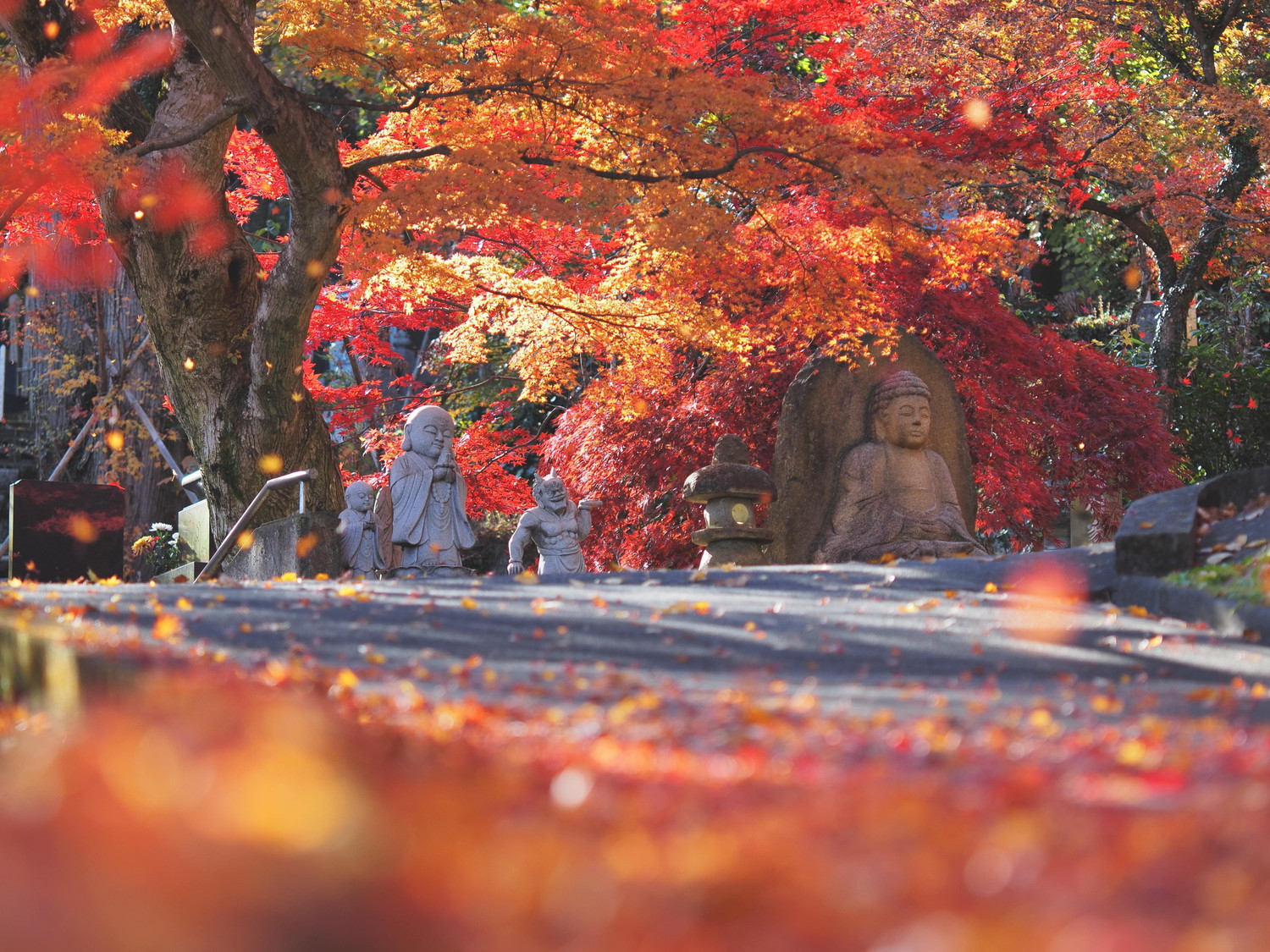
In addition to Fukuroda Falls, Eigenji Temple is also known as an autumn foliage destination in Daigo.
Eigenji, originally built in 1446, is located near Hitachi-Daigo Station. The temple is dedicated to Benzaiten, the goddess of the arts and one of the Seven Deities of Good Fortune.
About 25 years ago at Eigenji Temple, local residents and temple members began planting kaede maple trees in an effort to maintain the precincts. Every year since then, from early to mid-November, the temple precincts are filled with red and yellow leaves. As a result, the temple came to be called “Momiji-dera,” or the “Autumn Foliage Temple.”
Throughout the temple grounds, you can take stunning photos of the impressive fall foliage, together with Buddhist statues, pagodas, and temple halls.
In addition to Fukuroda Falls and Eigenji Temple, Daigo has a variety of other locations for enjoying the autumn foliage. These include Tsukimachi Falls, which allows visitors to view the falls from behind, Kotokuji Temple with its beautiful ginkgo trees, and mts. Nantai and Yamizo, which offer scenic hiking trails amid the autumn splendor. So please be sure to take in all these sights during your trip.
5. Hananuki Gorge (Northern Ibaraki)
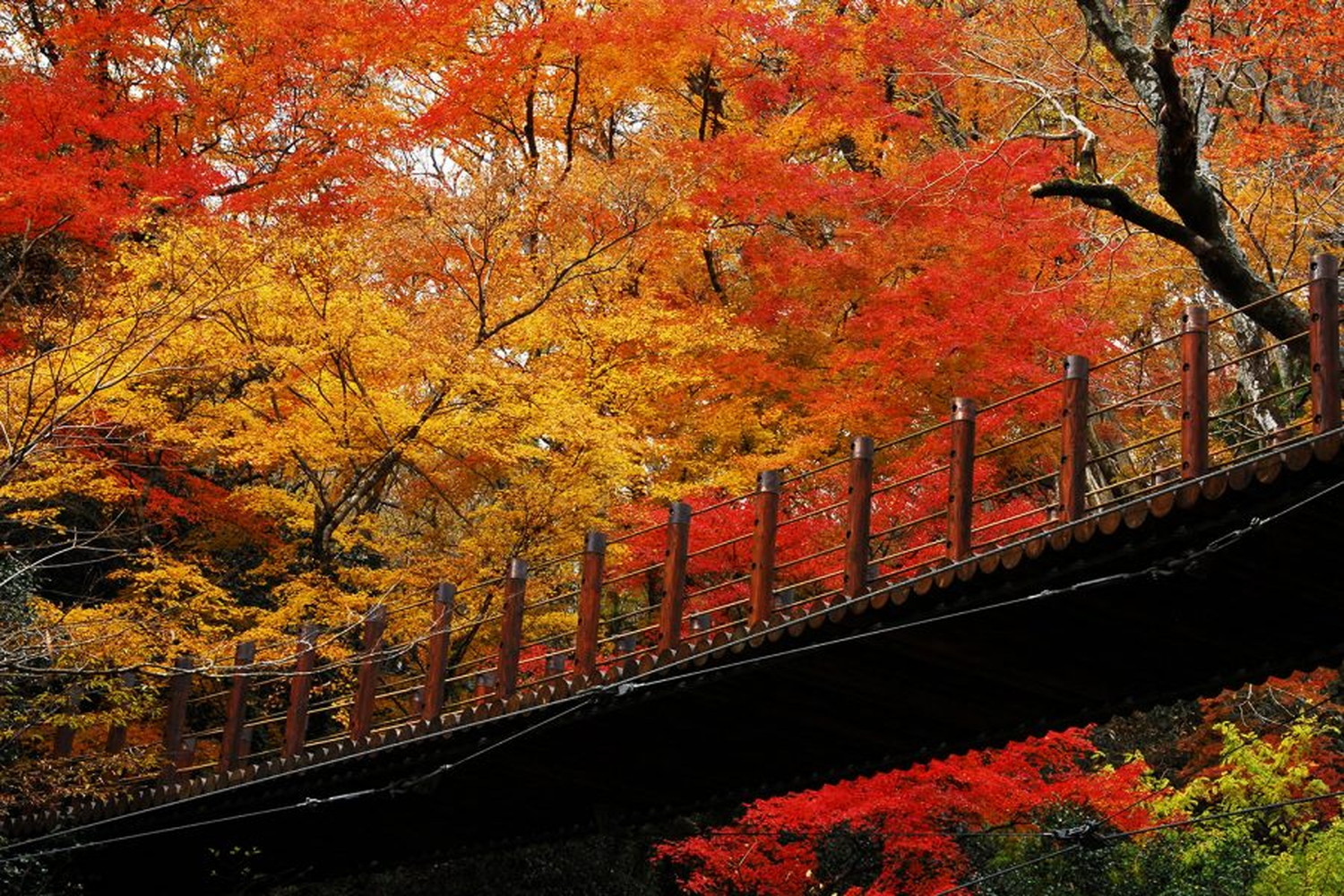
Hananuki Gorge is a well-known autumn foliage destination, about 40 minutes drive from Fukuroda Falls.
The gorge presents the photogenic 60-meter-long Shiomi Falls Suspension Bridge. The Ryujin Suspension Bridge―mentioned earlier in this article―is attractive because of the spectacular sight in which the bridge appears to be floating in the mountains. In comparison, the Shiomi Falls Suspension Bridge is smaller, but visitors can enjoy a view in which the bridge itself looks as though it’s covered in autumn leaves.
In this local area, the Hananuki Dam→Namerigafuchi→Hananuki Gorge→ Kotakizawa Campsite route is connected by a walking path. In the fall season, you can enjoy hiking while surrounded by colorful autumn leaves and beautiful natural scenery. Additionally, in the Hananuki Gorge area, there are short and comfortable walking routes for light hiking.
During the autumn foliage season from mid-November until late November, the area is illuminated at night, and there’s also the Hananuki Gorge Autumn Foliage Festival featuring various food kiosks lined up in the nearby parking lot.
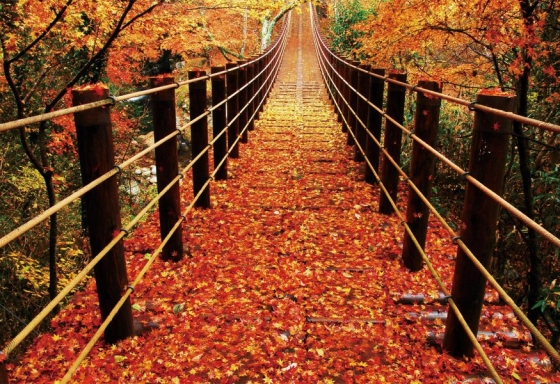
Hananuki Gorge
This scenic gorge area stretches from the Hananuki Dam to the Kotakizawa Camp Site. The gorge's most famous attraction is the stunning Shiomi Falls Suspension Bridge. There are also plenty of hiking trails for exploring the area. The best time to visit is autumn when foliage covers the area in a blanket of fiery reds and yellows. Summer is another excellent time to bask in the natural surroundings. Bring your swimwear and plunge into natural pools and streams, then relax with a barbecue or picnic at the camp area.
6. Mt. Tsukuba (Southern Ibaraki)
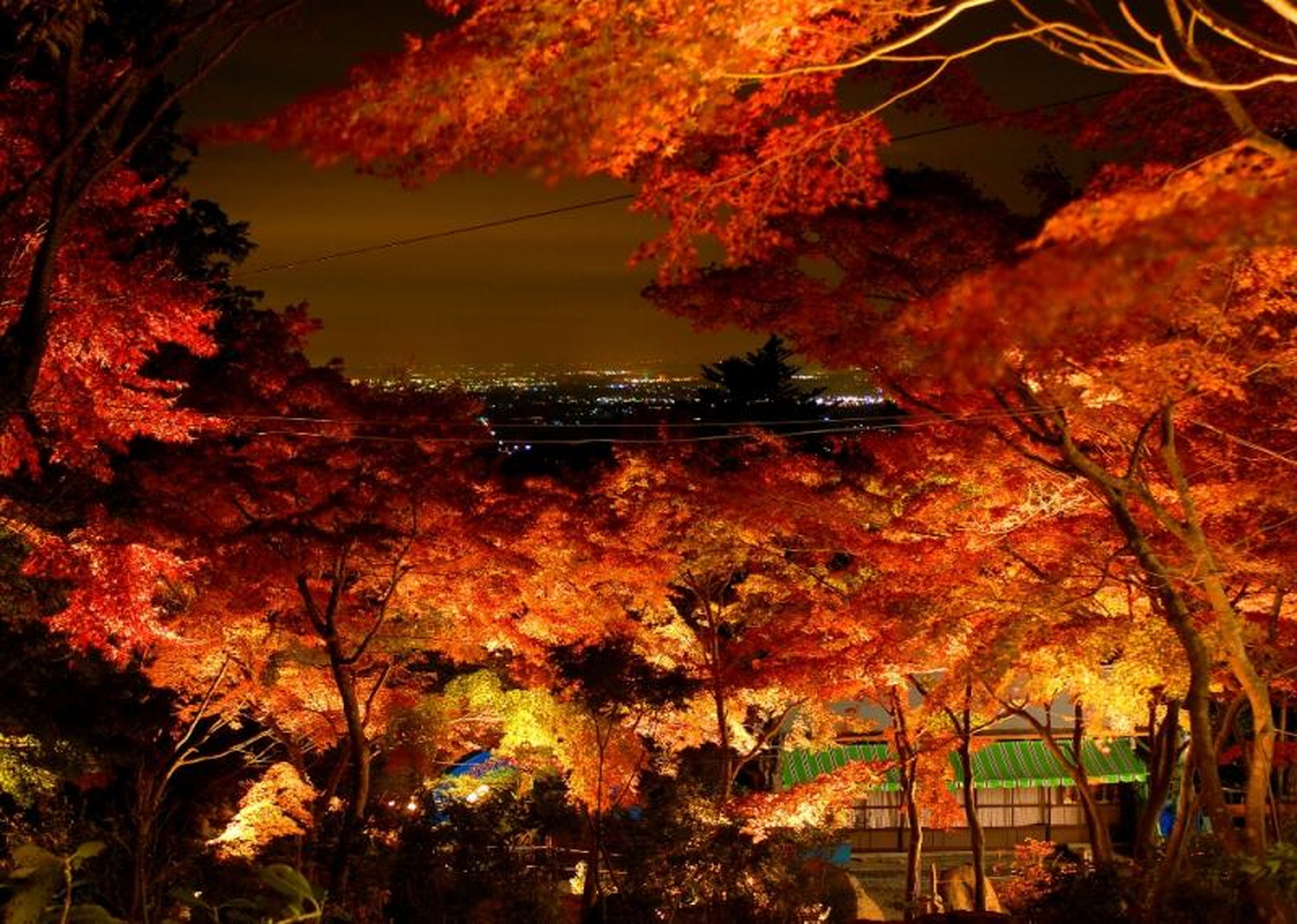
Mt. Tsukuba is one of the most popular sightseeing spots in Ibaraki. Visitors can enjoy more than 1,000 different species of plant life throughout the year, and also admire the changing colors of the ginkgo and momiji maple tree leaves.
You also don’t want to miss the amazing views from the mountain’s ropeway and cable car, in particular during the Mt. Tsukuba Momiji Festival, from the end of October until early December. During the festival the autumn foliage near the cable car’s Miyawaki Station is lit up, with the cable car offering a special evening service called “Night Cruising” on Saturdays, Sundays, and national holidays. In the third week of November―considered to be the best time for seeing the fall foliage ーthese events are held every day.
In addition, the ropeway’s “Stardust Cruising” event is also highly popular. This event is held on Saturdays, Sundays, and public holidays during autumn and winter, giving visitors unforgettable night views from Mt. Tsukuba.
We also recommend visiting Mt. Tsukuba’s Tsukubasan Shrine. During the autumn foliage season, the ginkgo trees on the shrine precincts turn a beautiful yellow color. Near the shrine, there are several hot springs that can even be enjoyed on day trips, so travelers can take respite and rejuvenate their weary selves.
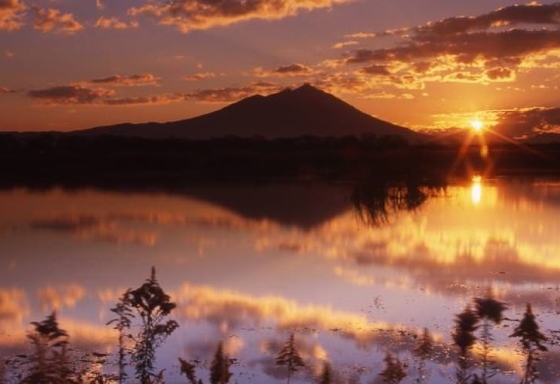
Mount Tsukuba
The twin peaks of Mount Tsukuba are symbolic of Ibaraki. In Japanese, the peaks are Nyotai and Nantai, meaning the female peak and male peak, respectively. At 877 meters tall, Nyotai, the female peak, is the higher of the two. Mount Tsukuba is accessible in under two hours from Tokyo, making it ideal for escaping city life and getting in touch with nature. There are over 1000 species of flora and fauna on the mountain alone! Both peaks are easily accessible by cable car or ropeway. If you're looking to exercise, there are plenty of hiking trails that suit all levels. Many trails have unique rock formations and historical Shinto sites. While Mount Fuji is the symbol of western Japan, Mount Tsukuba is undeniably the symbol of eastern Japan. No trip to the Kanto region is complete without exploring this mountain!
7. Kairakuen Garden: Momiji Valley (Central Ibaraki)
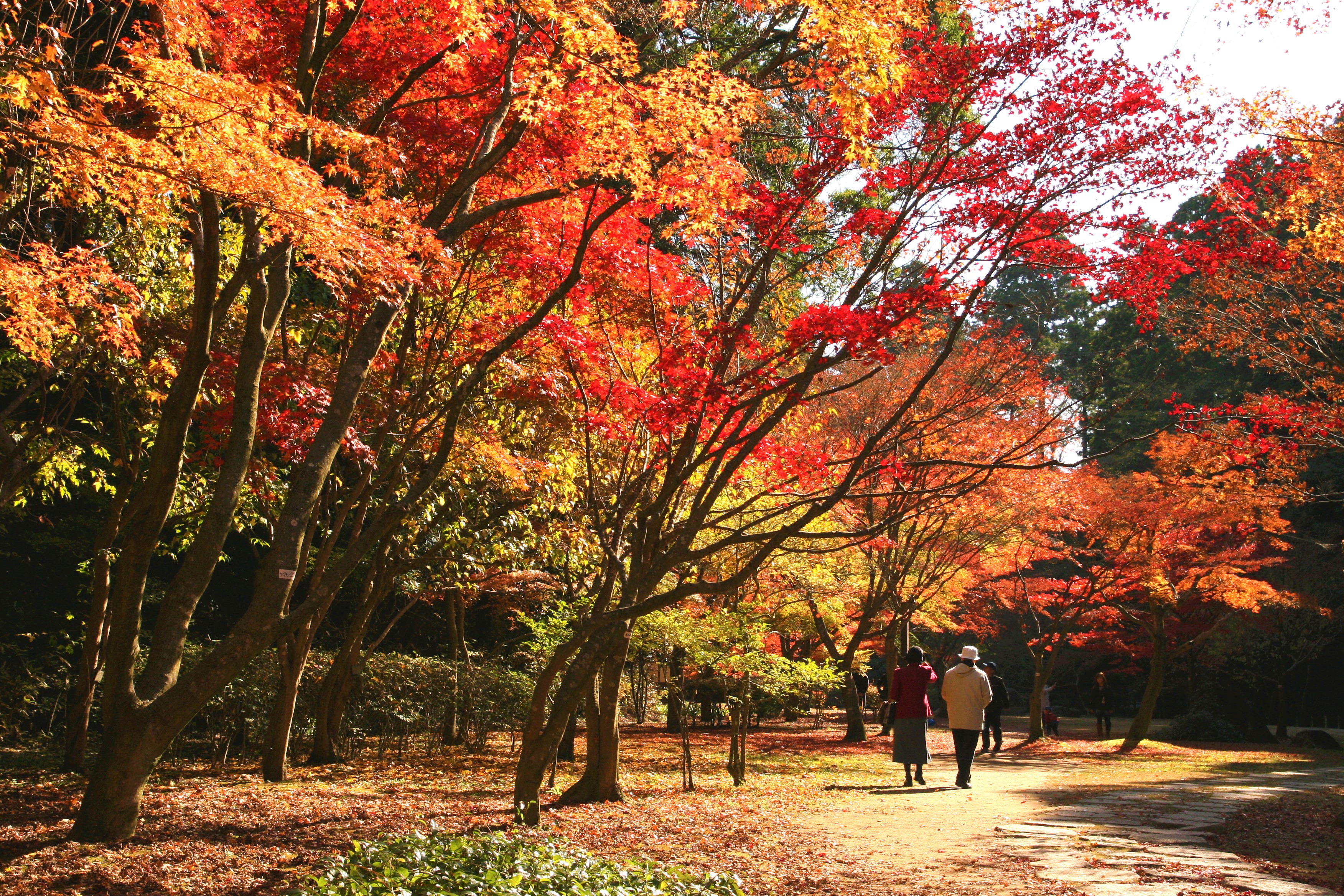
Kairakuen Garden, located in Mito, Ibaraki’s prefectural capital, is famous for being one of the Three Great Gardens of Japan. Visitors can enjoy looking at many varieties of plants in the garden, plum trees and their blossoms being one of the major highlights.
Momiji Valley (Momiji-dani) is an area on the west side of Kairakuen Garden. During the fall season, the foliage of about 170 kaede and momiji maple trees changes into many beautiful colors. From early to mid-November the area gets illuminated at night, and the ensuing magical scenery spreads out right in front of visitors.
You can also enjoy the sight of cherry tree leaves changing into their brilliant fall colors from the promenade that surrounds Kairakuen Garden’s neighboring Lake Senba. We highly recommend going for a leisurely stroll here.
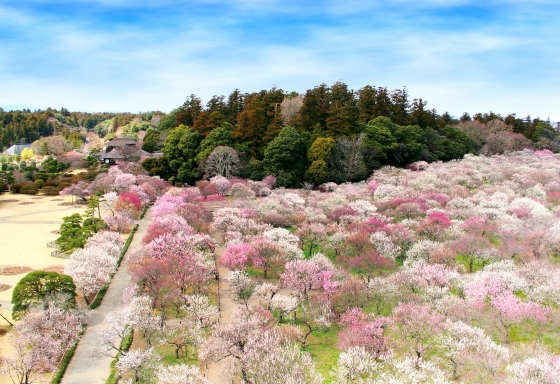
Kairakuen Garden
Kairakuen Garden is ranked among Japan’s top three most beautiful gardens, alongside Kenrokuen in Kanazawa and Korakuen in Okayama. The garden was established in 1842 by Nariaki Tokugawa, the ninth feudal lord of the Mito Domain. It has since served as a place of relaxation and recreation for the public. Kairakuen is famous for its Plum Blossom Festival (Ume Matsuri) held from late February to early March. It is home to around 3,000 plum trees from 100 different varieties. Cherry blossoms and azalea in the spring and Japanese bush clovers in autumn keep Kairakuen looking beautiful year-round. Website: https://ibaraki-kairakuen.jp/en/language/
8. Ibaraki Prefectural Archives and Museum (Central Ibaraki)
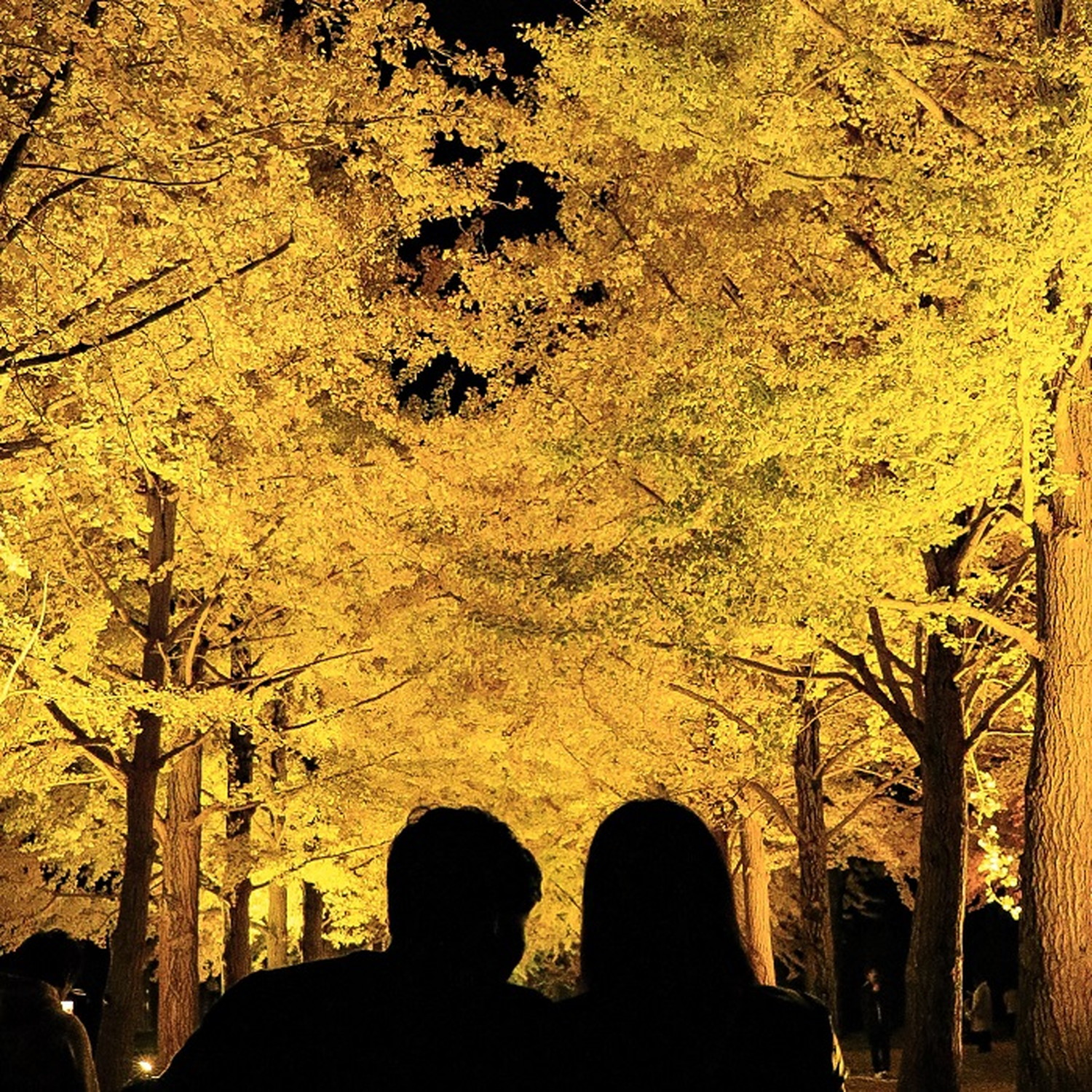
Japan has numerous fall foliage destinations, offering visitors a chance to witness the stunning red and yellow colors of kaede and momiji maple trees. Additionally, there are several popular spots with rows of ginkgo trees that turn yellow during autumn. Some of these locations also offer evening illuminations that further enhance the beauty of the trees. One such spot is the Ibaraki Prefectural Archives and Museum.
The Ibaraki Prefectural Archives and Museum is home to several historic buildings such as the former Mizukaido Elementary School main building that was constructed in 1881, and also the former Mogi Family Residence, believed to have been built in the first half of the 18th century. Kairakuen Garden is also close by, so you can see both attractions on the same day.
On the museum site there is a row of gingko trees extending for about 100 meters. The best time to take in the fall scenery is from early to mid-November when the fallen leaves form an exquisite golden carpet over the entire area.
Along with the nighttime illuminations taking place at this time of the year, visitors can enjoy decorations with traditional Japanese lanterns as well as projection mapping.
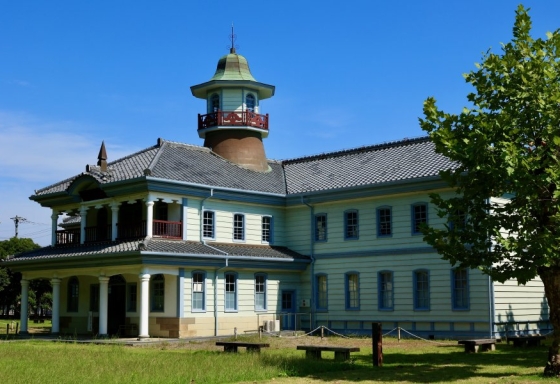
Ibaraki Prefectural Archives and Museum
The Ibaraki Prefectural Archives and Museum (Mito City) was established in 1974. Permanent exhibits showcase the history of Ibaraki from ancient times to the present day. The museum itself is housed on a plot spanning 72,000m2. This formerly was a residence during the Edo Period (1603–1868) and later a Western-style school building from the Meiji Period (1868–1912). During autumn, the museum grounds are fantastic to see bright yellow ginkgo trees, a seasonal highlight in Japan.
Head to Ibaraki to Enjoy Autumn Foliage and Tasty Cuisine
During the fall season in Japan, you can enjoy more than just the beautiful autumn leaves. Ibaraki is renowned for its exquisite seasonal delicacies such as Hitachi-Aki soba, hoshi-imo (dried sweet potatoes), chestnuts, persimmons, pears, apples, and an array of fruits. You have the opportunity to indulge in these delectable treats that are a feast for both your eyes and taste buds.
Check out the links below if you’re interested in topics related to this article.
- Fukuroda Falls, Hot Springs, and More! Nature Travel in Daigo, Northern Ibaraki
- Great Access From Tokyo! 7 Amazing Shrines and Temples in Ibaraki
- Hiking Near Tokyo! Mt. Tsukuba: Highlights, Hot Spring Inns, and More
- Hitachi Seaside Park in Spring: Enjoy the Stunning Sight of Nemophila!
See More Posts
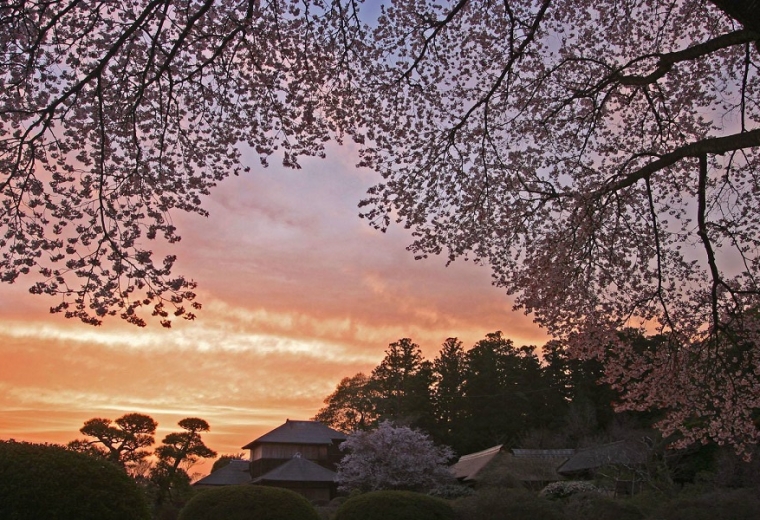
Close to Tokyo! 9 Magnificent Cherry Blossom Spots in Ibaraki
There are many attractions in Ibaraki Prefecture, near Tokyo, including Kairakuen, one of Japan's three most famous gardens. In Ibaraki, you will find many cherry blossom spots! This article introduces nine prominent cherry blossom spots in Ibaraki from those in the city with convenient access to places in the mountains where you can embrace nature!
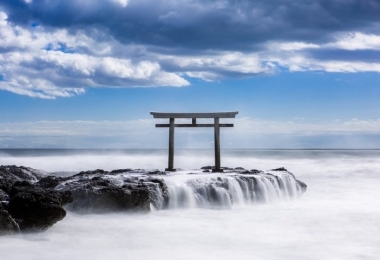
Amazing Views! 9 Picturesque Destinations in Ibaraki
Ibaraki Prefecture is a little under a two-hour drive away from central Tokyo. Home to mountains and plains and facing the ocean, Ibaraki has been nicknamed "the Kitchen of Eastern Japan" for its wide selection of fresh ingredients. What’s more, this region has an abundance of stunning natural scenery! It isn’t an overstatement to call it “a treasure trove of amazing sights.” We’ve carefully selected nine locations with enchanting views in Ibaraki for nature and photography lovers out there!
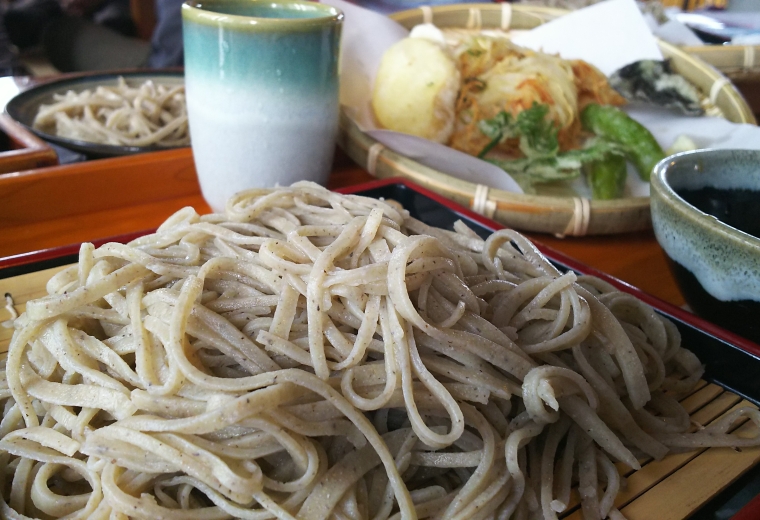
Hitachi Aki Soba Noodles, an Autumn Specialty of Ibaraki! 3 Recommended Restaurants
Hitachi Aki soba noodles, known for their rich fragrance and subtle sweetness, are a famous local food specialty in Ibaraki. The dish is in the season when autumn leaves appear, making it the perfect treat on a trip to admire the foliage. This article introduces the features of Hitachi Aki soba noodles and three recommended restaurants.

COMMENTS
2,969,770. Area. 6,096.93 km². Discover the top things to do in Ibaraki, with scenic locales like Hitachi Seaside Park, Fukuroda Falls, and double-peaked Mount Tsukuba. Visit Oarai Isosaki Shrine and nearby AquaWorld, and don't miss the giant bronze Ushiku Buddha.
17. Surfing the waves of the Pacific Ocean. Located along the Pacific Ocean, Ibaraki prefecture is also home to some of the best surfing spots in the country. Its good location makes for plenty of places to find waves that are good for surfing. Especially Oarai beach, Tokai village, and Hitachinaka.
Ibaraki: The Perfect Day Trip Destination from Tokyo. Photo by Pixta. Ibaraki is located north of Tokyo, bordering Chiba, Saitama, Tochigi, and Fukushima prefectures. It is the 11th largest prefecture in Japan, with a population of around 2.84 million. Mito City is the prefectural capital.
Ibaraki Prefecture is situated northeast of Tokyo along the Pacific coast. Ibaraki is the perfect place for an easy and convenient day trip from Tokyo which offers historical shrines, one of the finest landscape gardens in Japan, a large park with a stunning sea of seasonal flowers, and much more.
Ibaraki gets a bad rap for being Tokyo's country bumpkin neighbor, but it's precisely the prefecture's bucolic scenery that makes it such a great destination for those seeking to escape the city. It's close enough to Tokyo for a day trip, but has more than enough to explore for a long weekend or more.Here are 10 spots to visit, including our recommended places to sleep and eat.
About Ibaraki. Ibaraki Prefecture is close to Tokyo and is located between 30km and 150km northeast of the city center. Mito, the capital of the prefecture, is 100 km away. ... Mito Historical Tour Day Trip. a day trip in Mito After a history trip, enjoy shopping at the Keisei Department store. History / Traditional Crafts. 1day. View All.
Yet, Ibaraki is teeming with accomplishments, and its inhabitants have every right to brag. On behalf of this incredible prefecture I'm going to boast a bit about the top 10 things to do in Ibaraki. 1. GET A HISTORY LESSON AT KODOKAN MITO HAN SCHOOL. Living Quarters of the Tokugawa Family.
Things to Do in Ibaraki Prefecture, Kanto: See Tripadvisor's 45,446 traveler reviews and photos of Ibaraki Prefecture tourist attractions. ... By public transportation it's a nice day trip and could be combined with Hitachi Seaside Park. During plum blossom season would be the best time to visit, with special events, street food, etc. Read more ...
Top things to do in Ibaraki Prefecture. 1. Check out the famous torii gate in the Pacific Ocean. The Kamiiso-no-Torii is the outermost gate of the Oarai Isosaki-jinja shrine. The shrine was first built in 896AD, destroyed in the mid-1500s and rebuilt in 1690. The name of the gate is translated "gate at the beach of the gods," and it's ...
Ibaraki Prefecture, accessible by day trip from Tokyo, is a famous destination for autumn foliage. This article introduces eight splendid autumn foliage spots in Ibaraki―from popular attractions like Hitachi Seaside Park and Fukuroda Falls to Ryujin Suspension Bridge, where adventure seekers can experience a 100-meter-high bungee jump. ...
It is only around two hours north-east of Tokyo, and it's perfect for a day trip from Tokyo. Ibaraki is known as Japan's no.1 producer and consumer of Natto, the sticky and stinky fermented beans. It's also the birthplace of Aikido, a Japanese martial art. The most famous flower park in Ibaraki is the Hitachi Seaside Park, which is best ...
The following five places are sure to delight photography fans, couples, those with families, and nature lovers alike. 1. Ryujin Big Suspension Bridge. Ryujinotsuribashi, or Ryujin Big Suspension Bridge, is a 375-meter long bridge over a man-made lake in Ryujin Gorge, in Hitachi-ota, Ibaraki.
Things to Do in Ibaraki Prefecture, Kanto: See Tripadvisor's 45,424 traveller reviews and photos of Ibaraki Prefecture tourist attractions. ... Fortunately, it is not crowded on the day, and we do not need to queue and wait. Located about 50m high, here we can see the whole waterfall in full view and the four stages where the water flows down ...
A solo day trip one hour from Tokyo. Solo Female Travel. Ten views of Himeji Castle. Sponsored Story. A Fantastical Wetland Landscape with a Story to Tell. ... Ibaraki one day trip doable? September 2019. 3 replies. Shibukawa to Ikaho Onsen Bus Time Table September 2019. 1 reply. Hayama Marina August 2019.
The 350-hectare (865-acre) park holds flower festivals and displays throughout the year, but two seasons, in particular, stand out. In spring, 4.5 million Baby Blue Eyes (Nemophila) flowers bloom from the end of April to mid-May. Afterward, 32,000 kochia (summer cypress) plants take their spot on Miharashi Hill.
A dreamy landscape that looks straight out of a fantasy creation, this is undoubtedly Ibaraki's top touristic attraction and a great choice for a 1-day trip from Tokyo. Check out more about Hitachi Seaside Park in the following articles. Kochia Carnival at Hitachi Seaside Park Autumn. Nemophila Harmony at Hitachi Seaside Park
Cherry Blossoms along Fukuoka-zeki. One of the three largest weirs (floodgates) in the Kanto region. There are around 600 cherry trees along the approximately 1.8-kilometer walking trail. Access: 10 min. by taxi from Midorino Station on the Tsukuba Express Line.
The Fukuroda Waterfall of Daigo, Ibaraki in the Summer. The Fukuroda Falls fill the Taki River below. The water flows down from a height of 120 meters (400 feet) down and across four tiers 73 meters (240 feet) wide, which makes this waterfall one of the most sought-after destinations in Japan. Each season offers its own exclusive experience ...
From bungee jumping to space exploration, here are just five great suggestions for a one day trip to Ibaraki: 1. Jump off a suspension bridge. (image by photozou.jp) This symbolic bridge has giant blue steel towers which evoke a dragon dancing through the sky. The dragon that is illustrated on the walls is also spectacular.
Oarai in Ibaraki prefecture, with its fish market, aquarium and picturesque oceanside Japanese torii, presents the perfect opportunity for a weekend road trip with the family.
Hitachi Seaside Park (ひたち海浜公園, Hitachi Kaihin Kōen) is a spacious park near Mito in Ibaraki Prefecture featuring a variety of green spaces and seasonal flowers spread out across 350 hectares, as well as an amusement park and several cycling and walking trails.. The park's iconic flower is the blue nemophila, which covers Miharashi Hill in the spring and mimics the color of the sky.
The cost for the daily rental is JPY 2,000 for females and JPY 2,500 for males. There are a couple of recommended places to visit to learn about the history, technique and process of Yūki-Tsumugi. One is the Yūki City Traditional Crafts Center, they are open everyday from 10AM - 4PM, except Wednesdays. Here you can find a detailed overview in ...
Ibaraki Prefecture, accessible by day trip from Tokyo, is a famous destination for autumn foliage.This article introduces eight splendid autumn foliage spots in Ibaraki―from popular attractions like Hitachi Seaside Park and Fukuroda Falls to Ryujin Suspension Bridge, where adventure seekers can experience a 100-meter-high bungee jump.